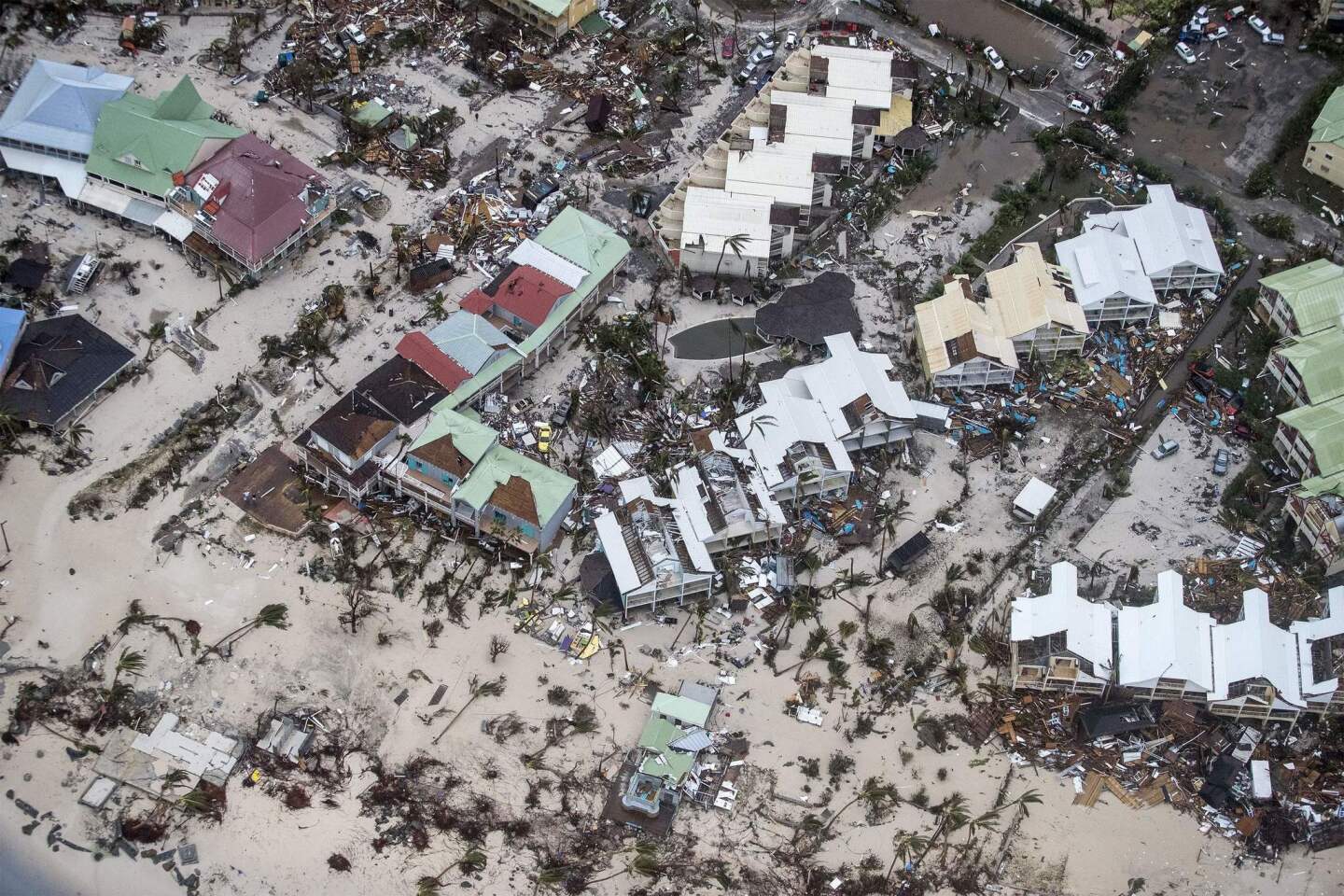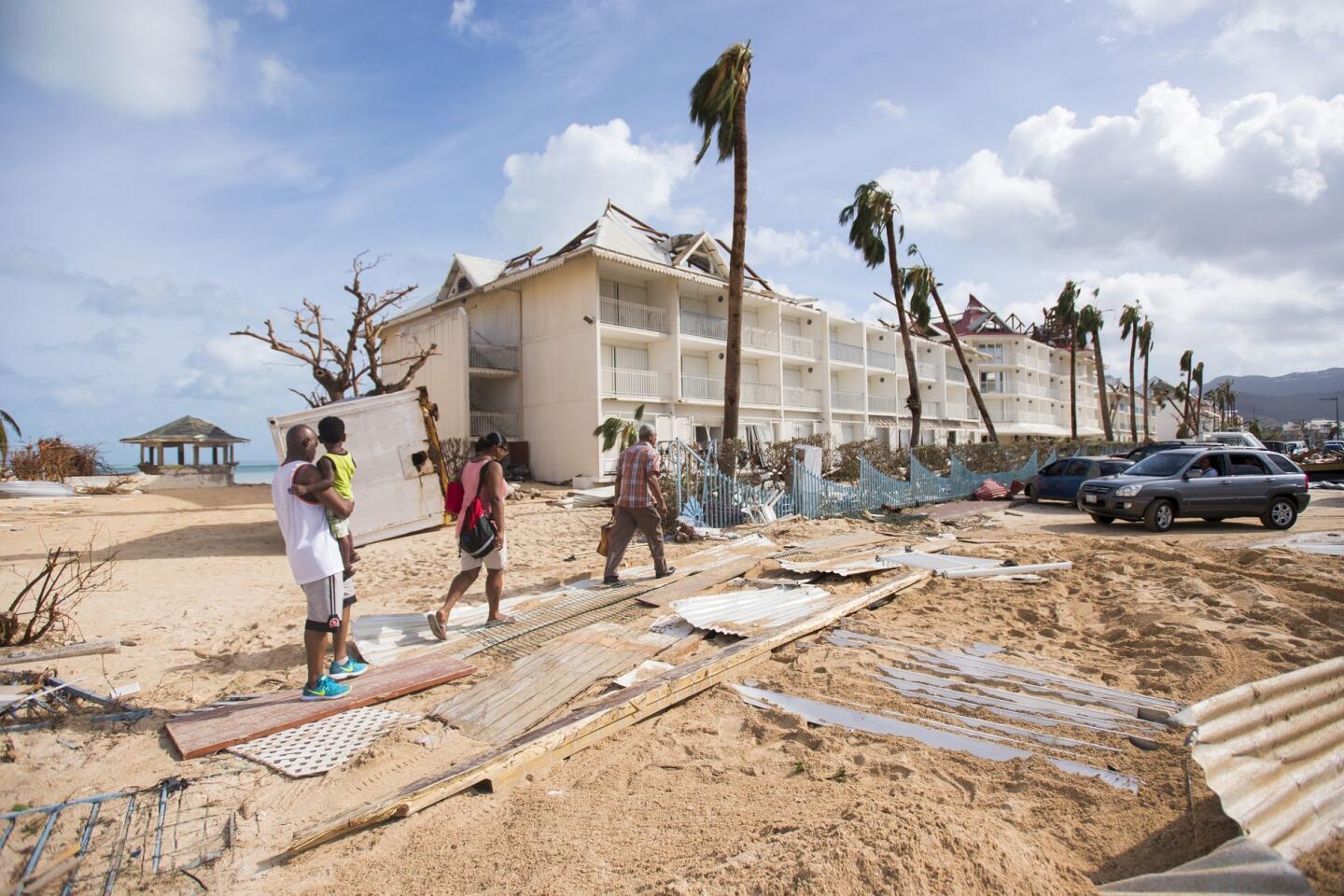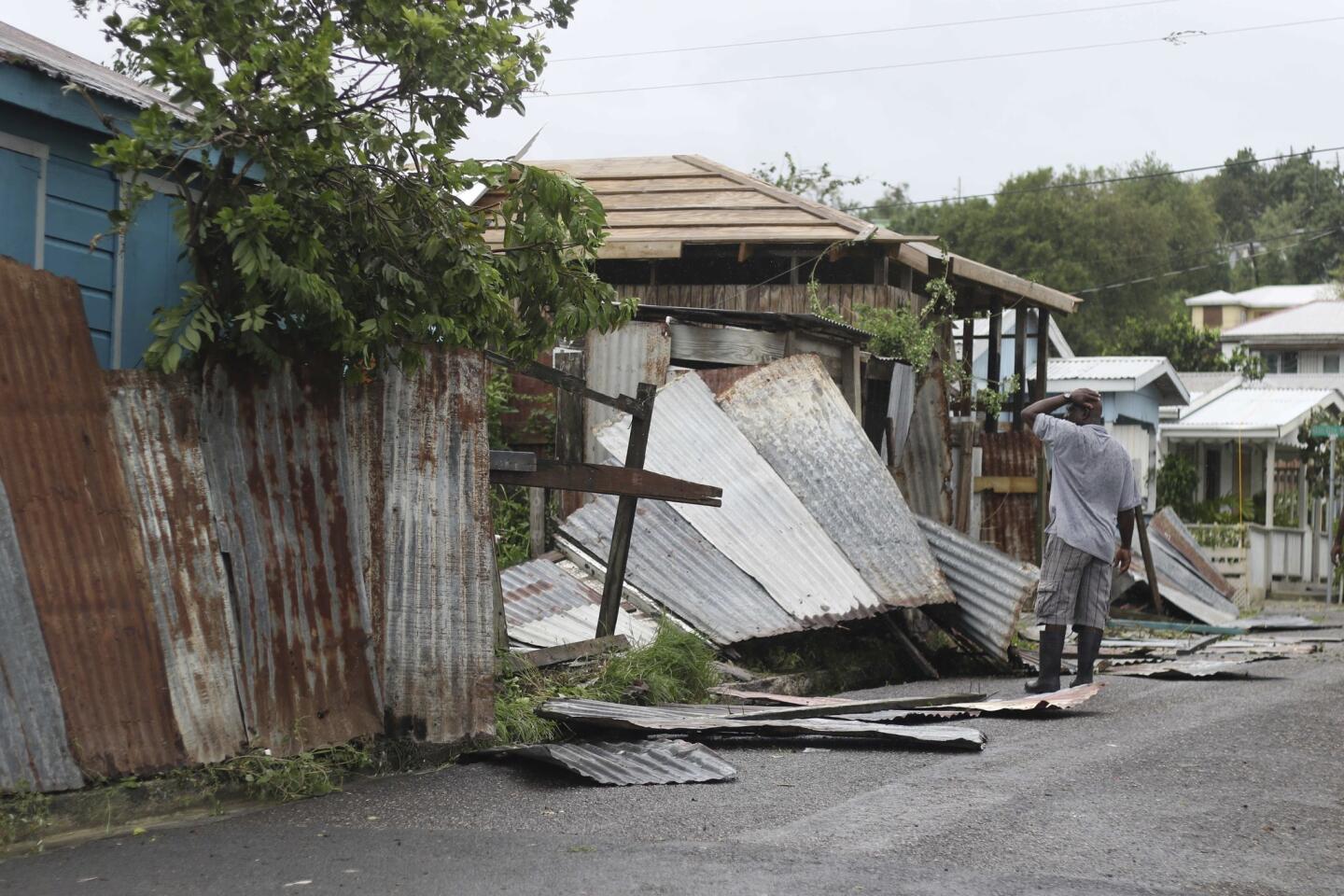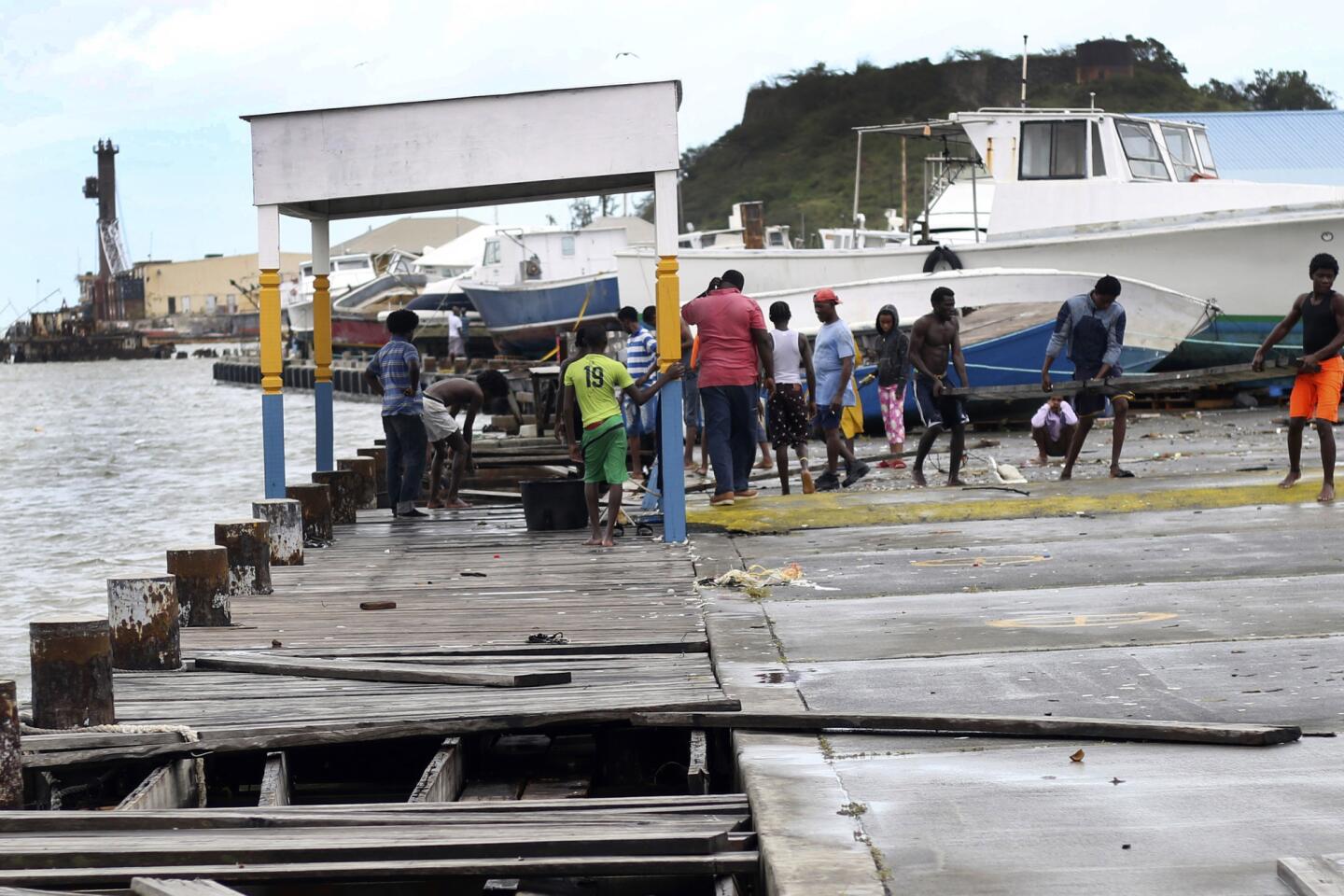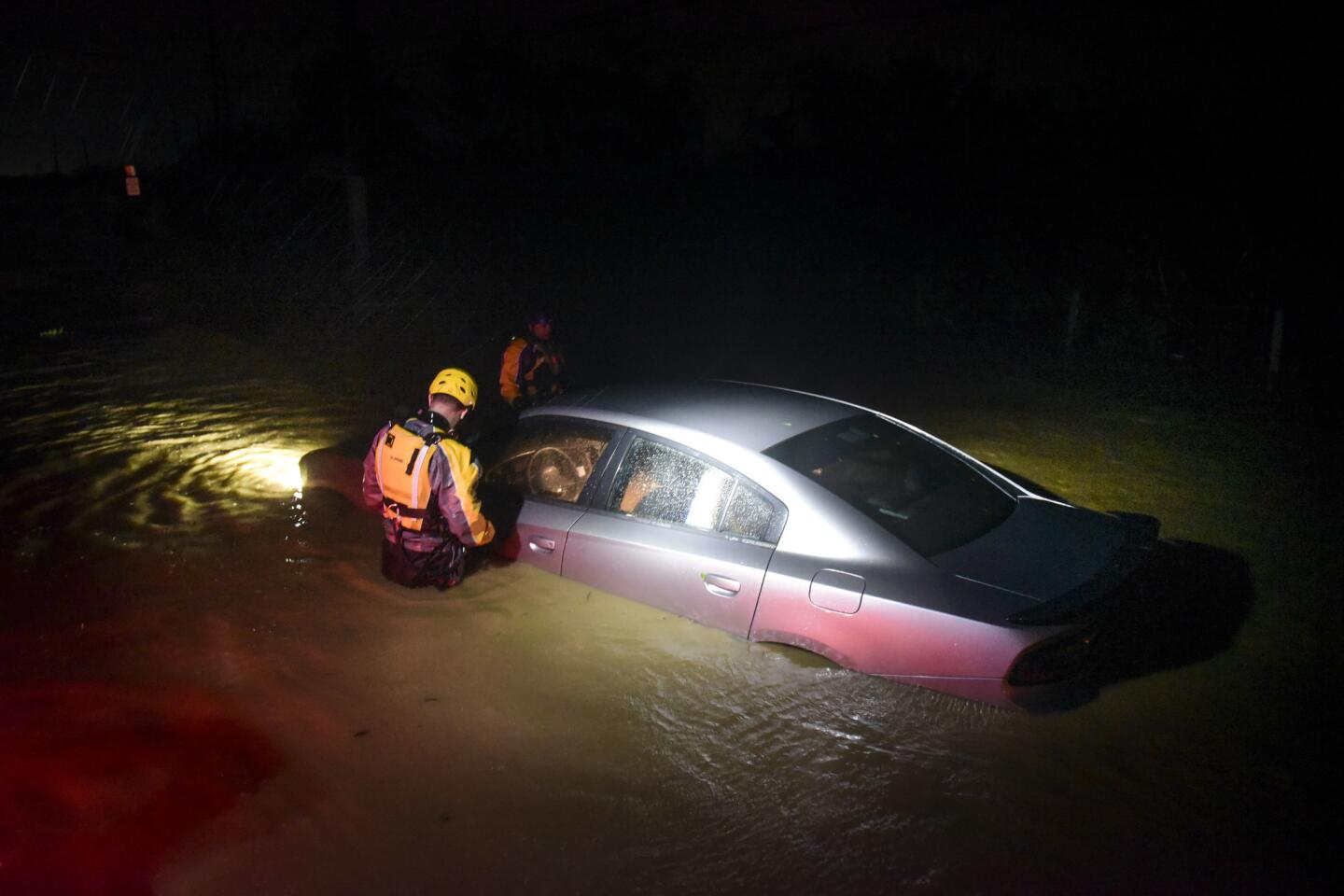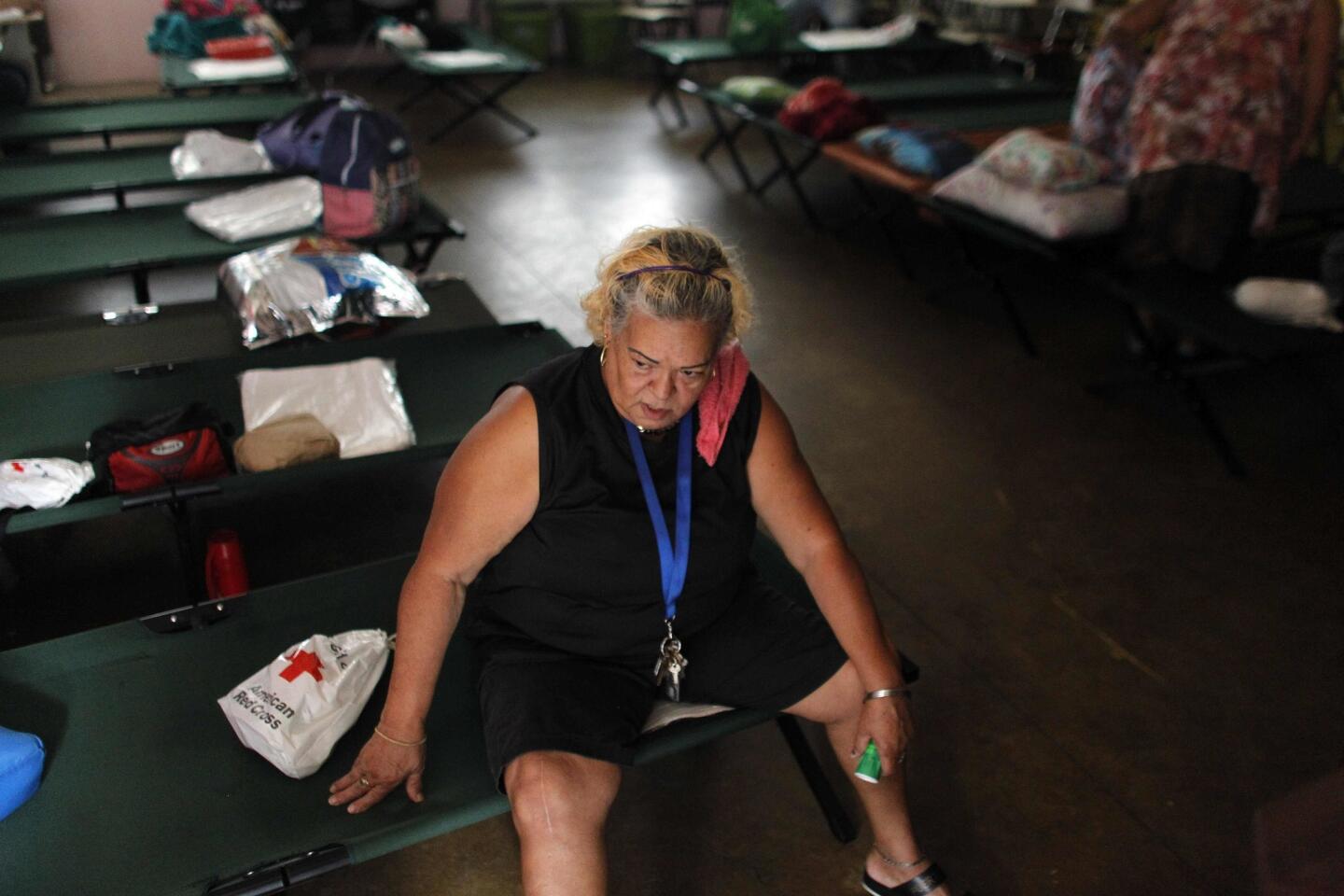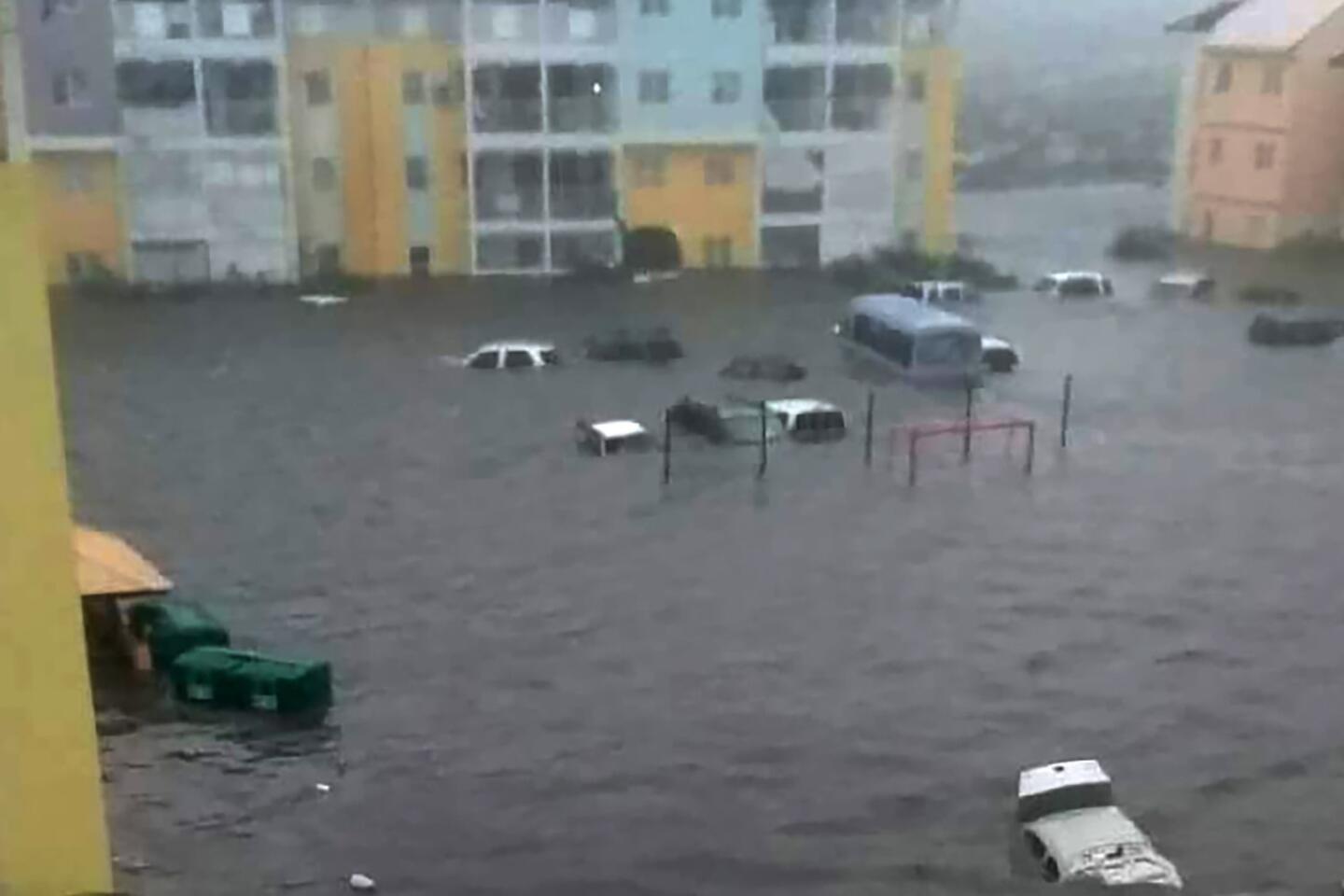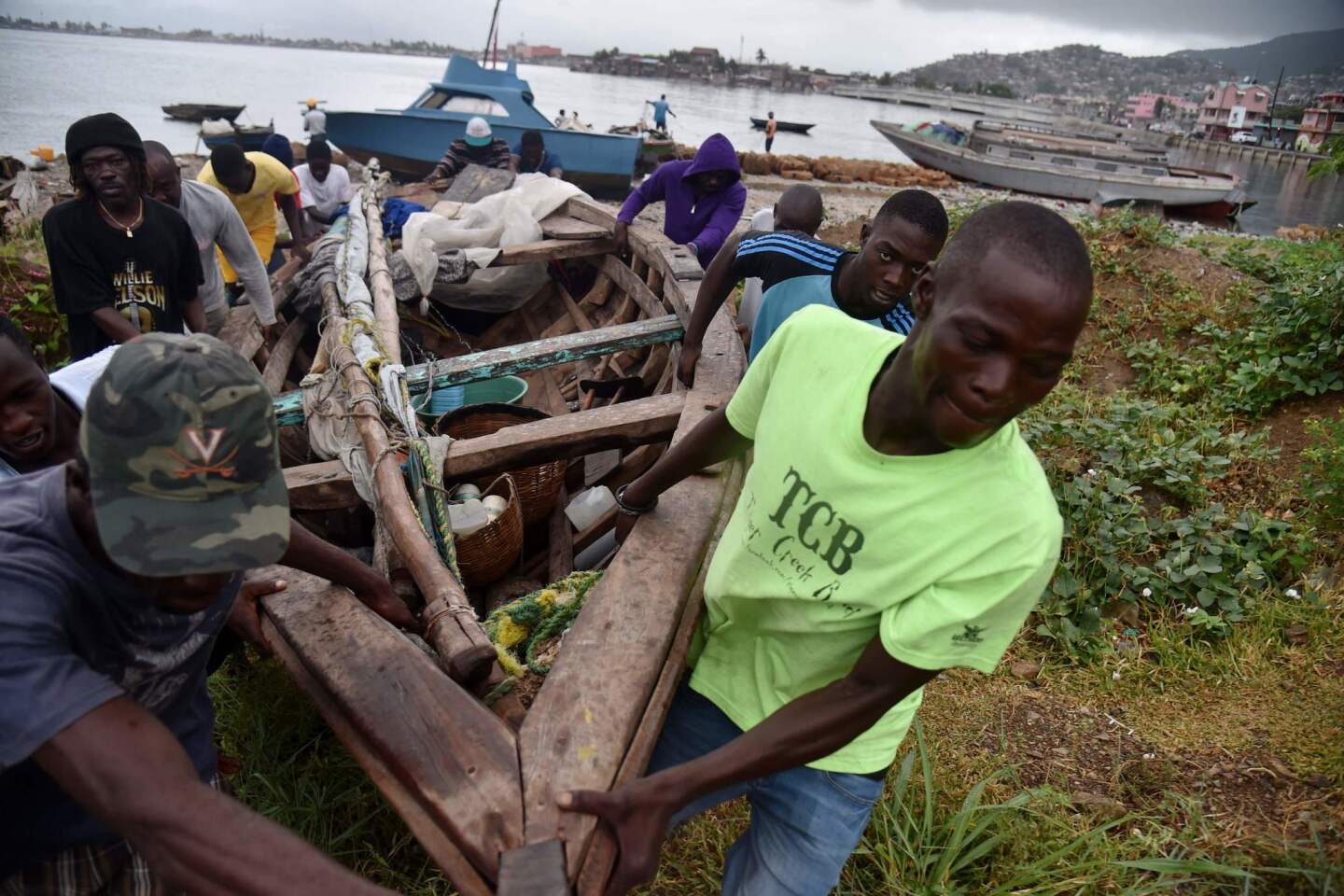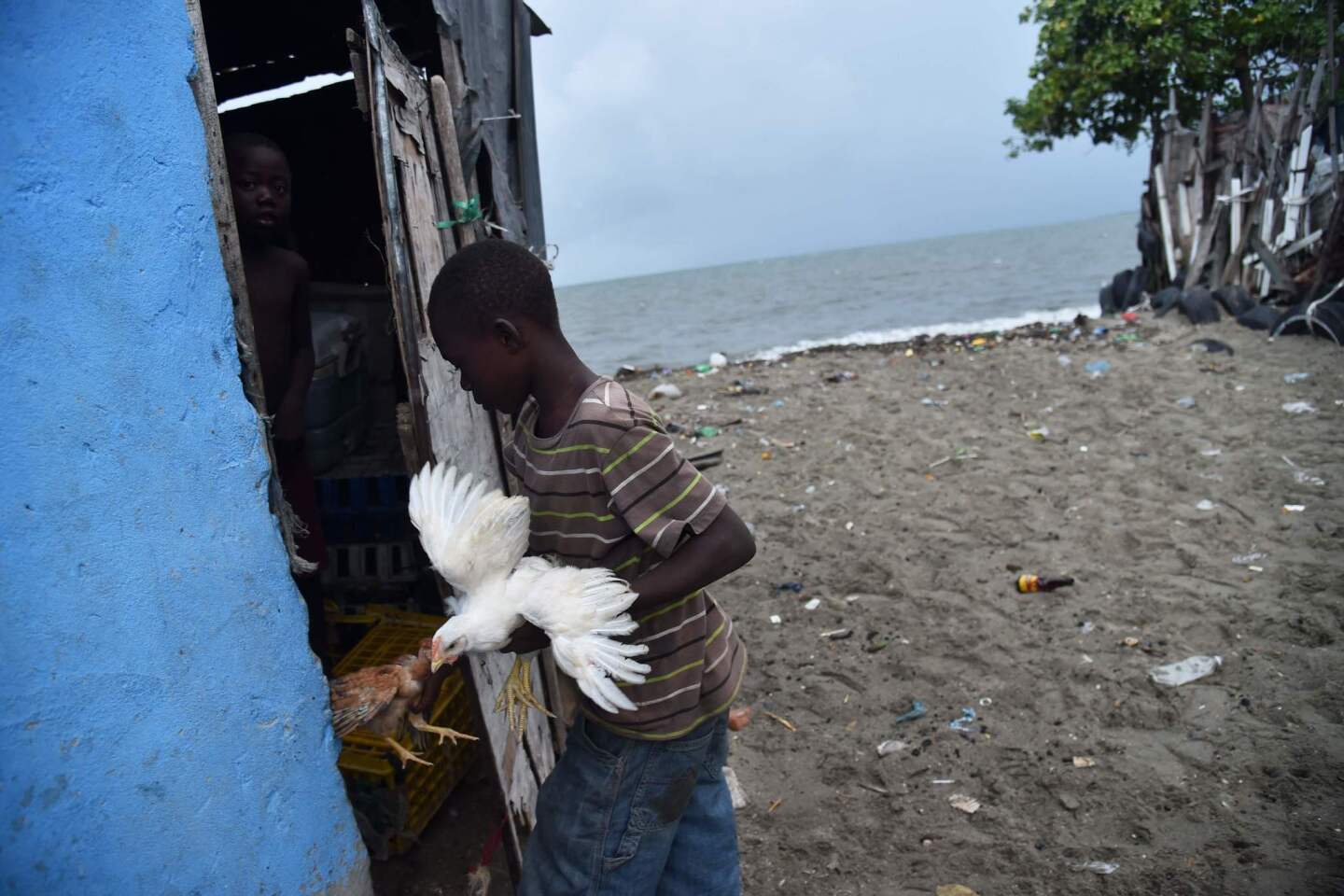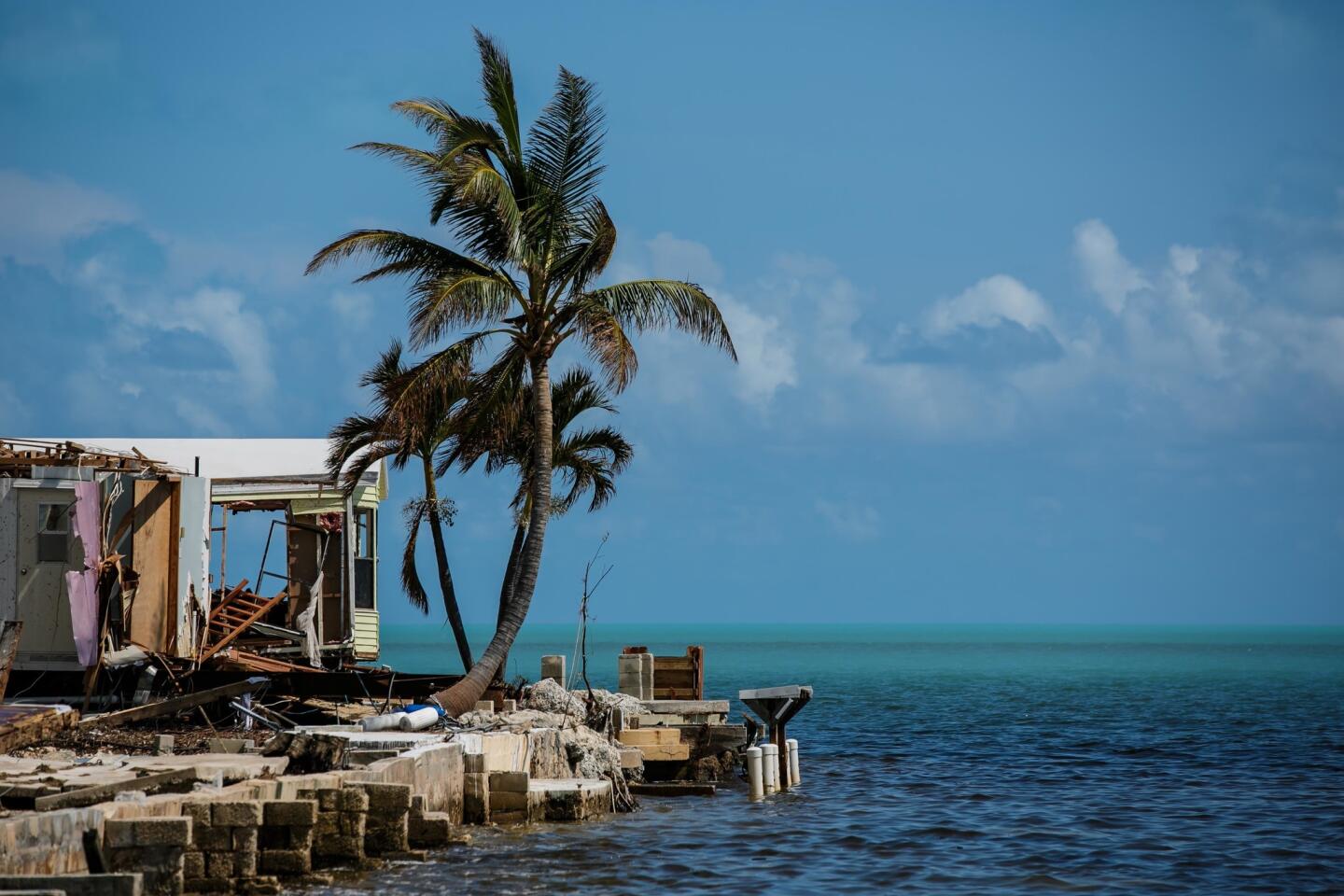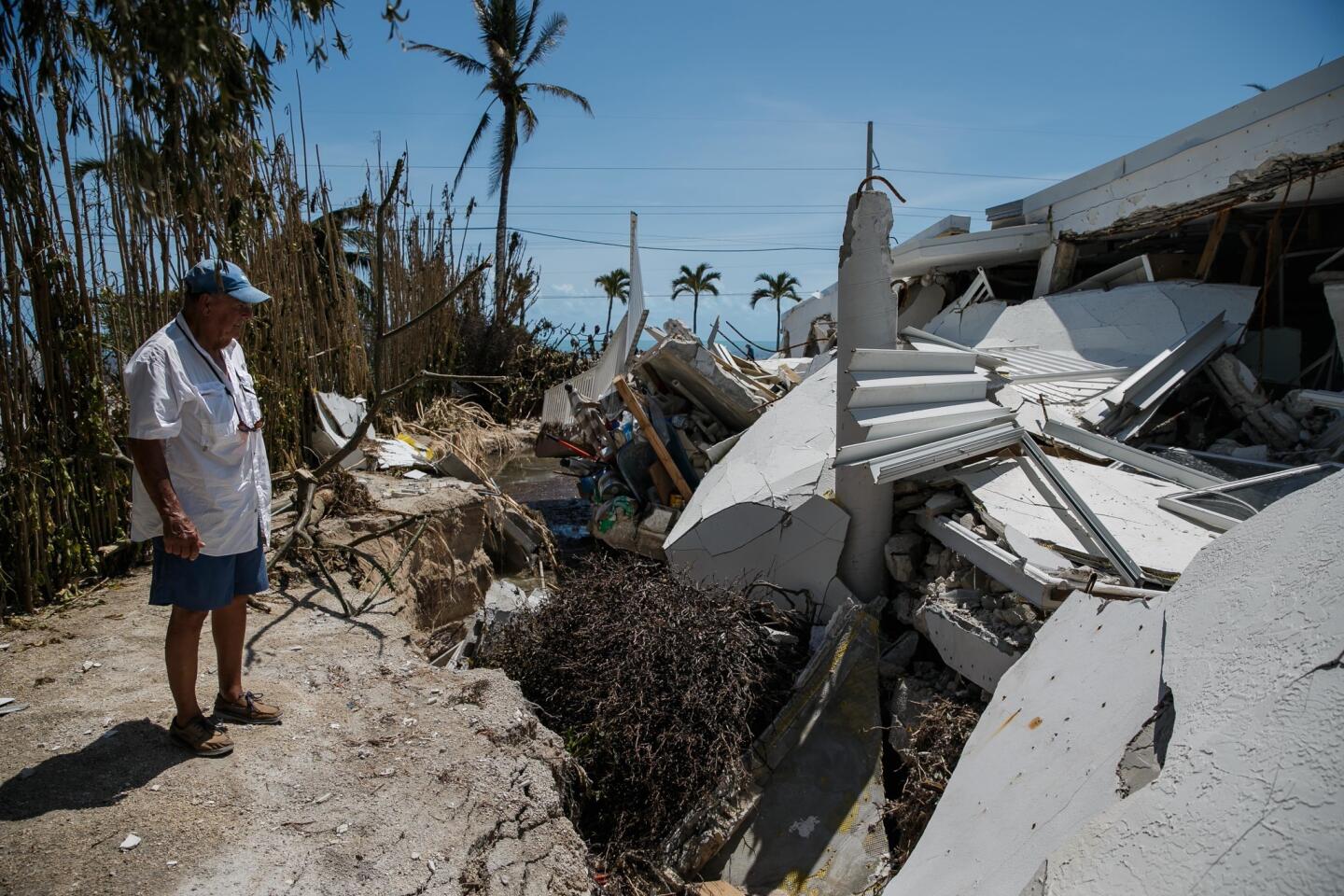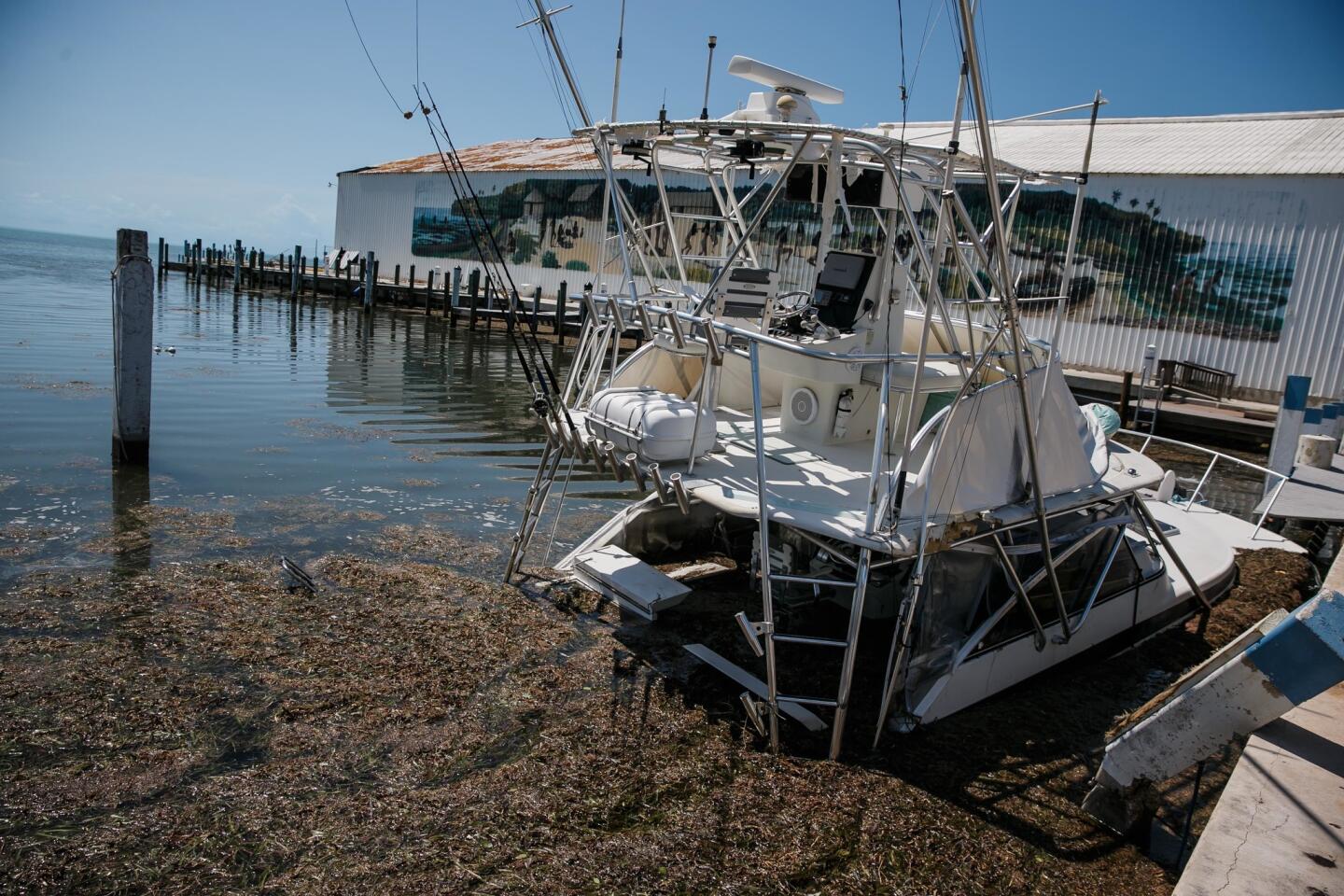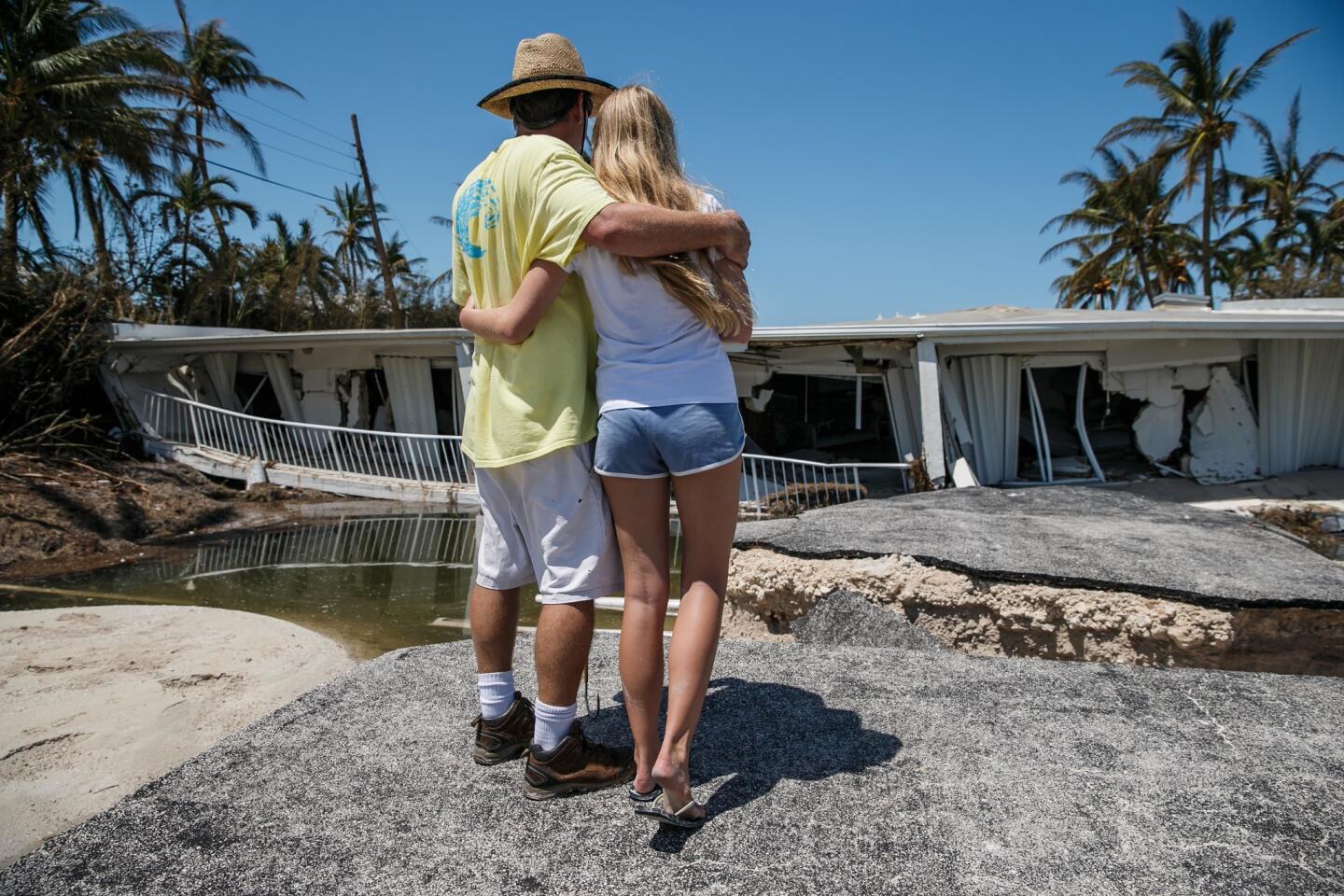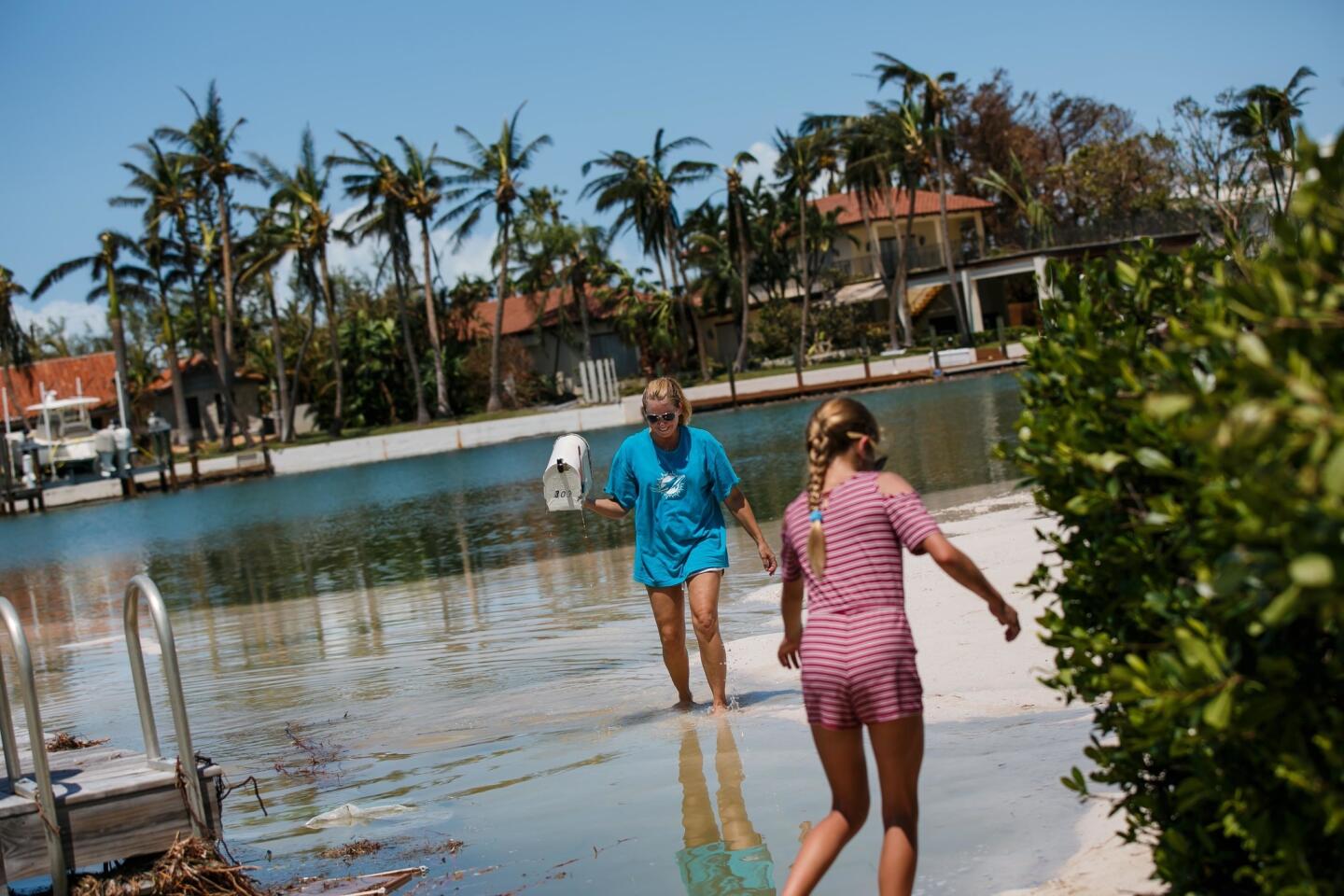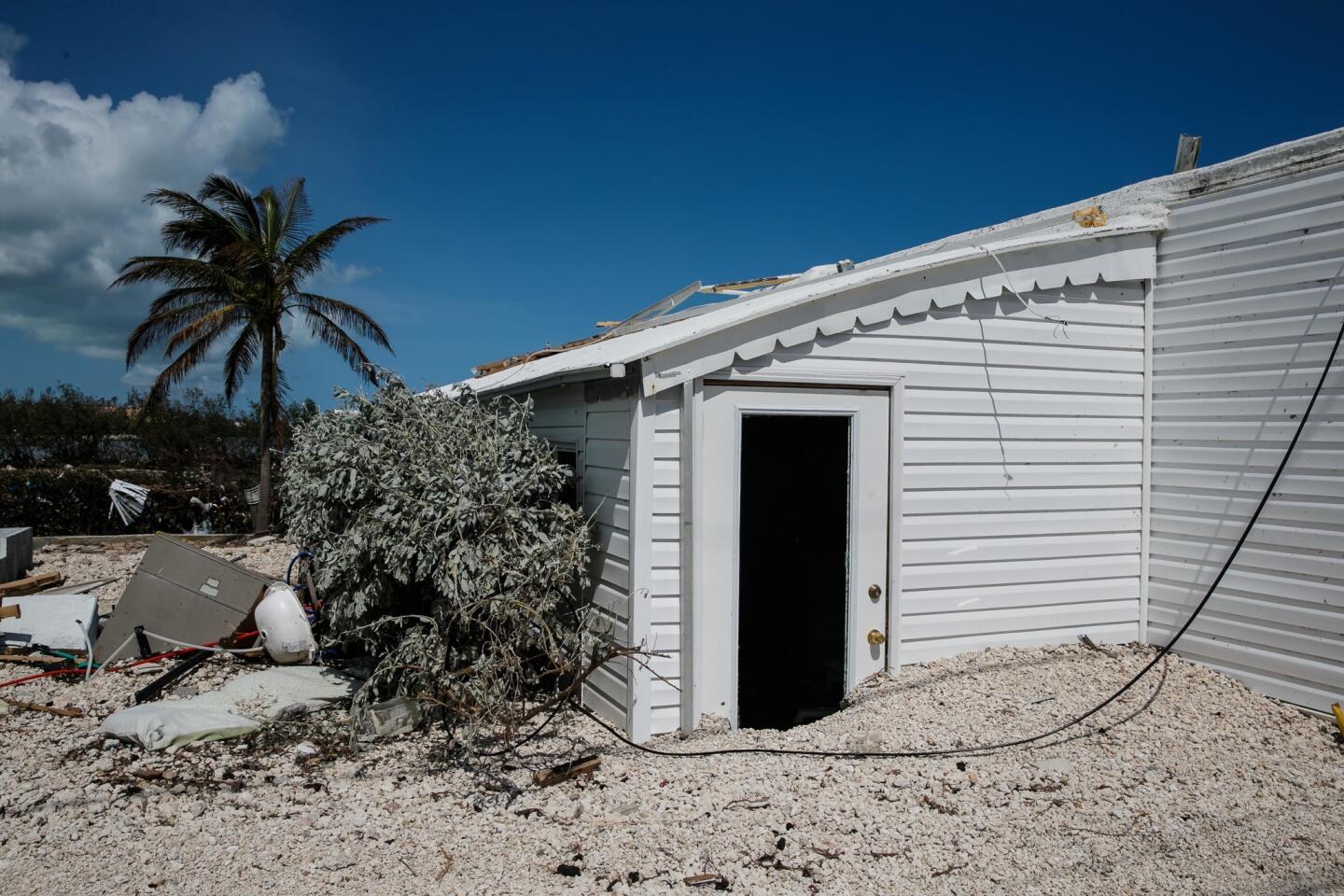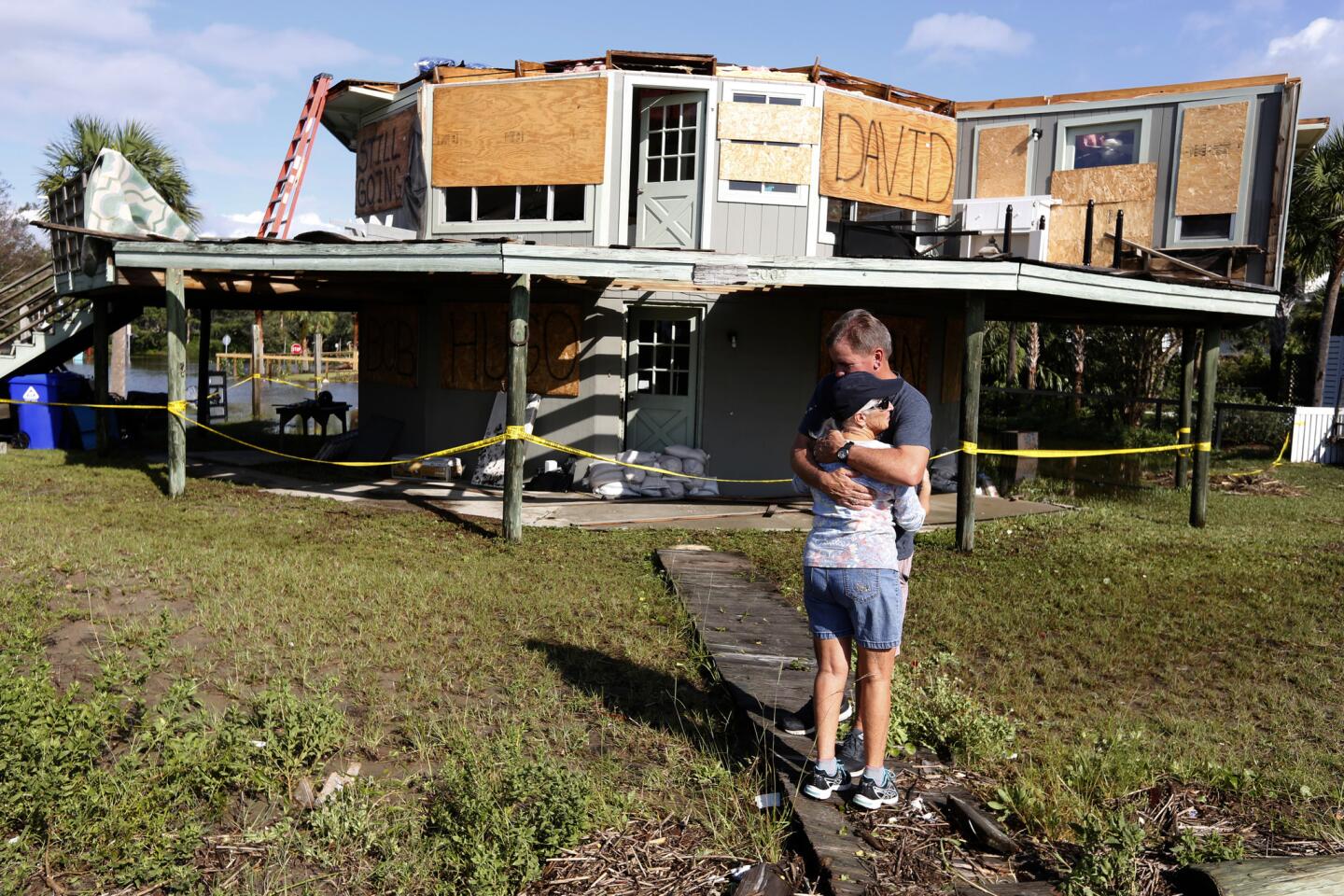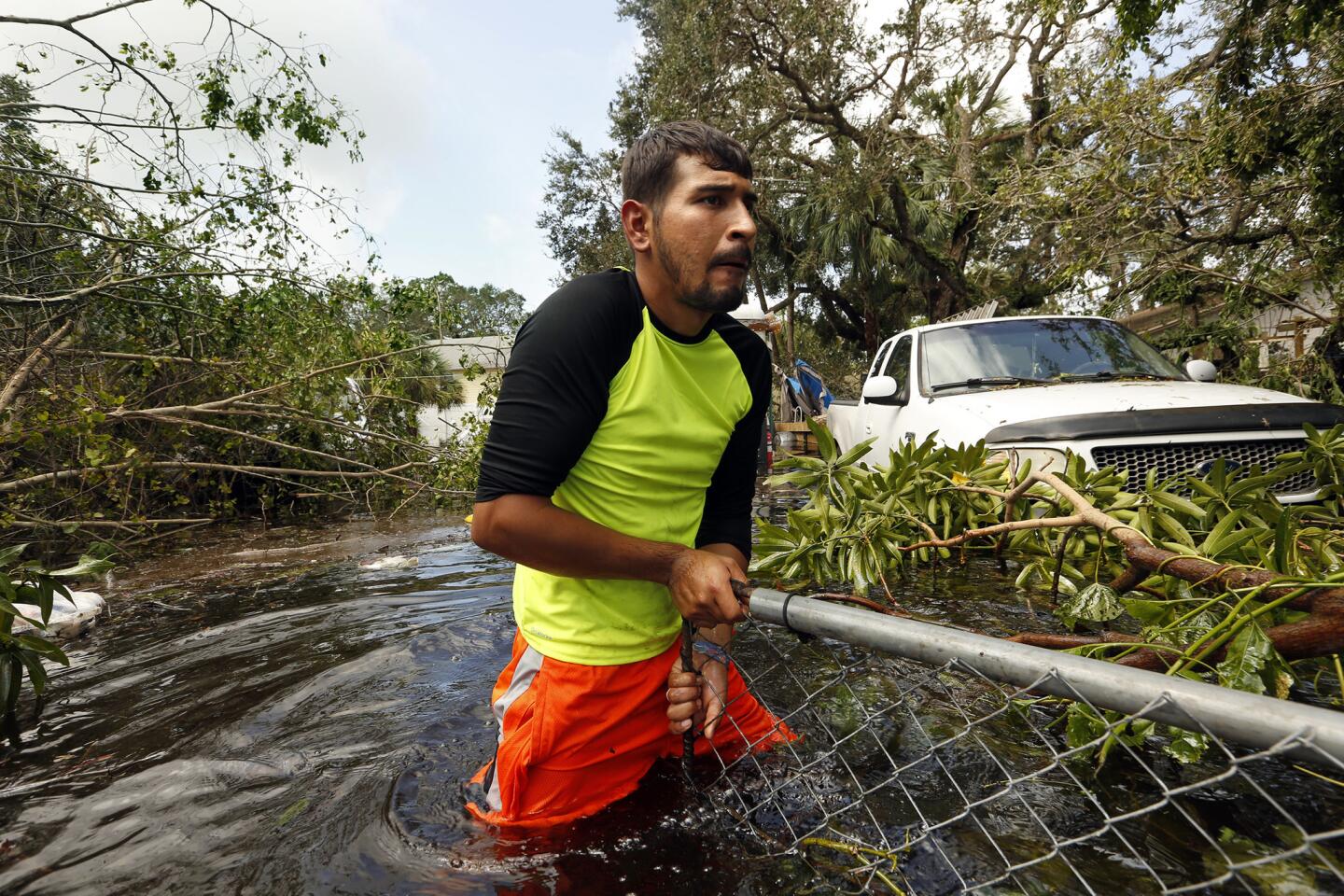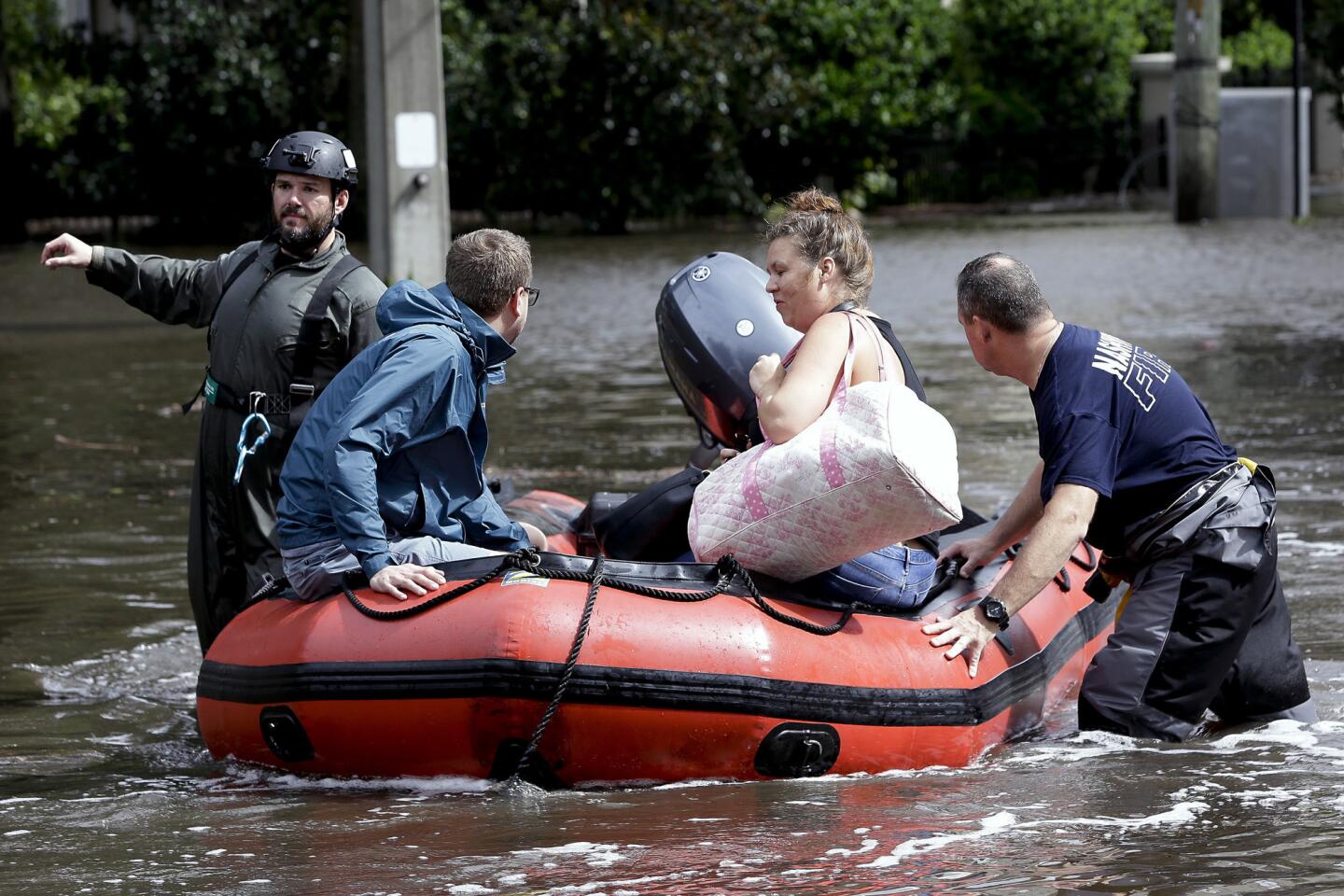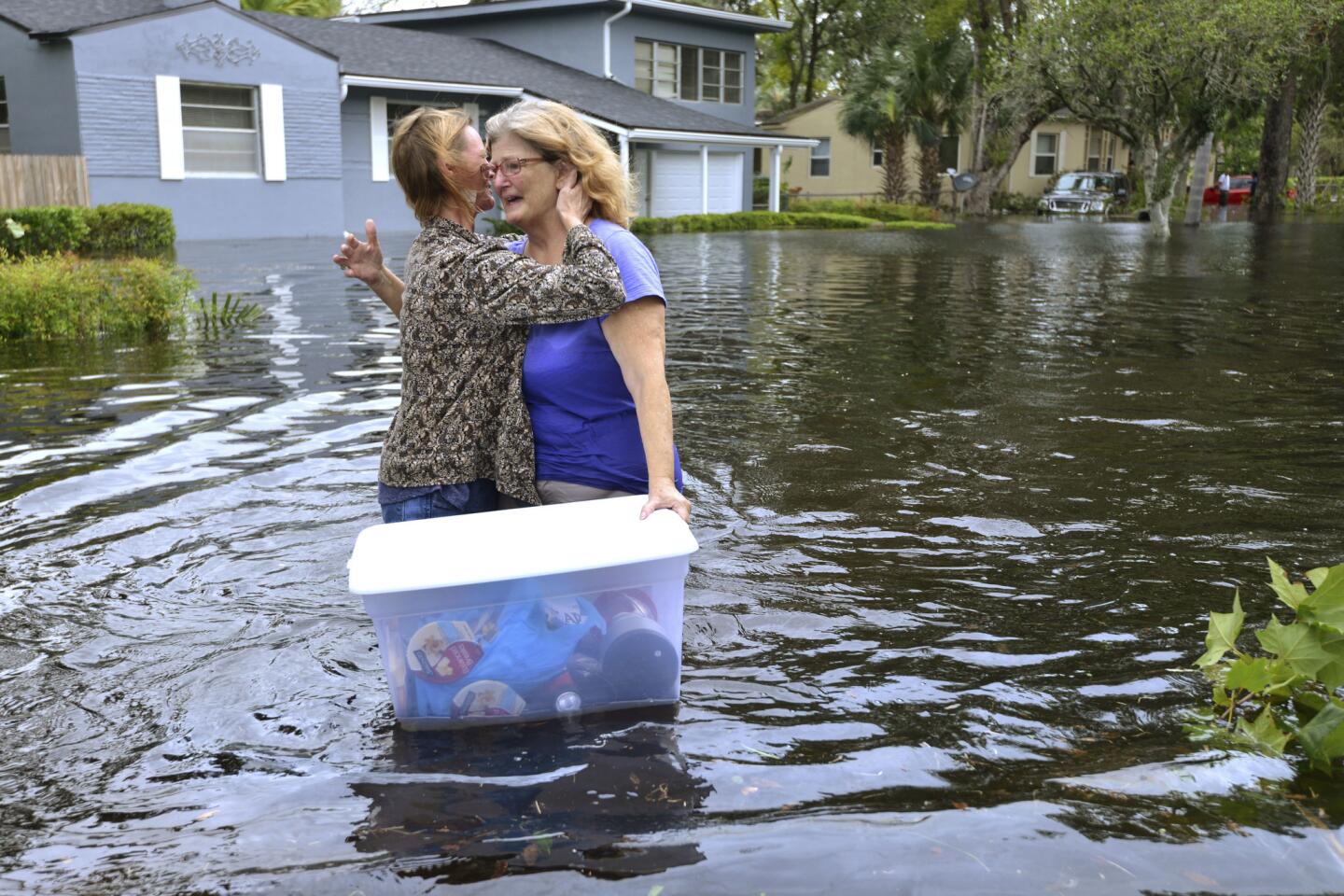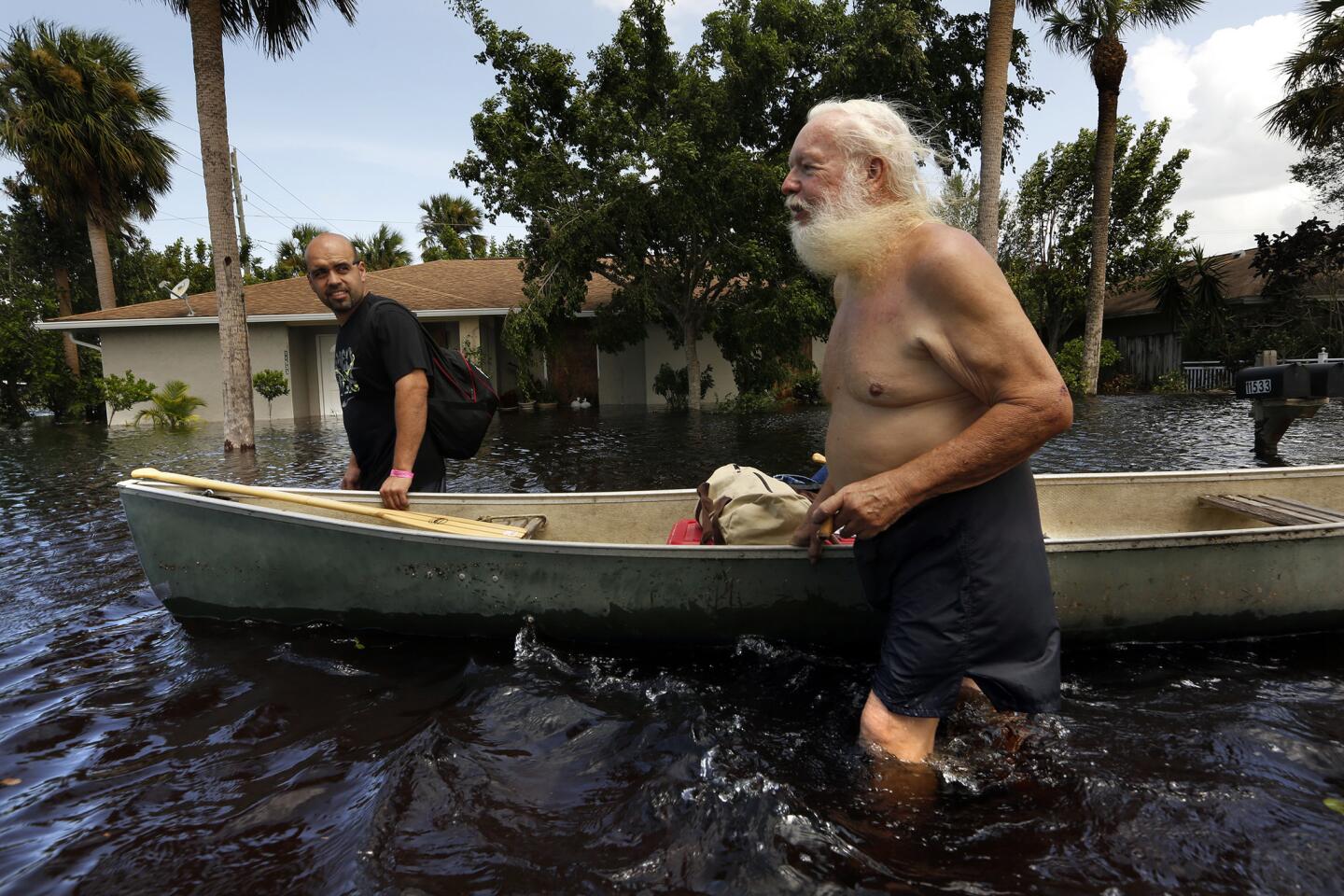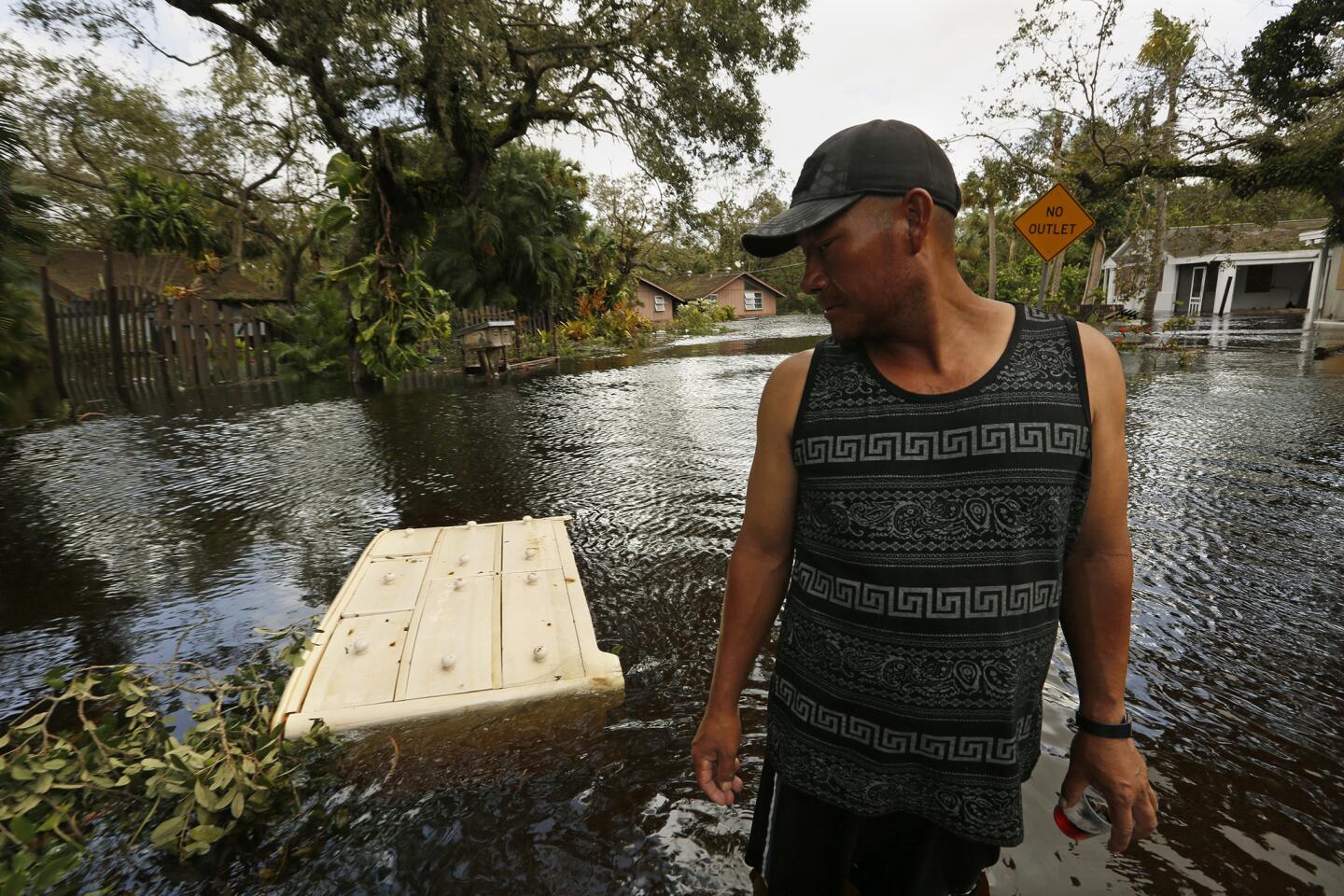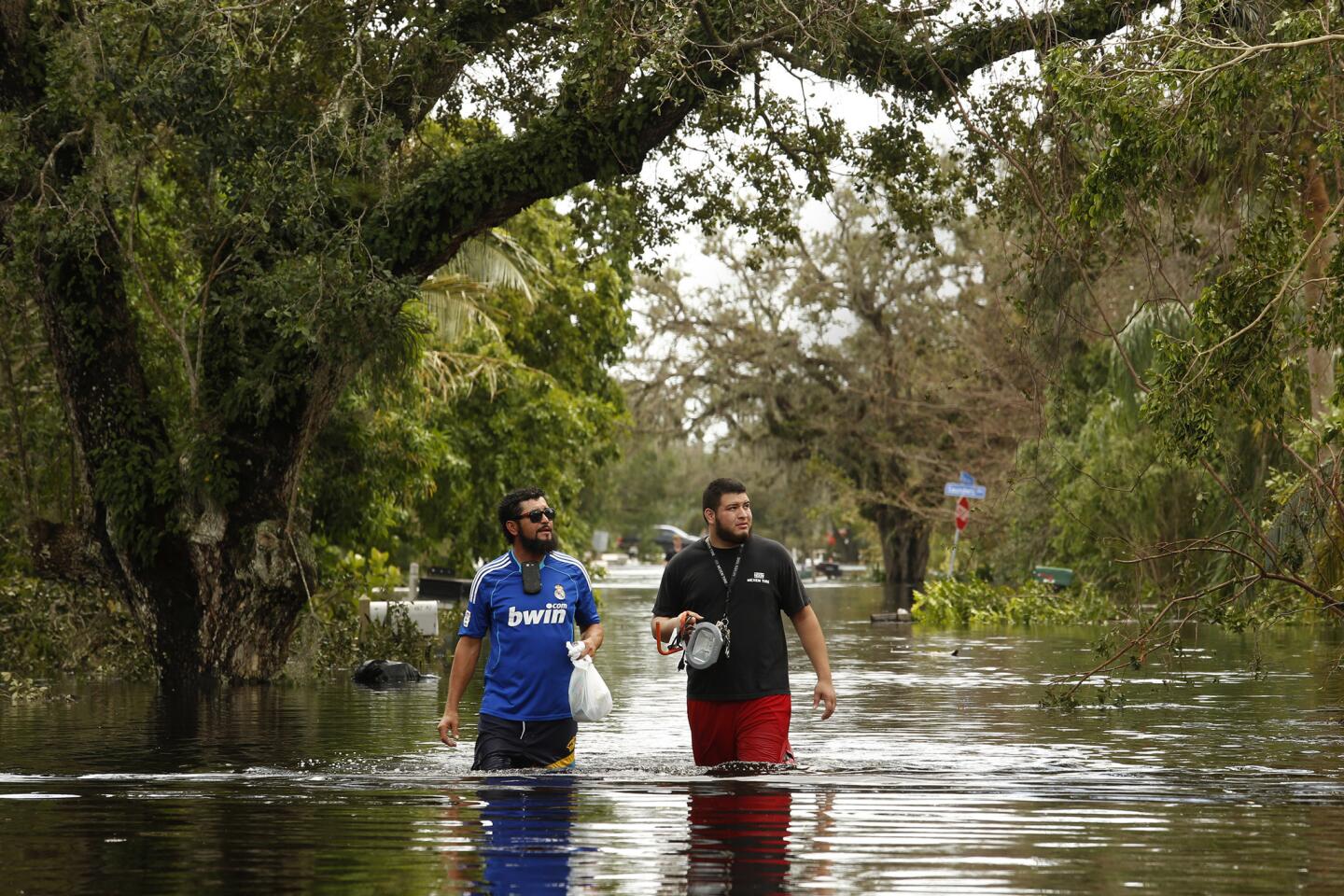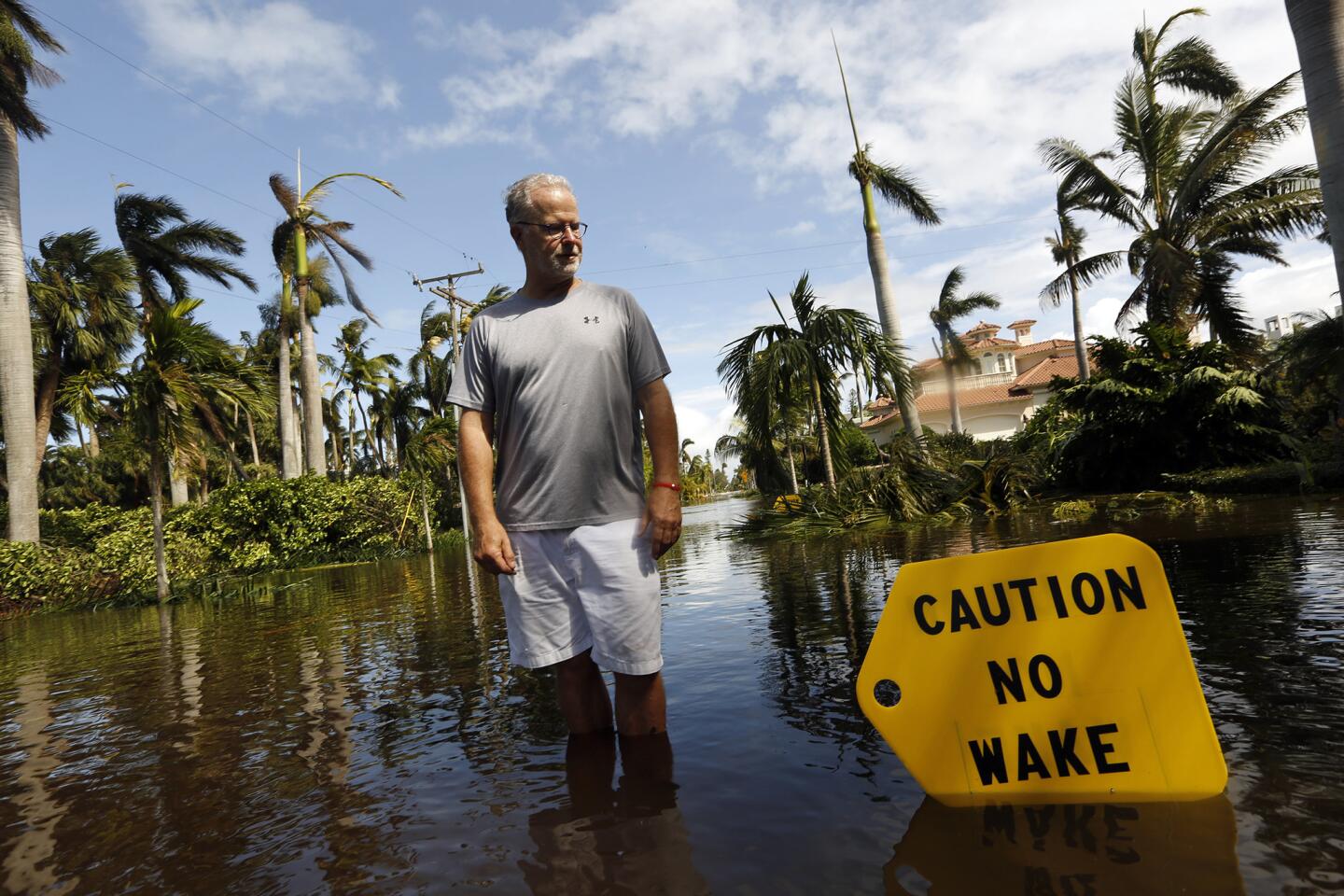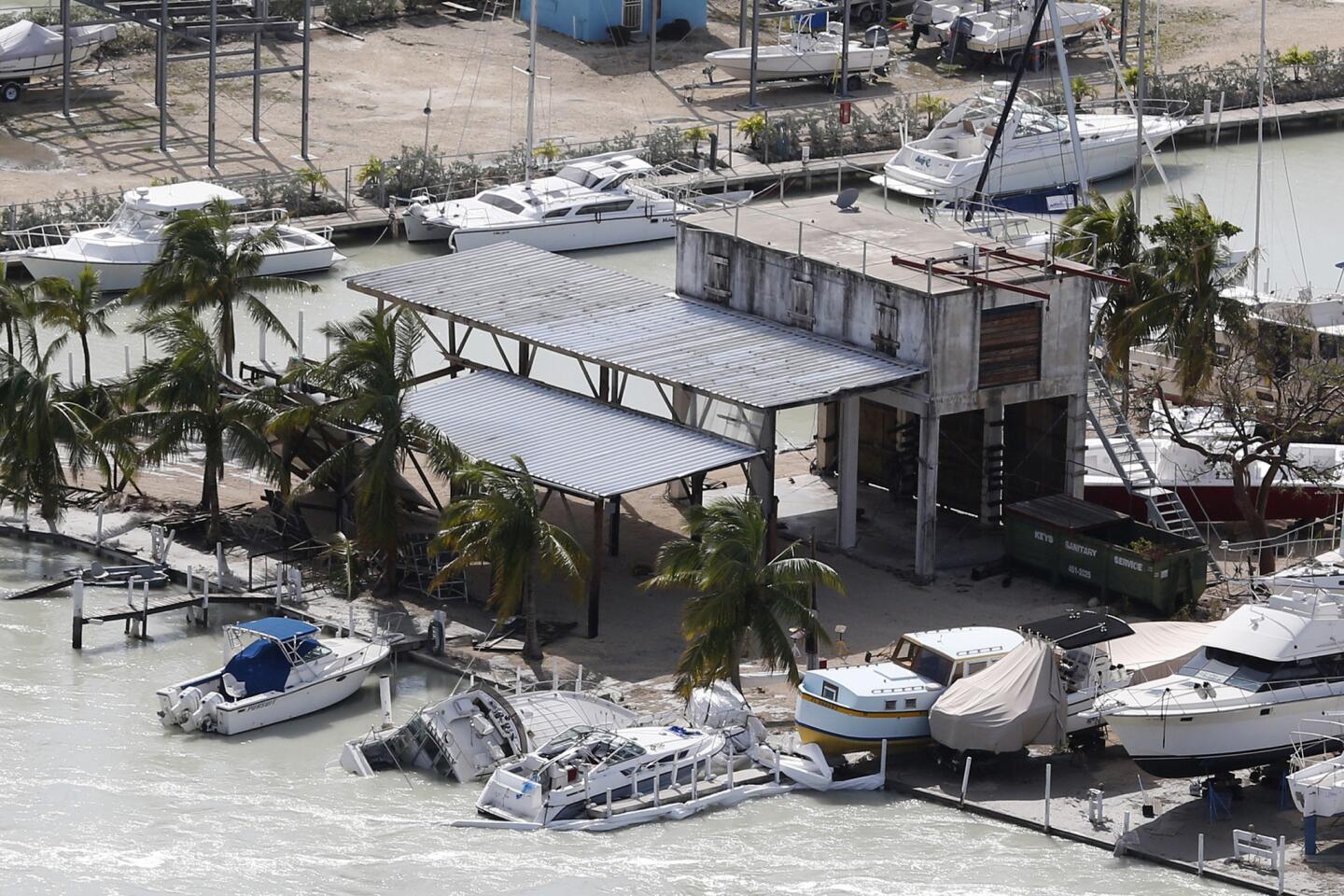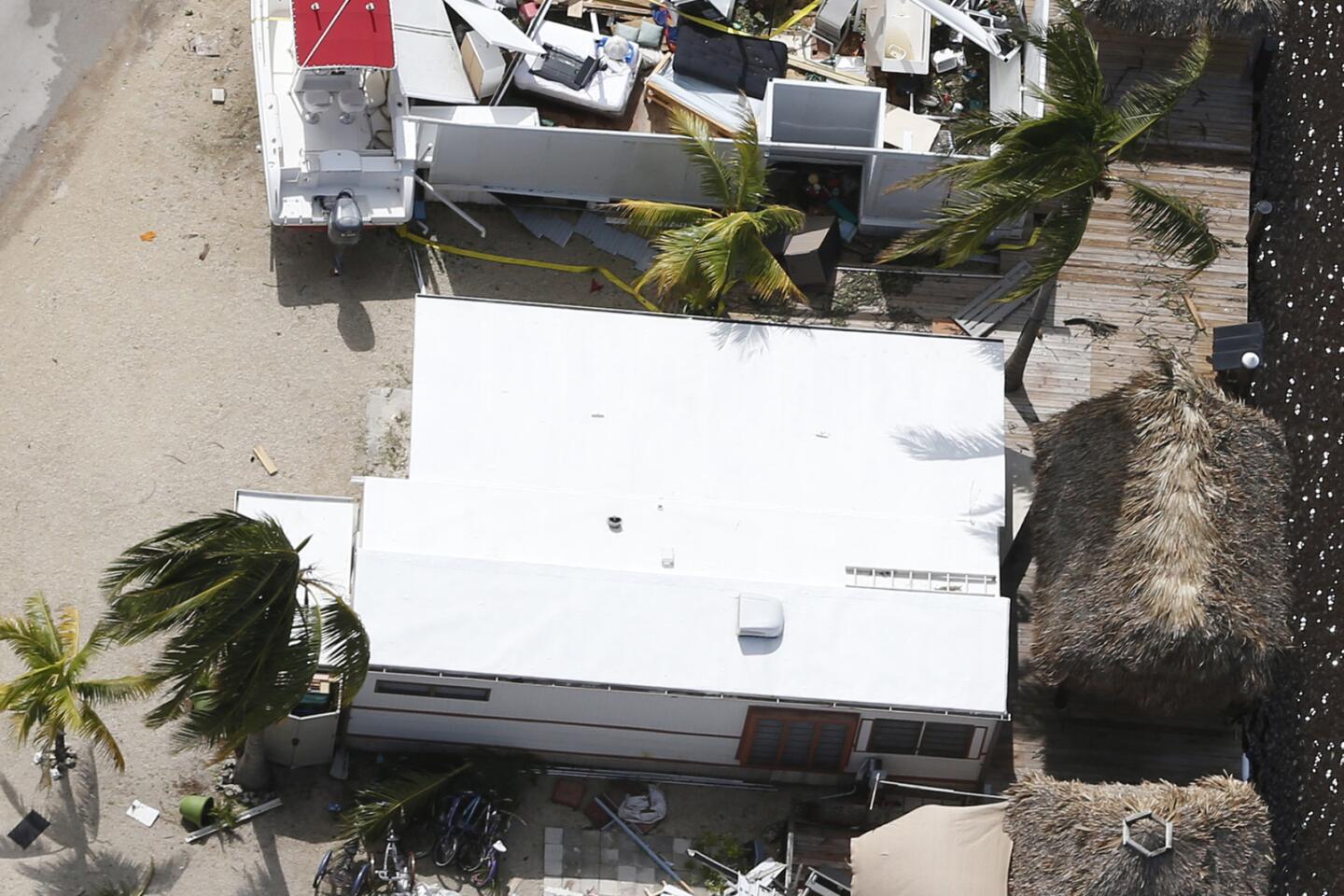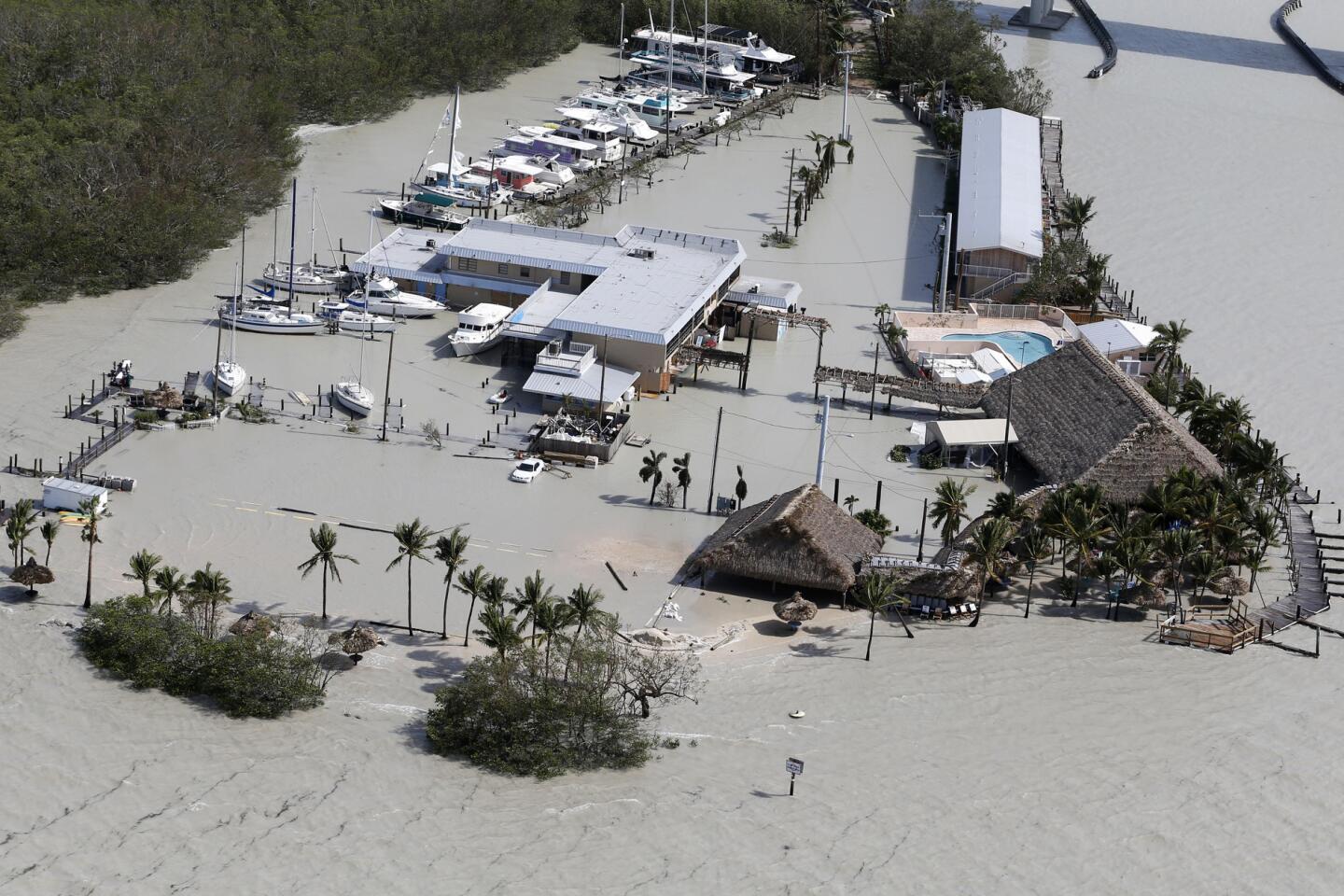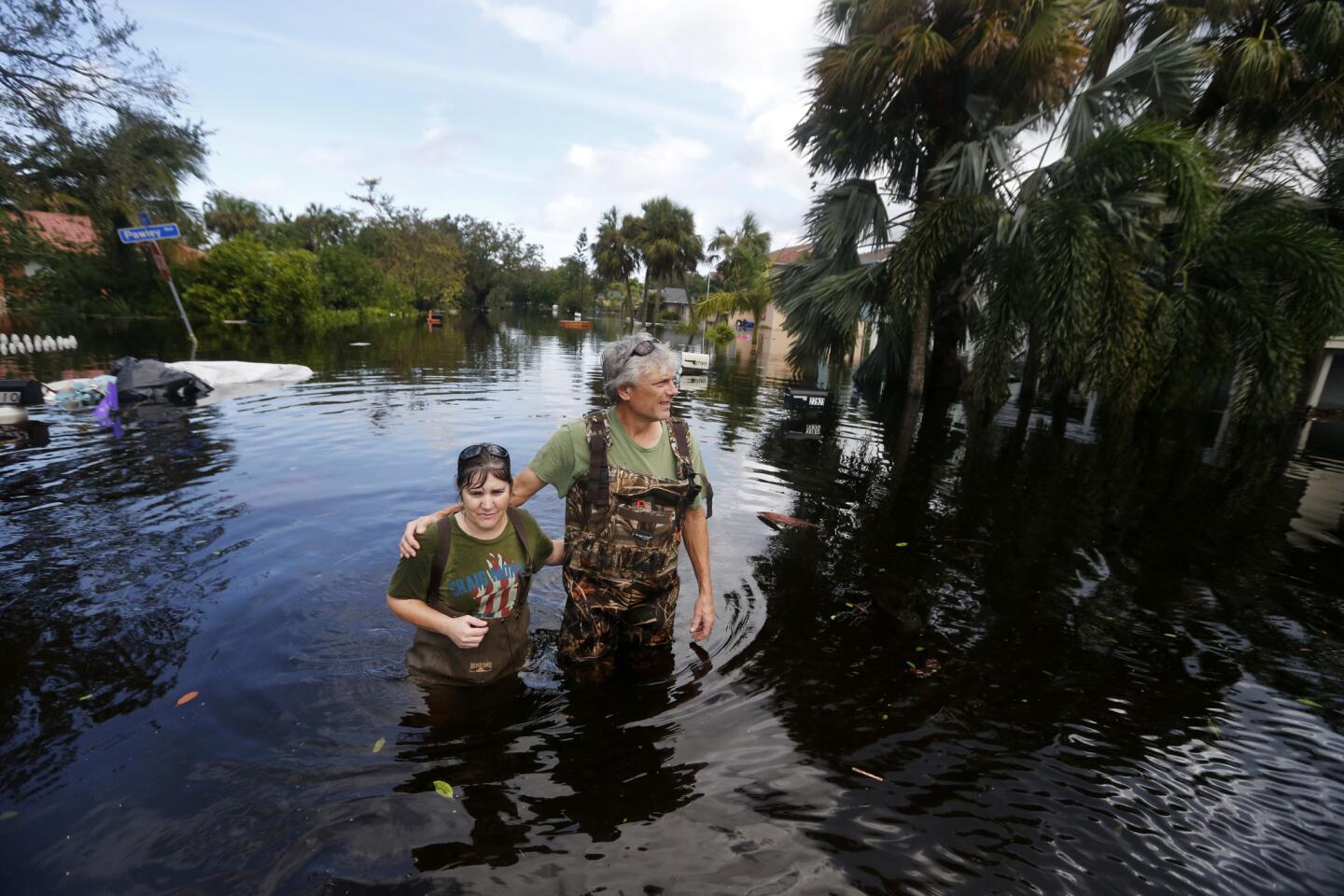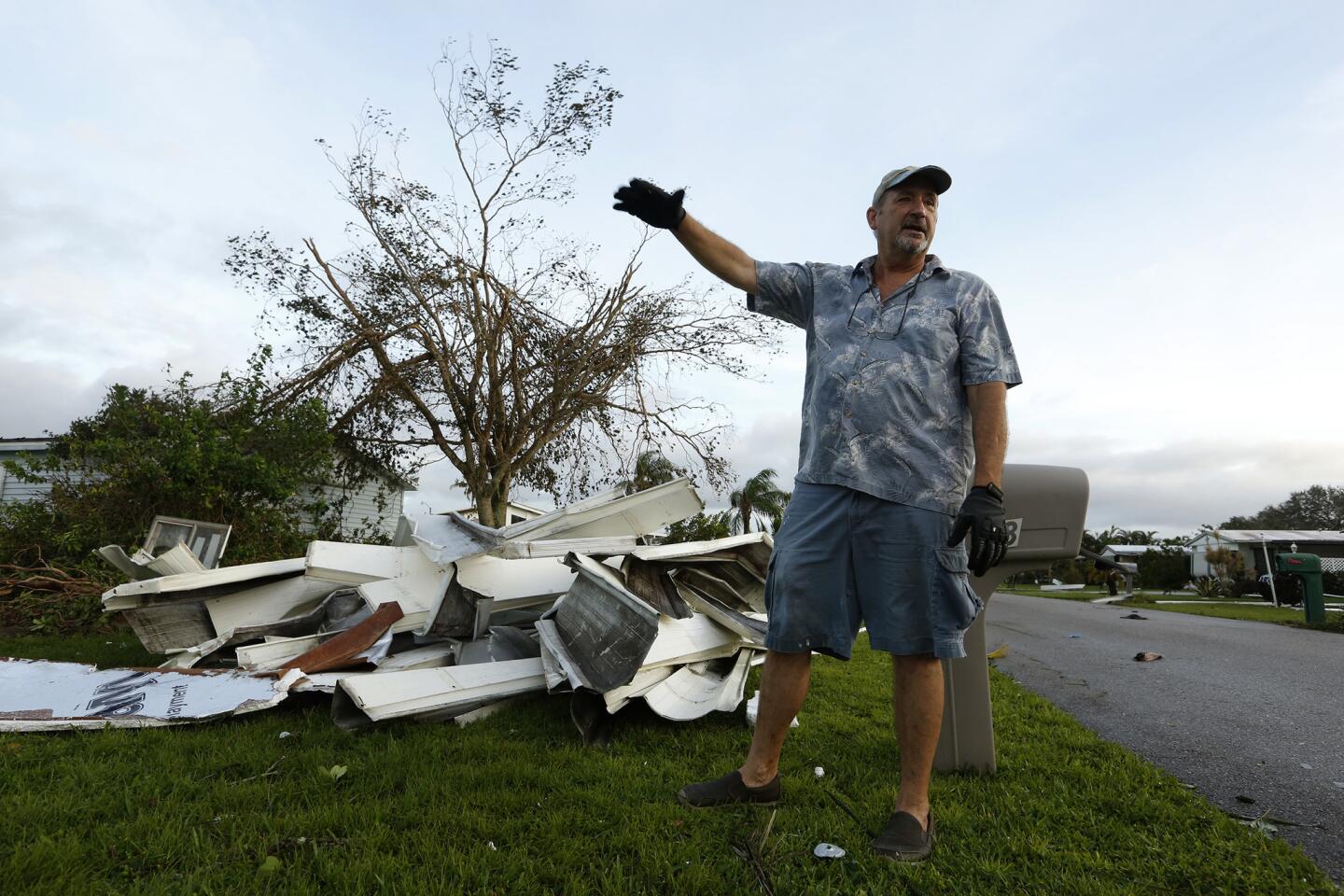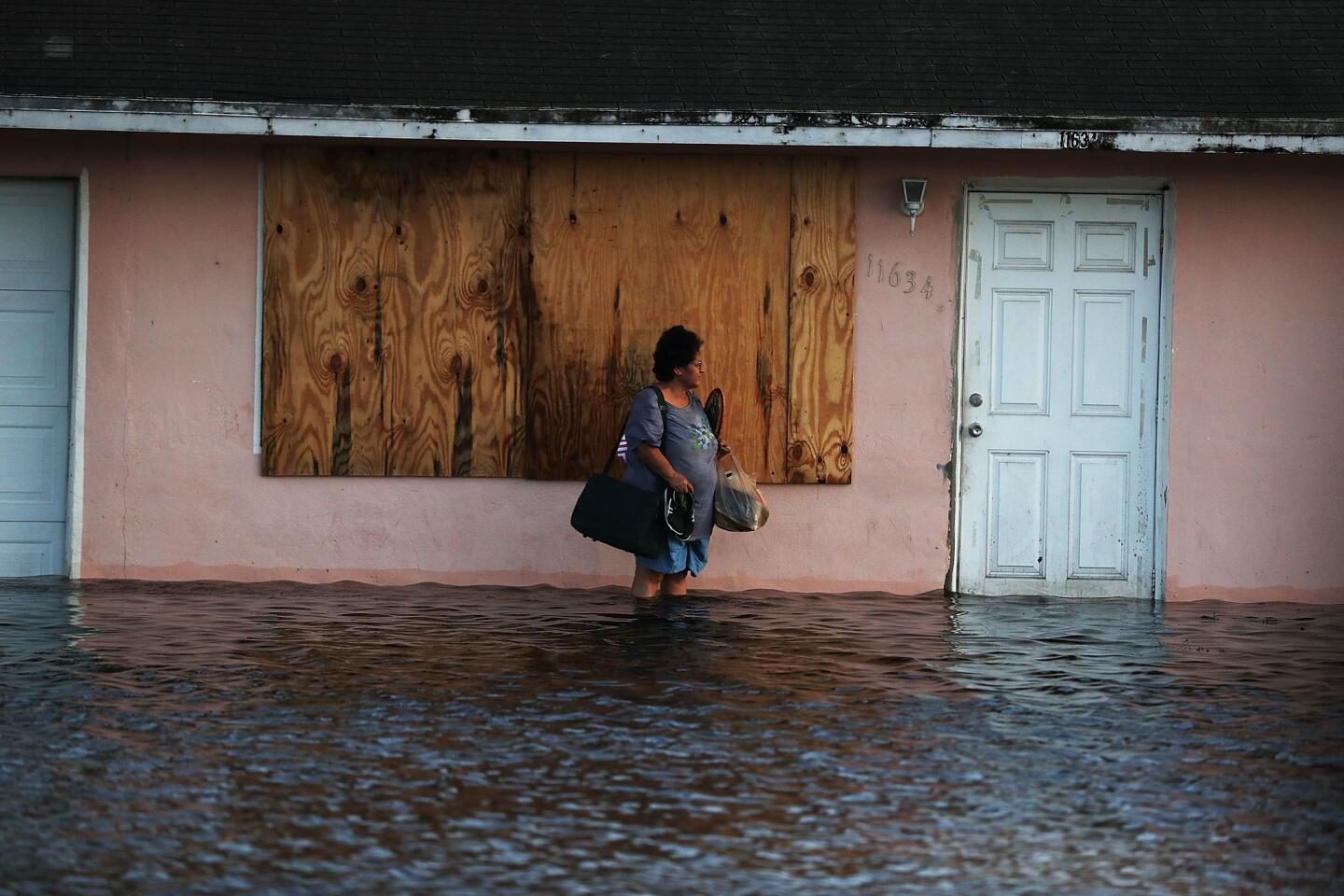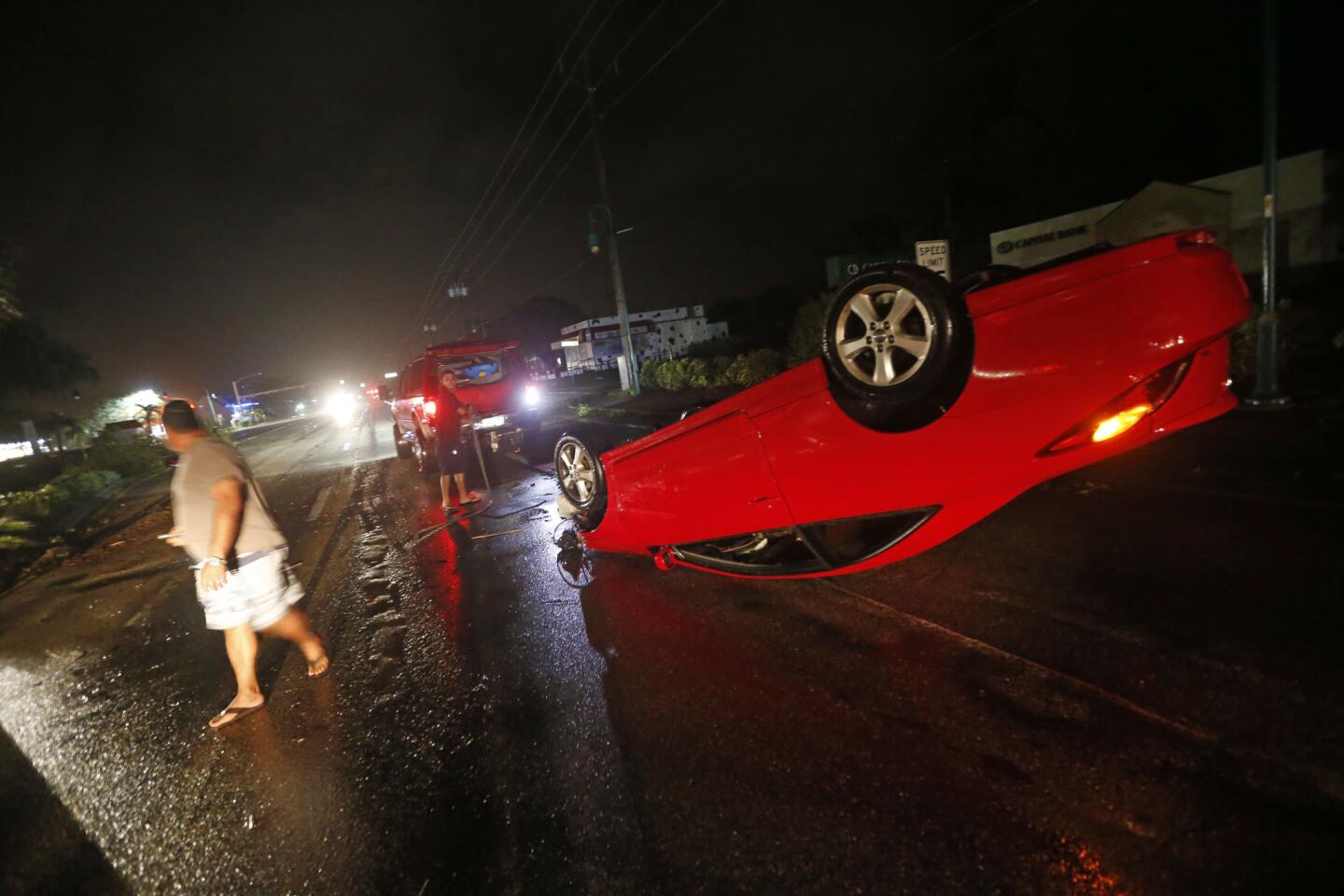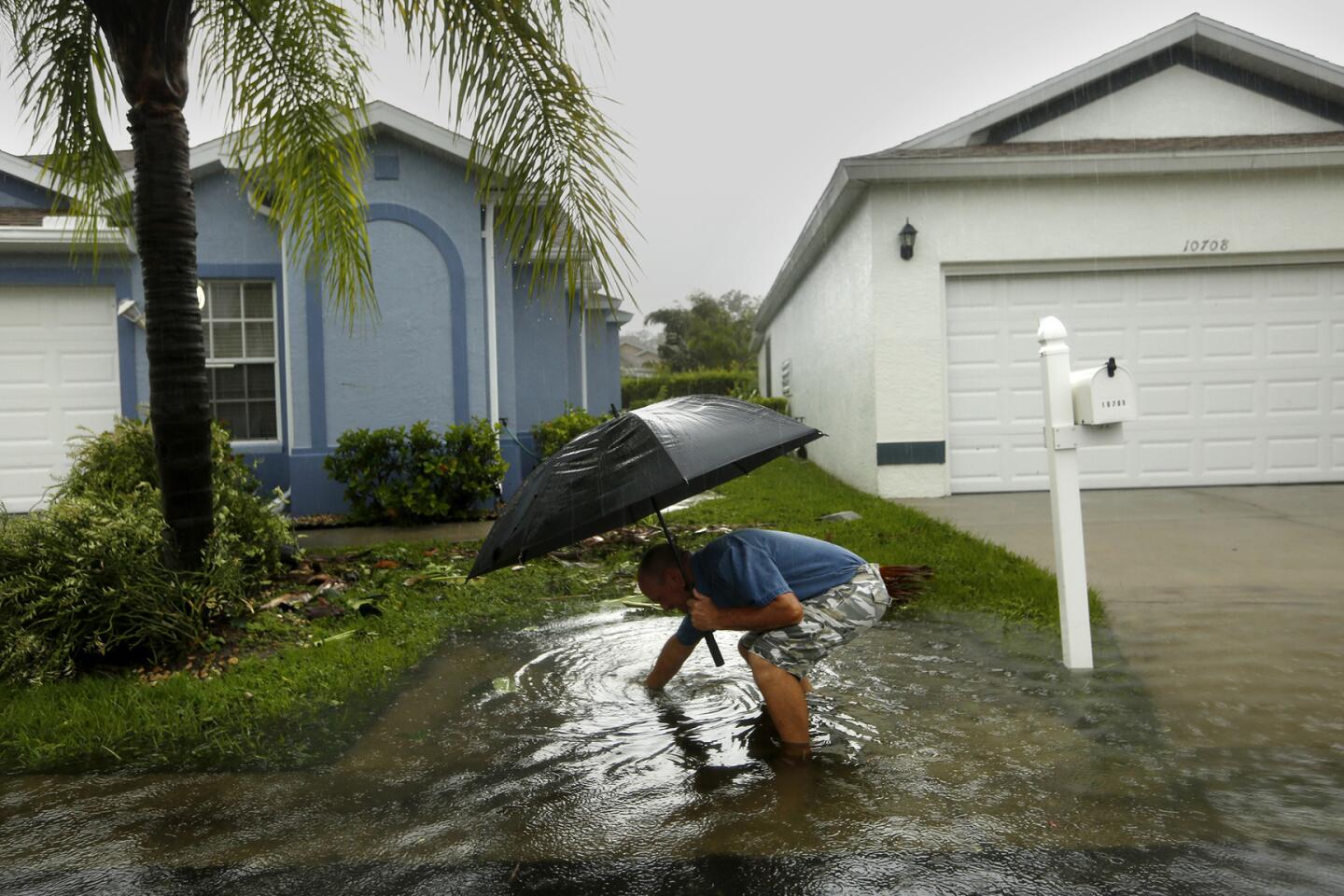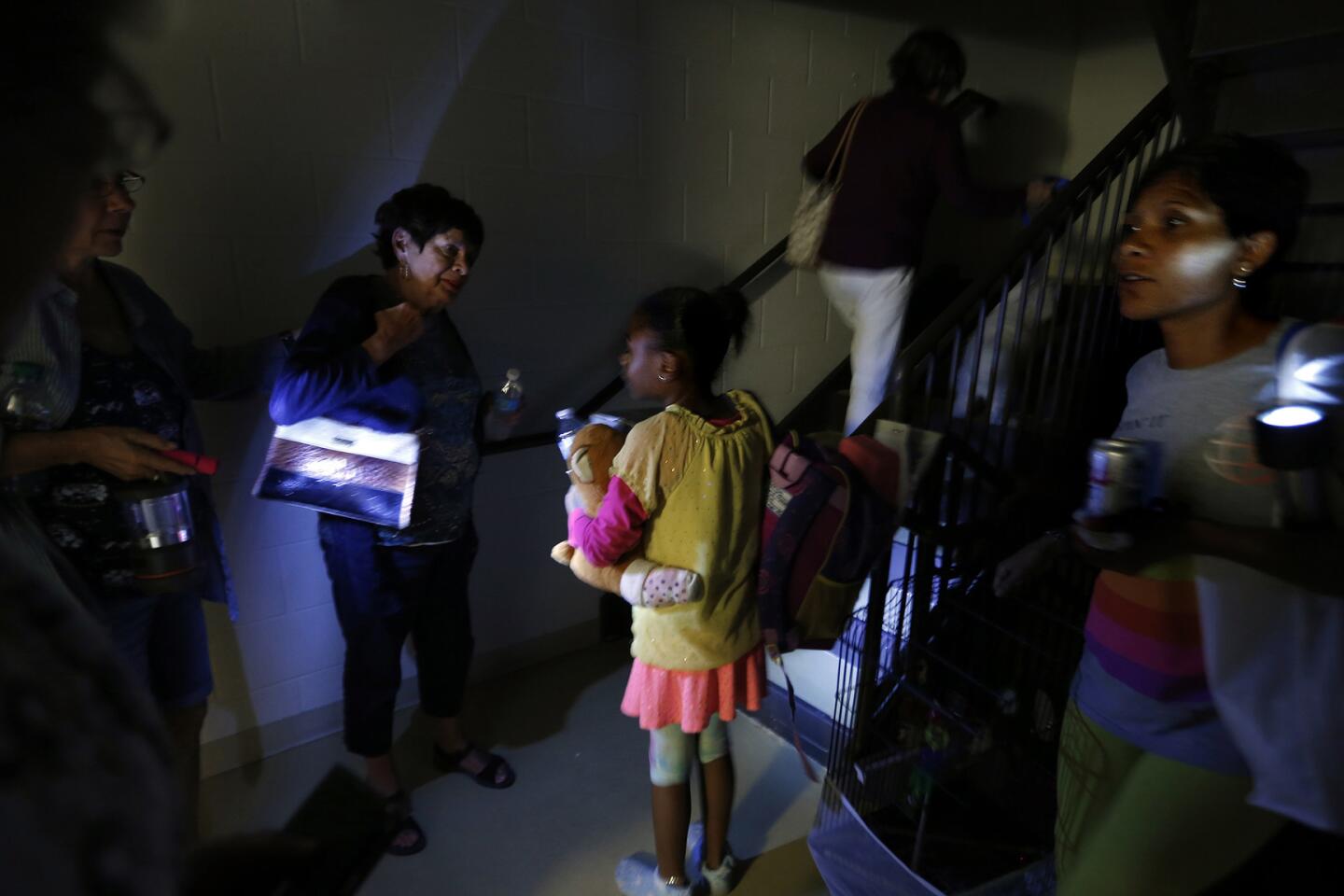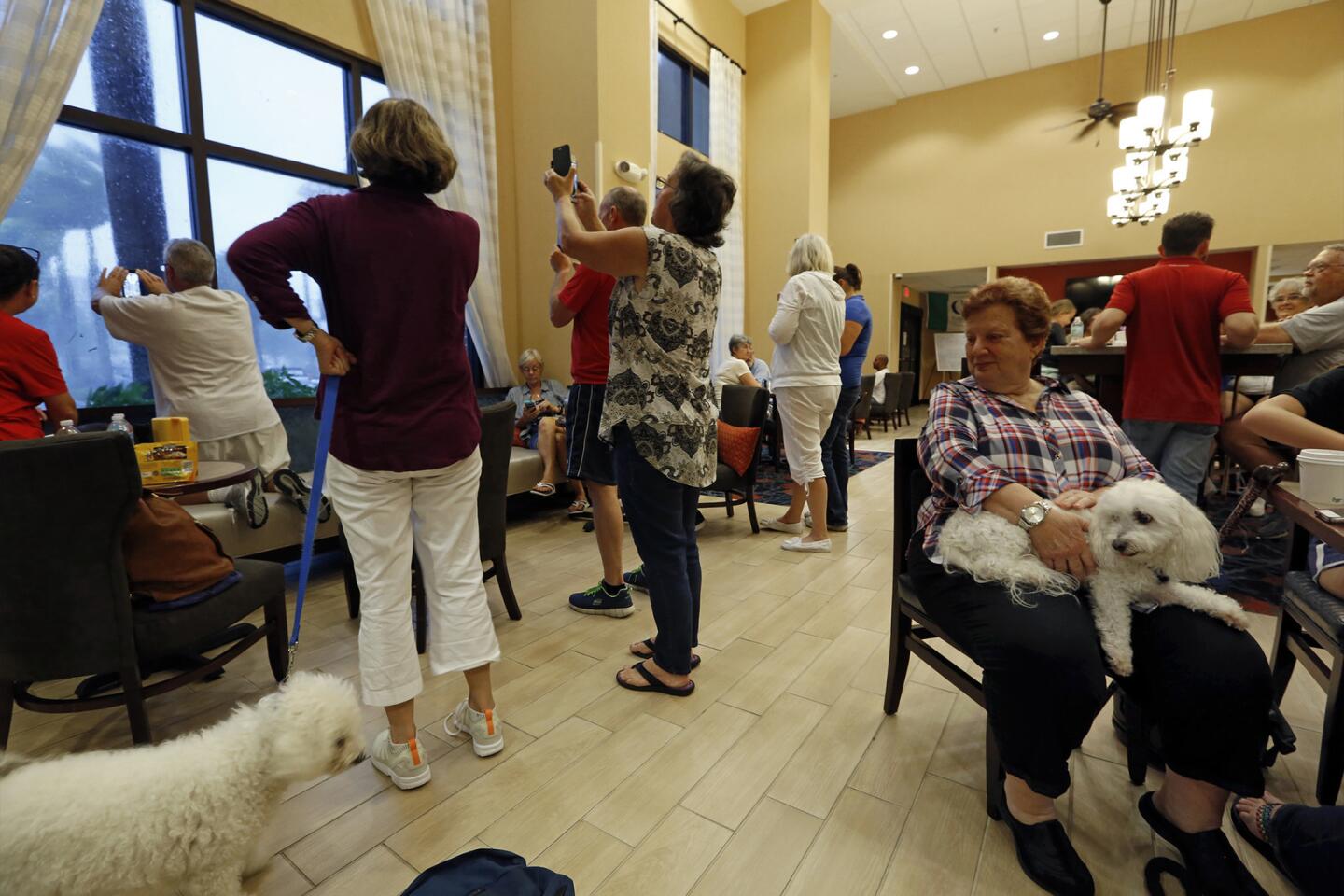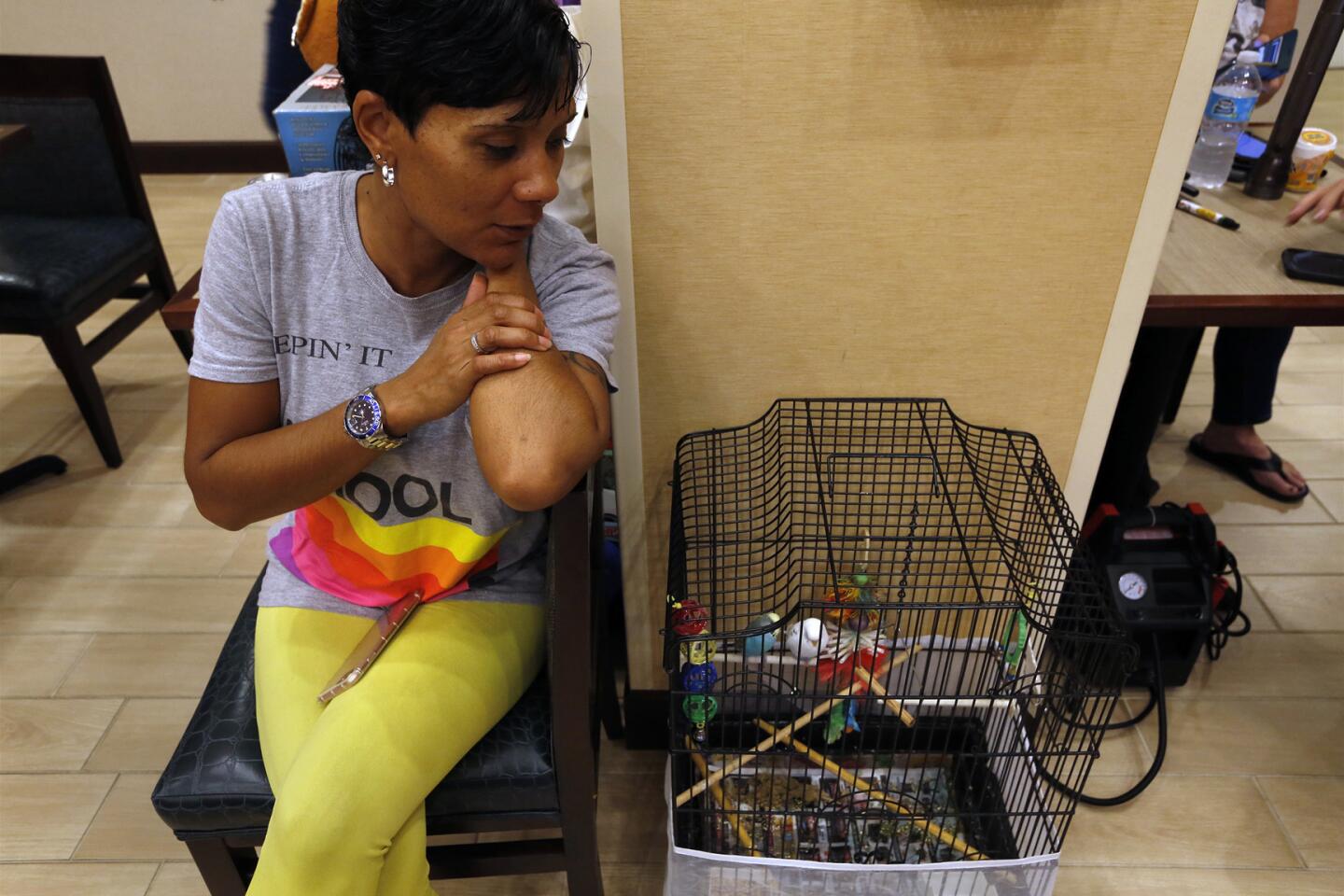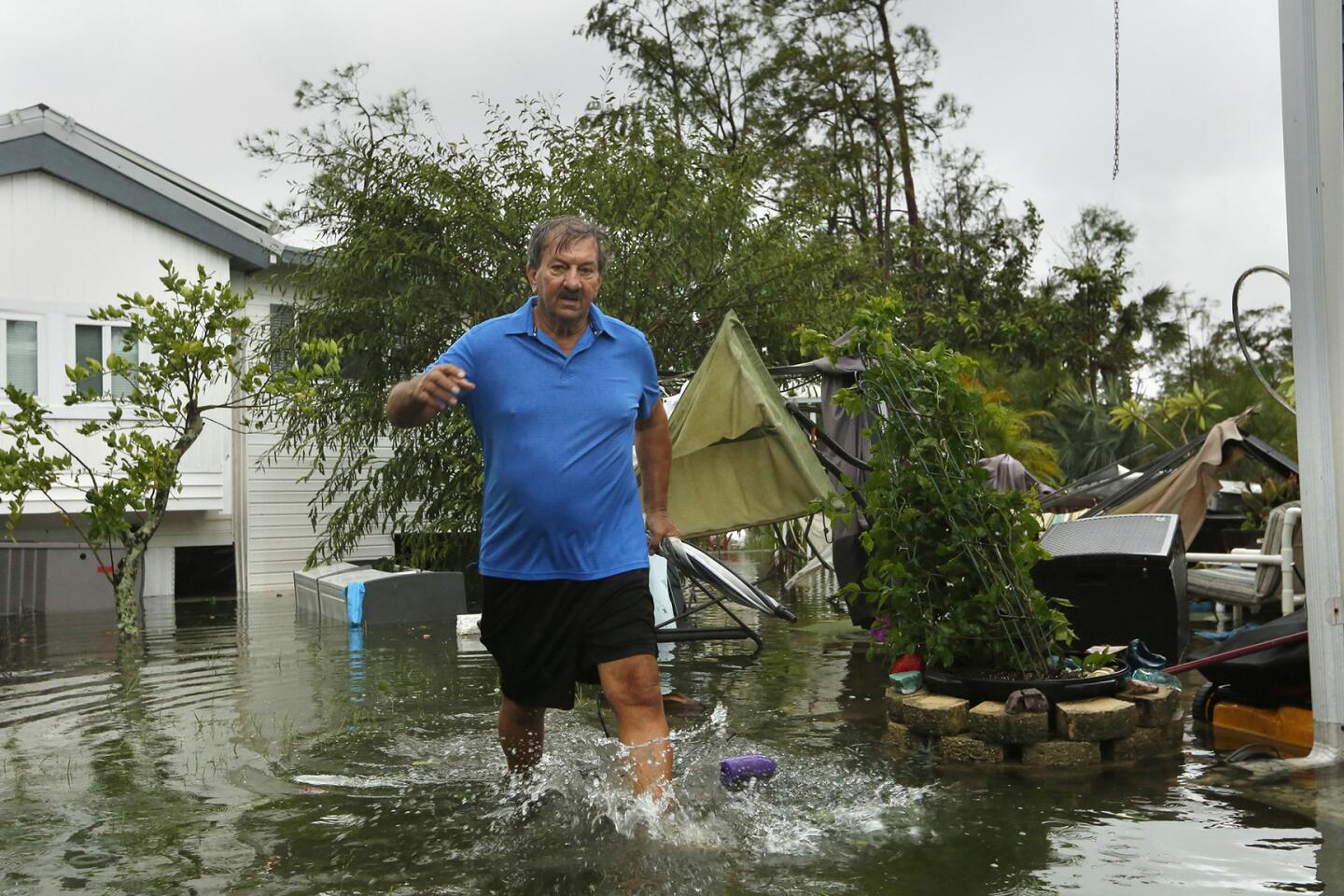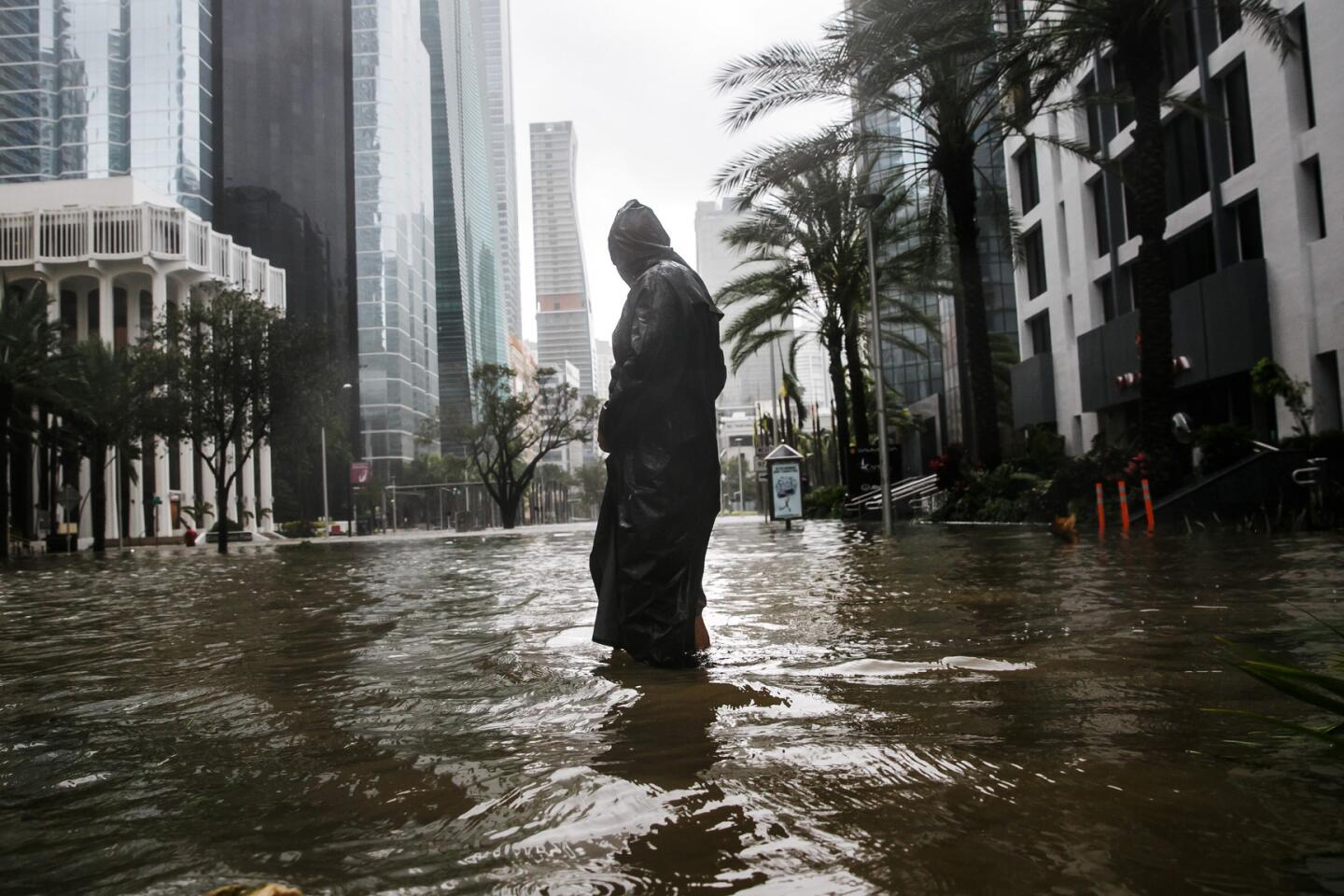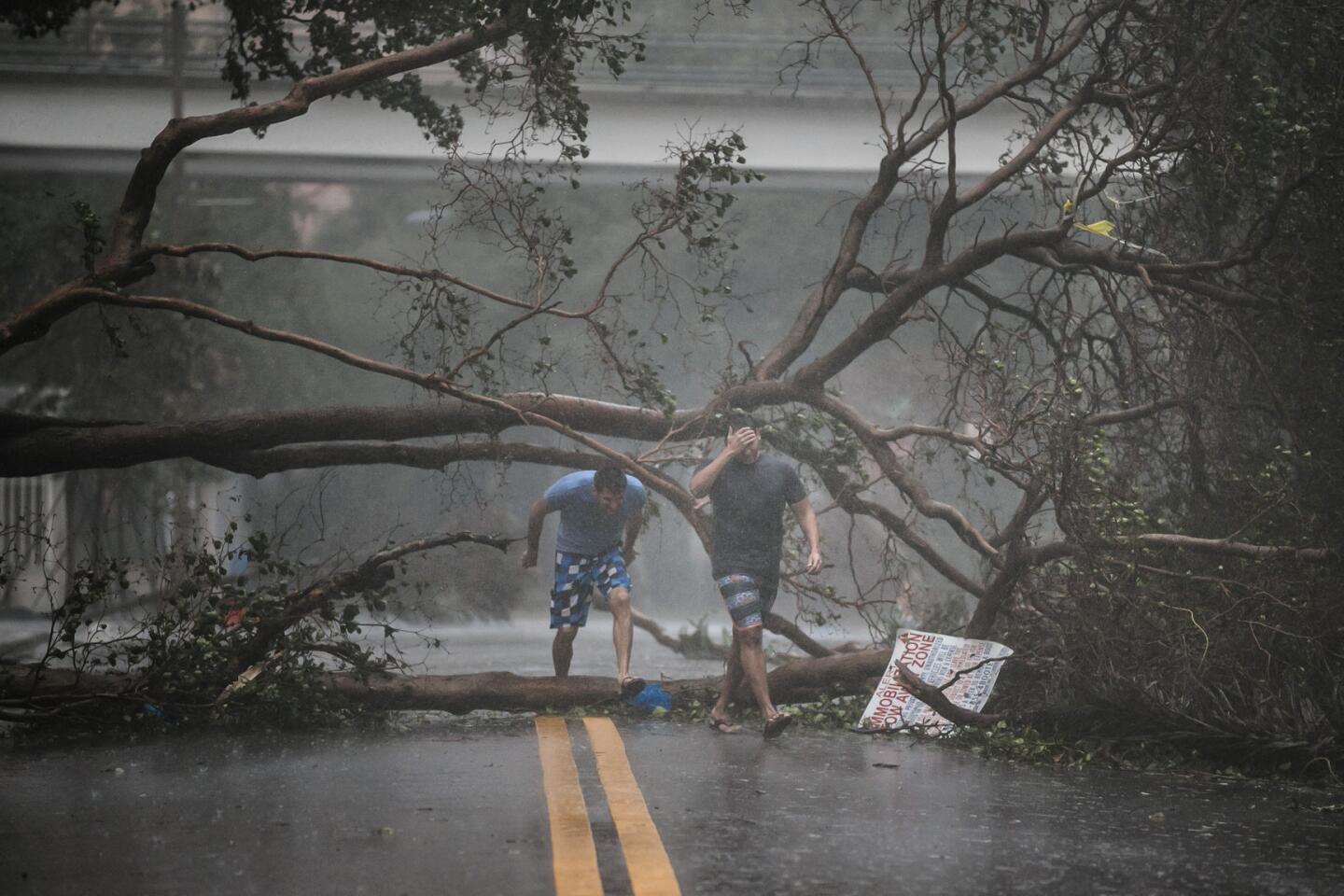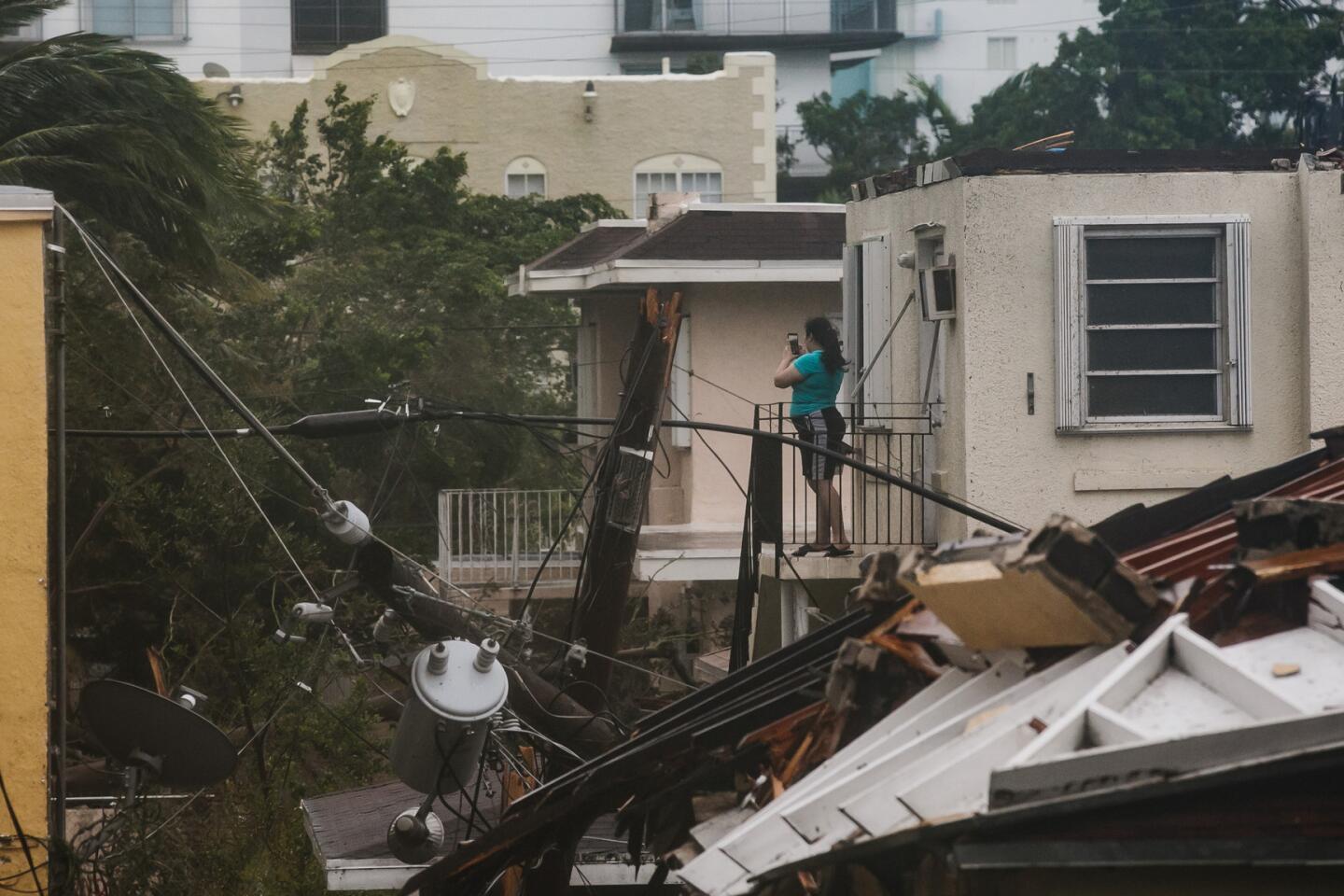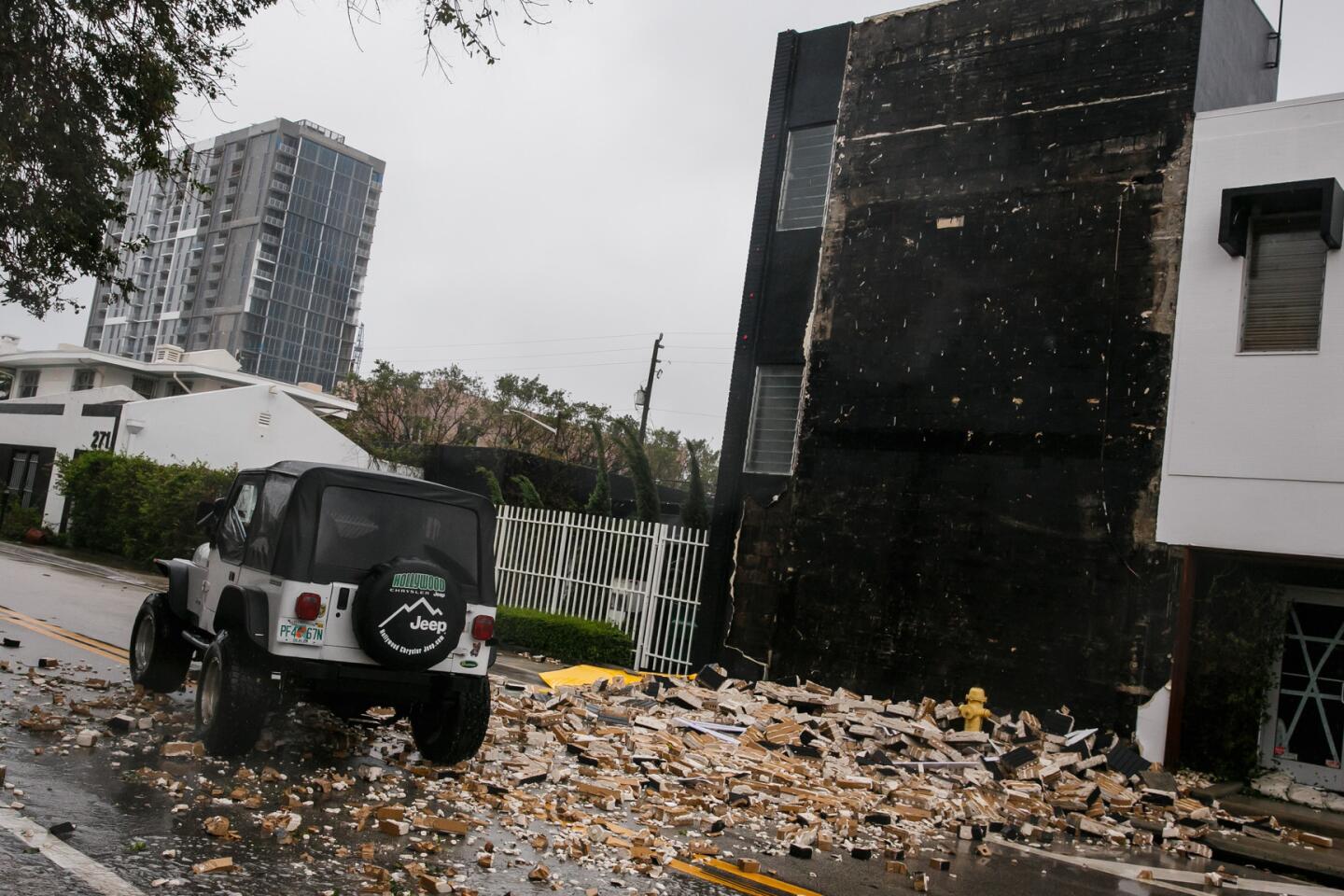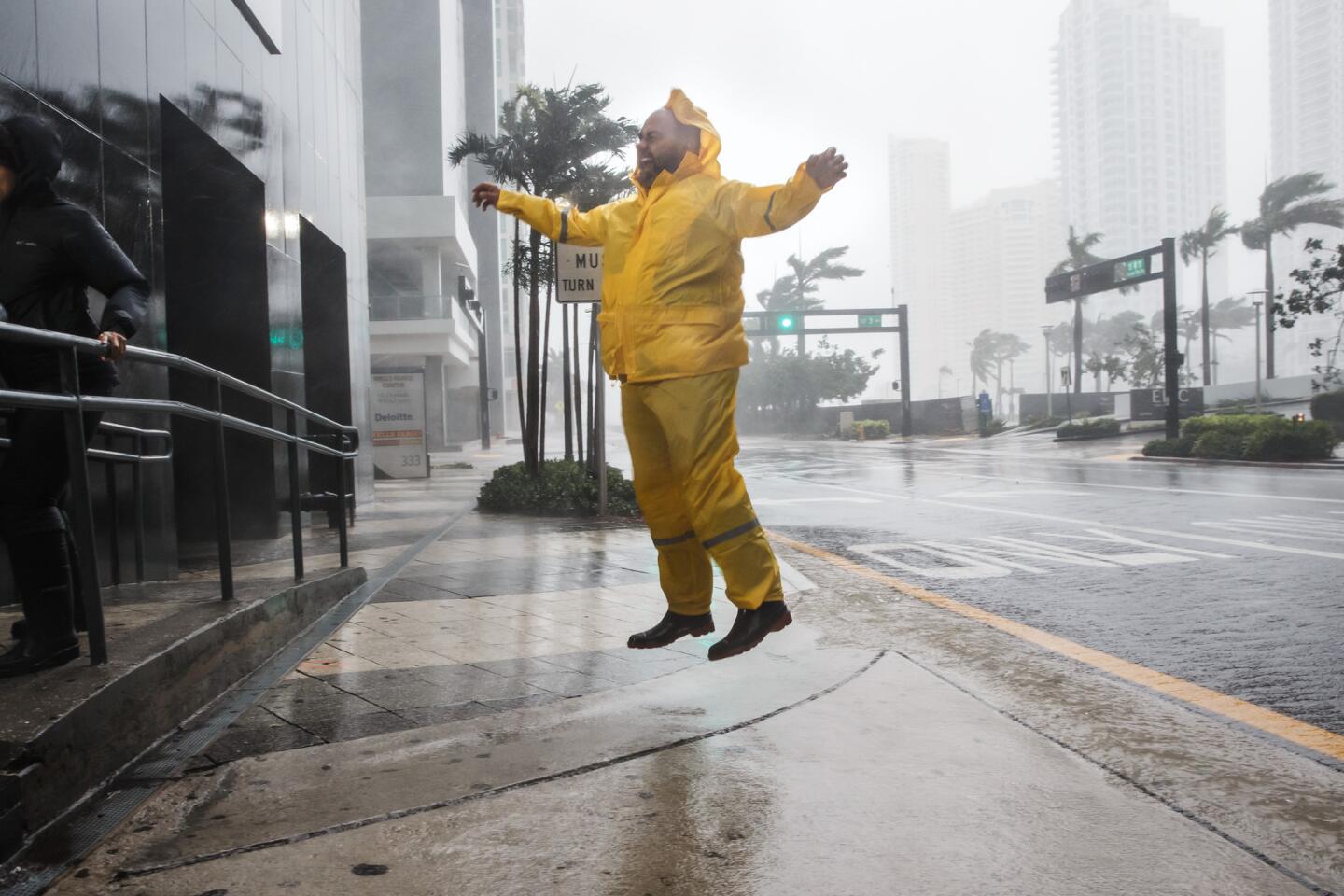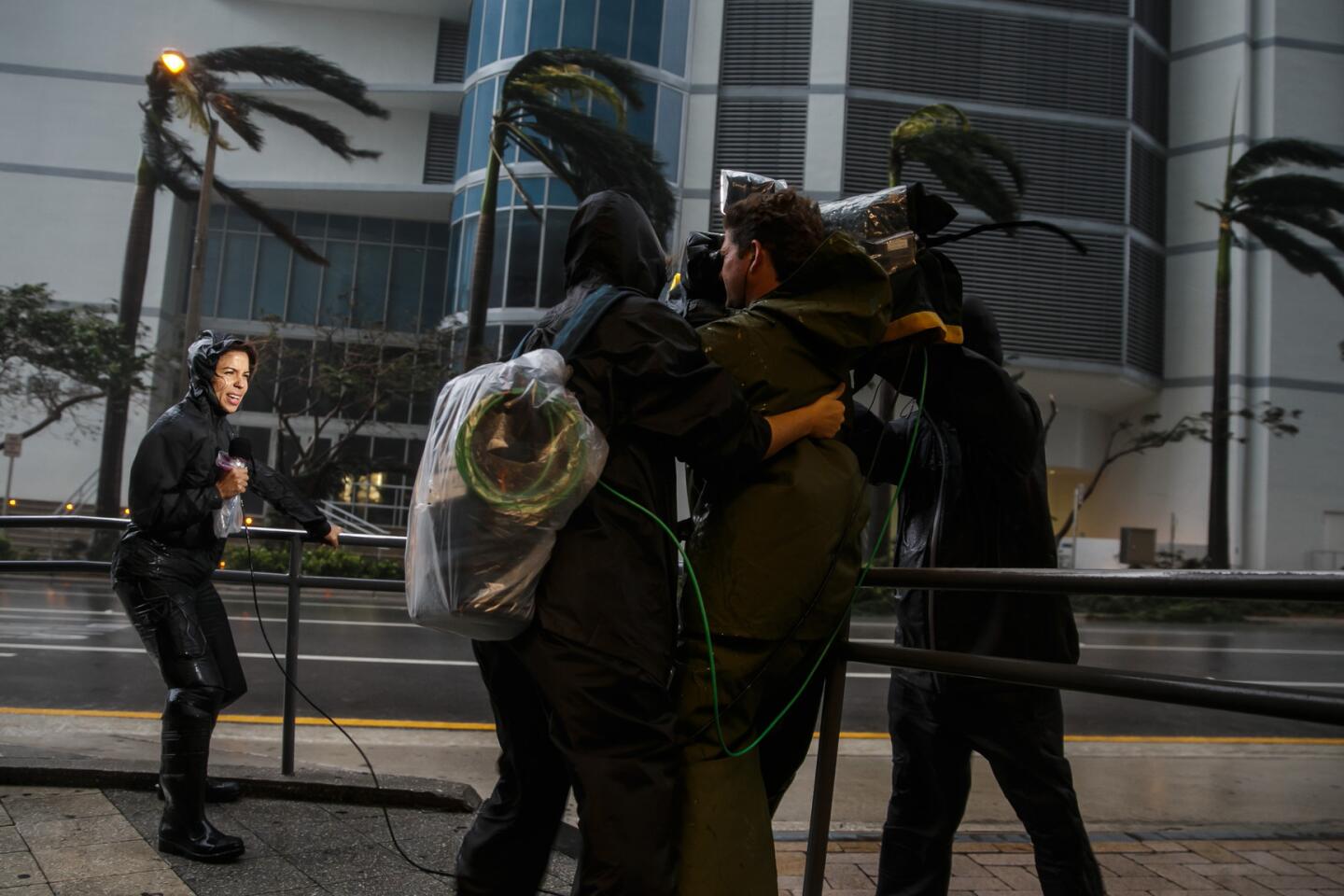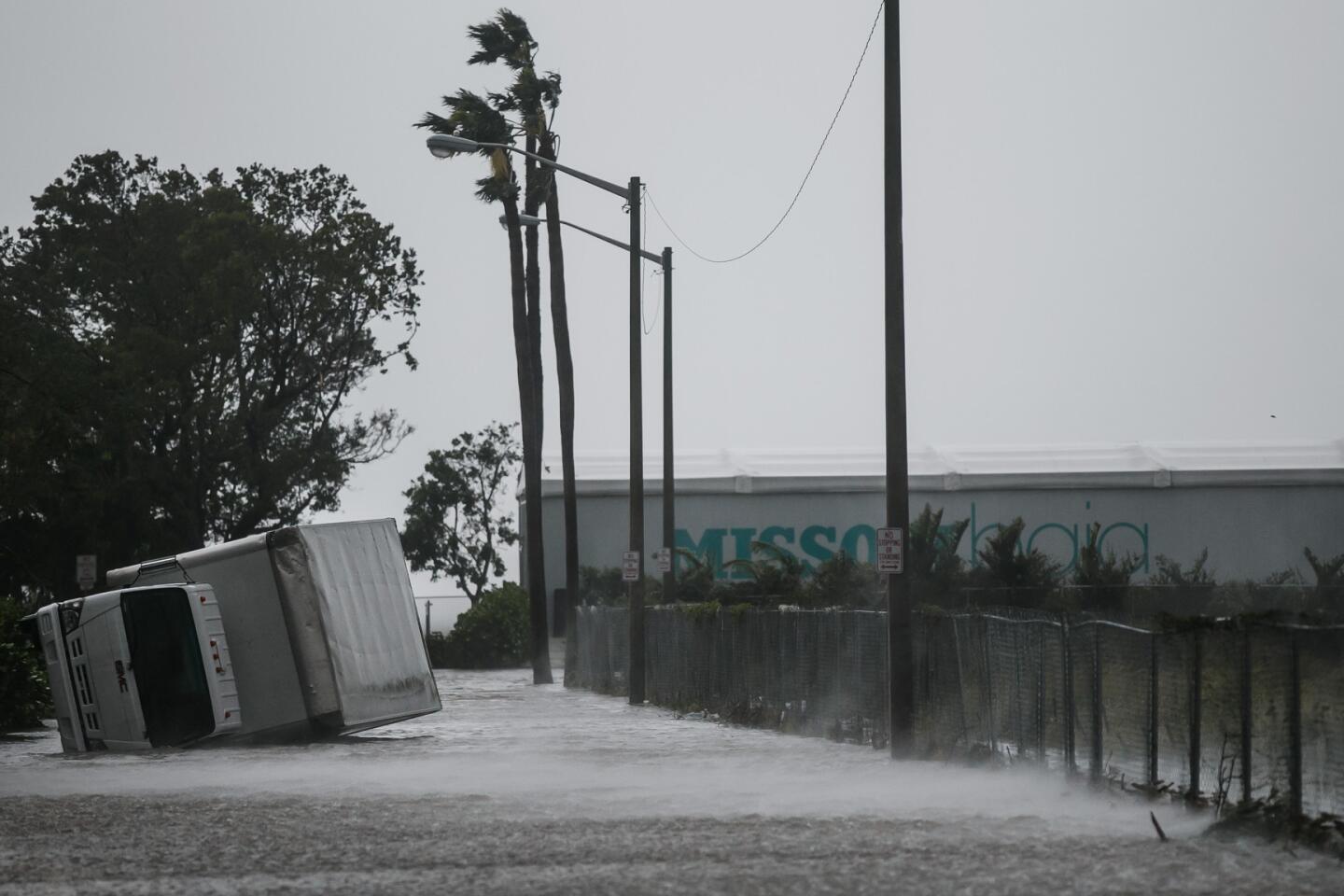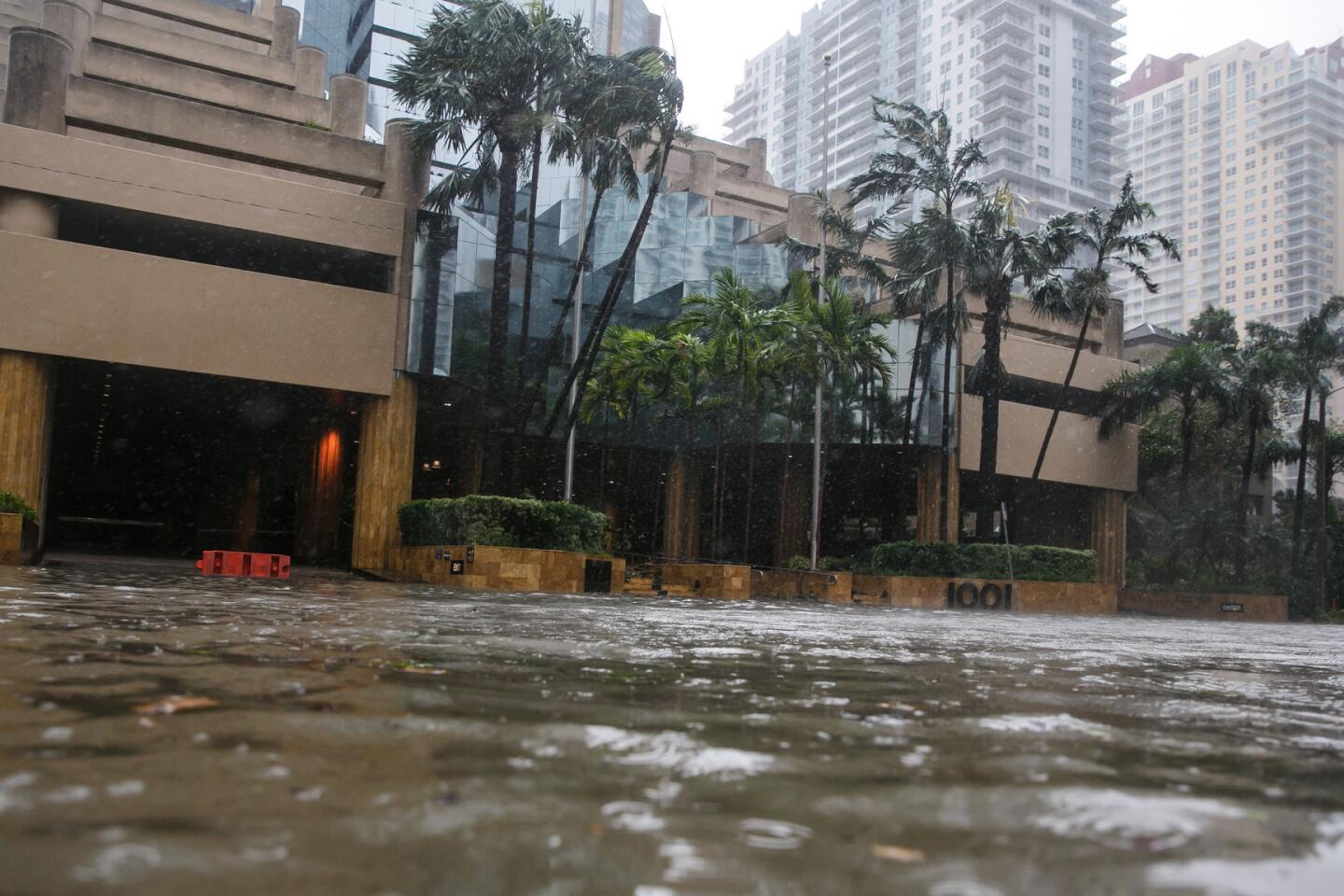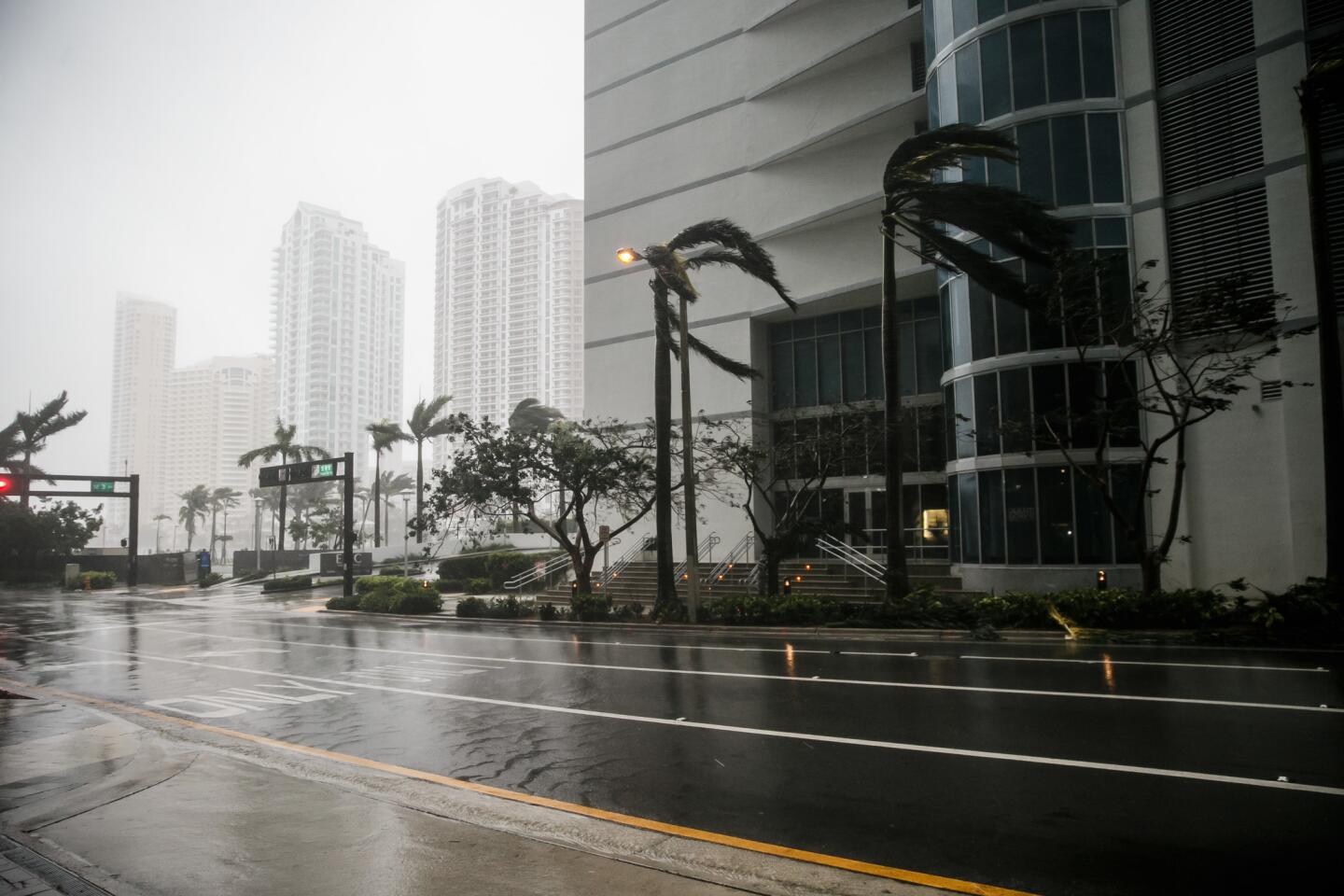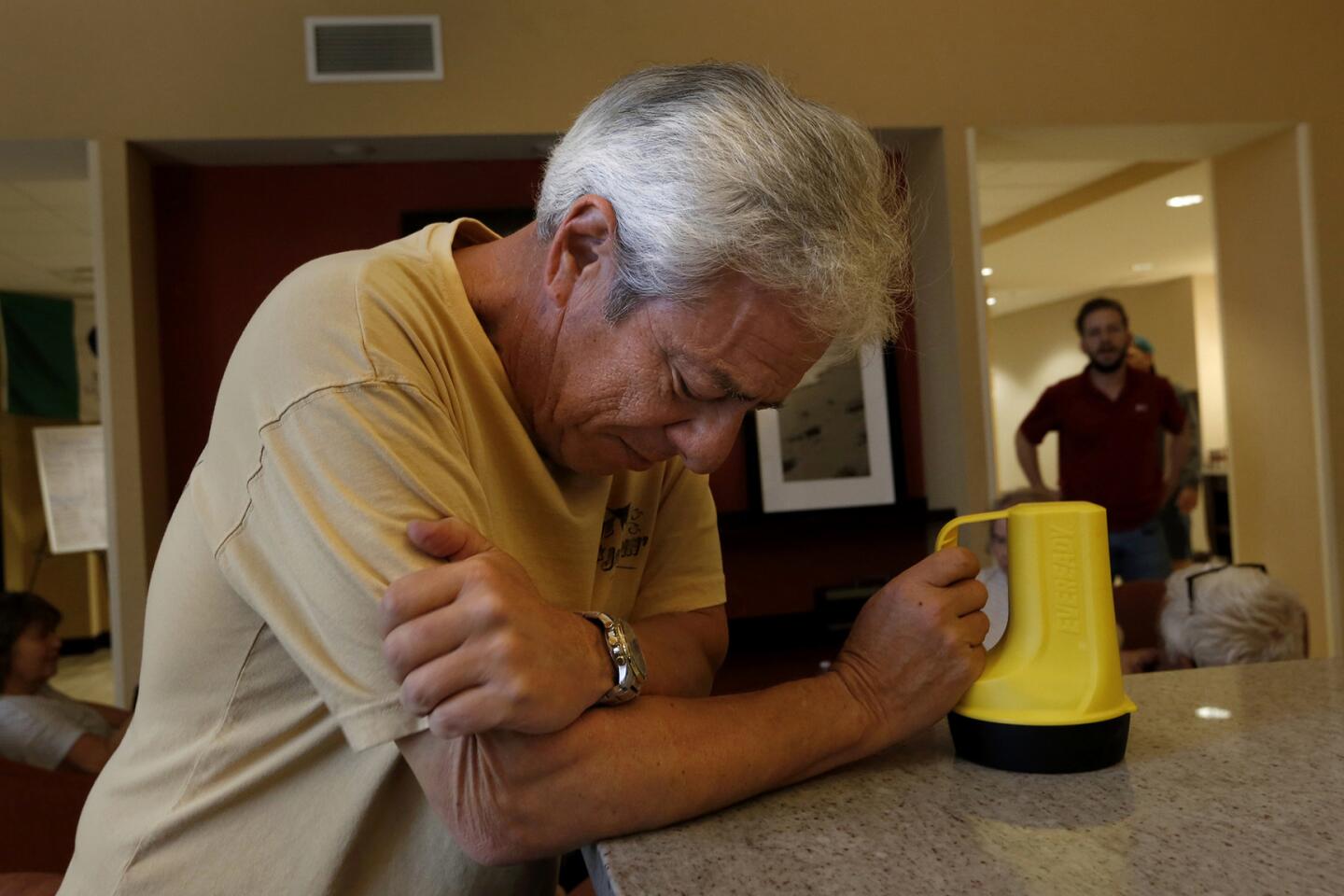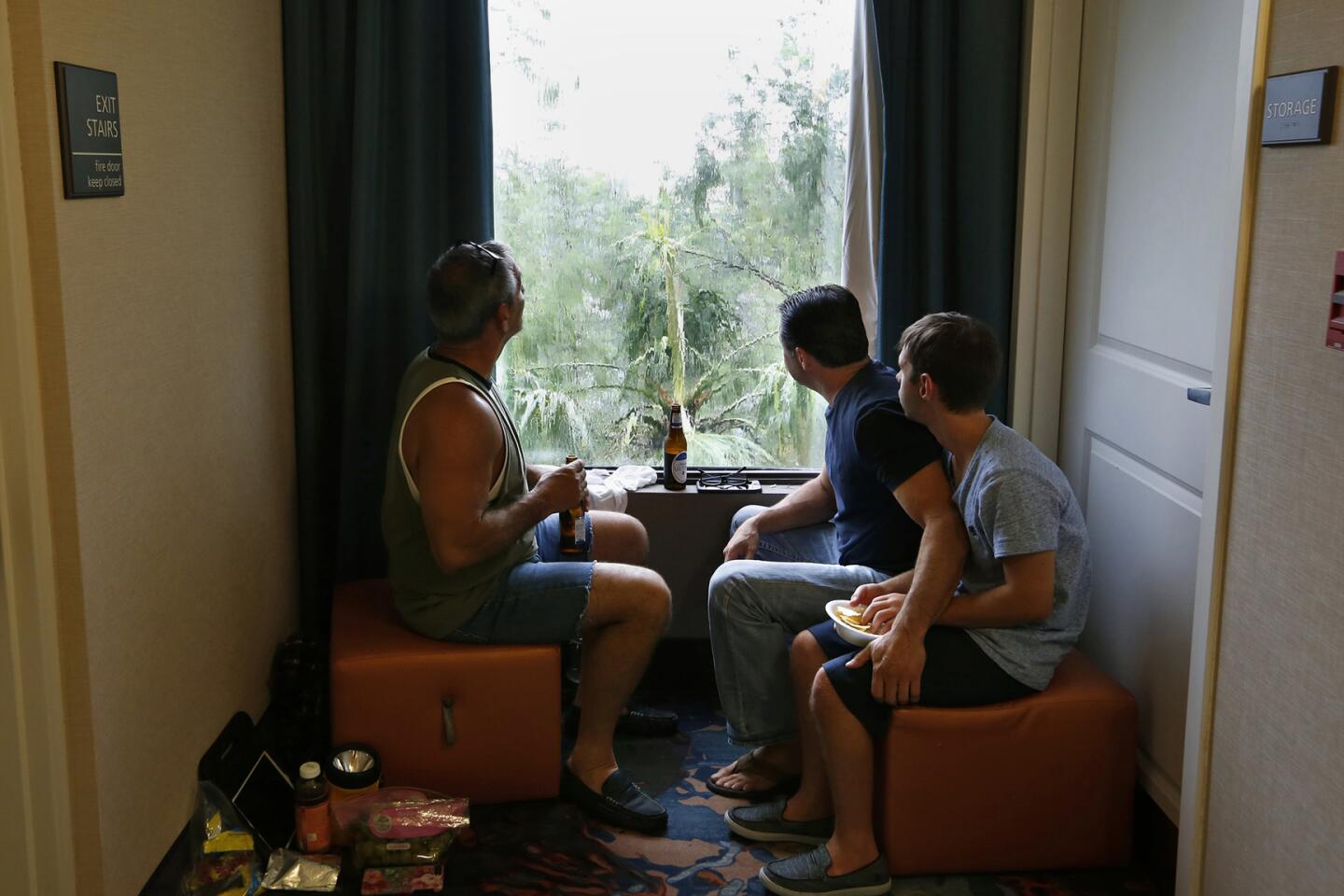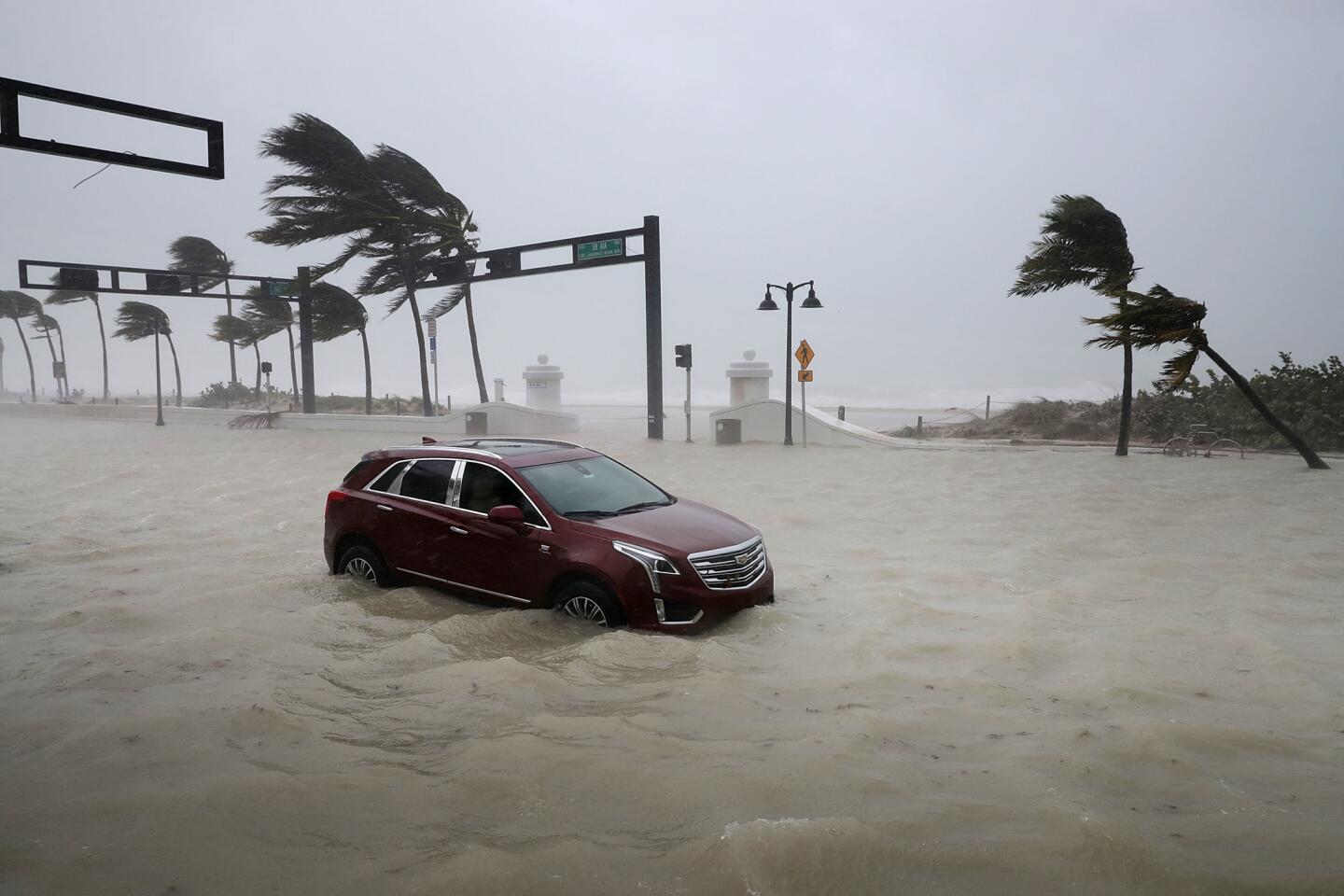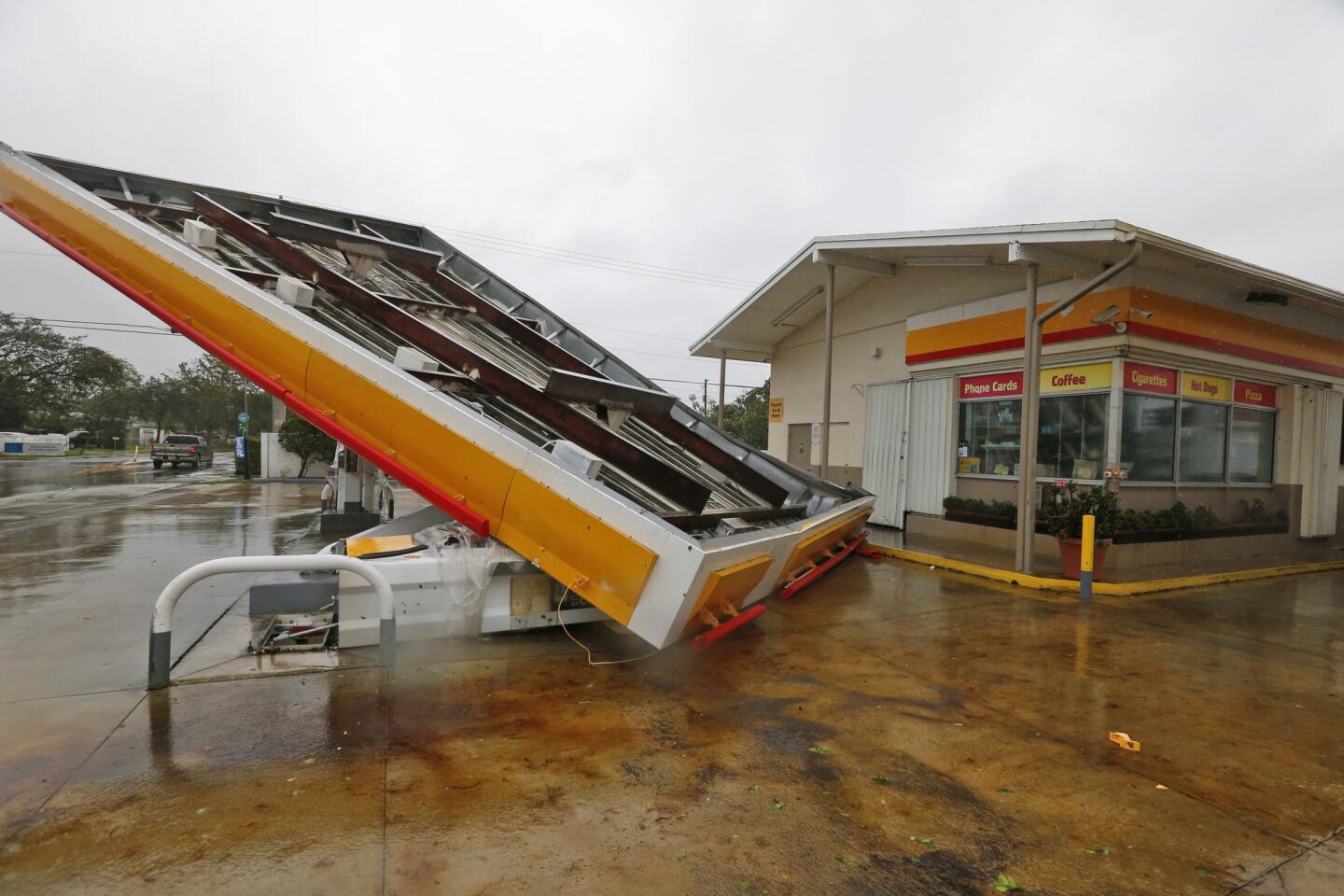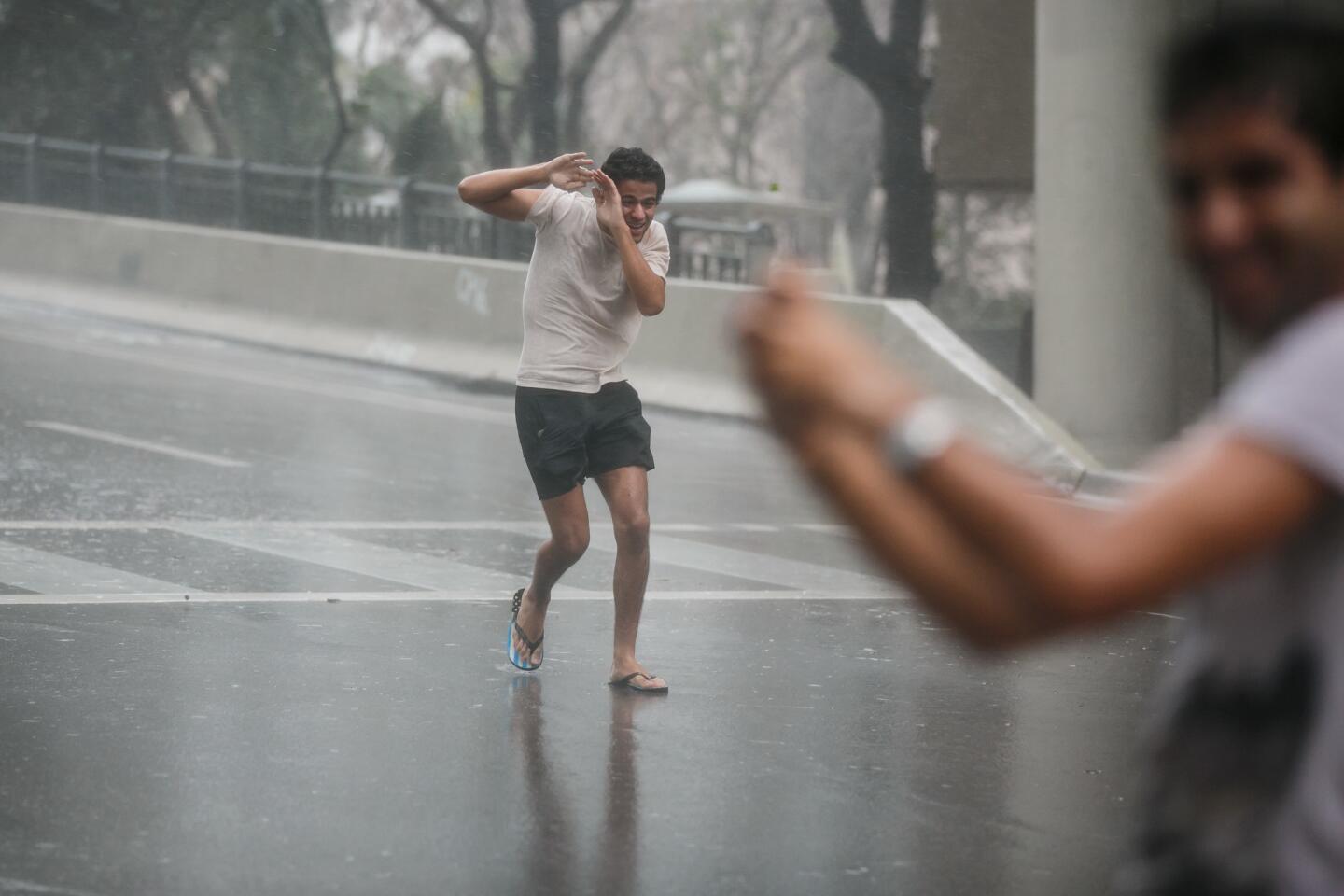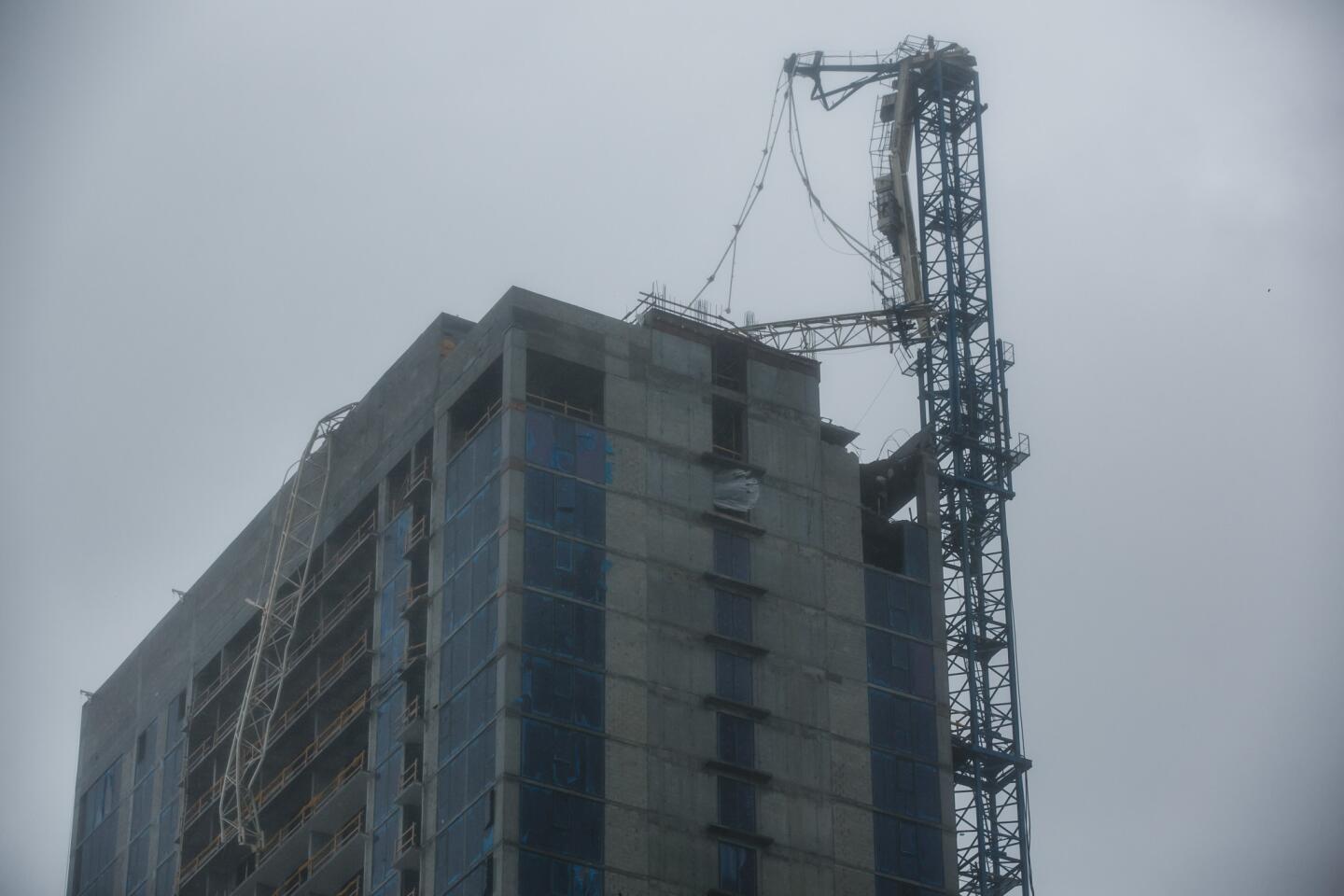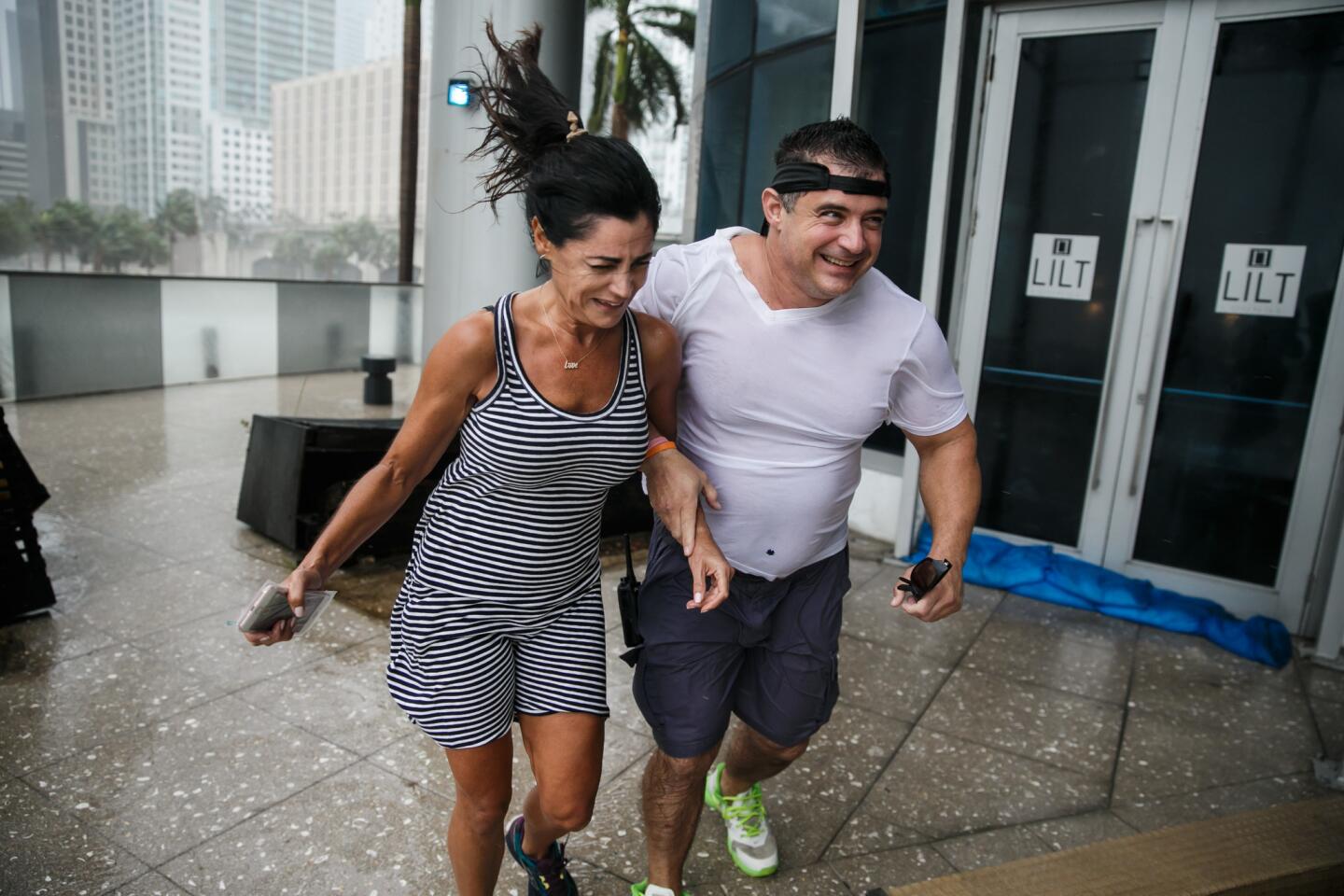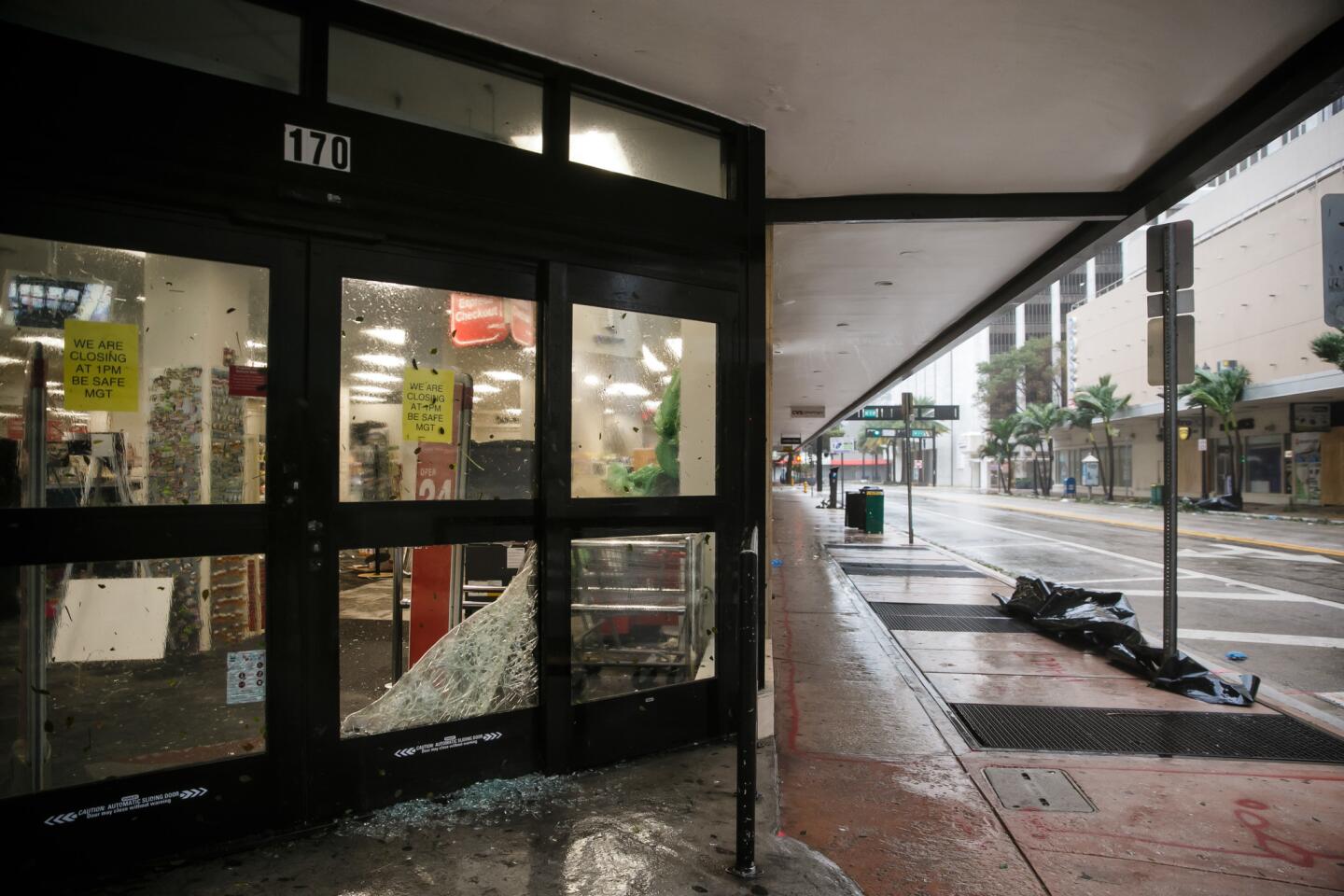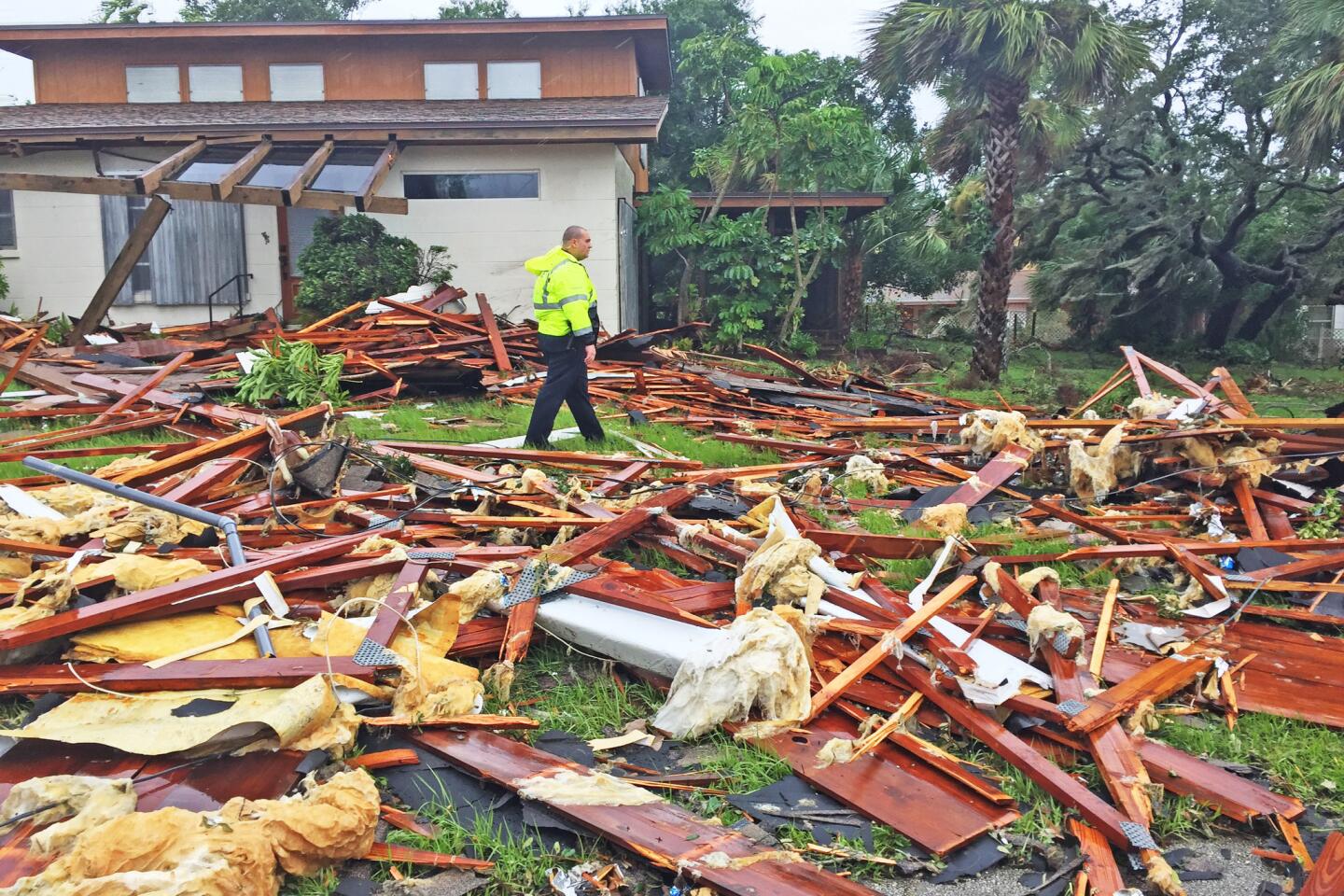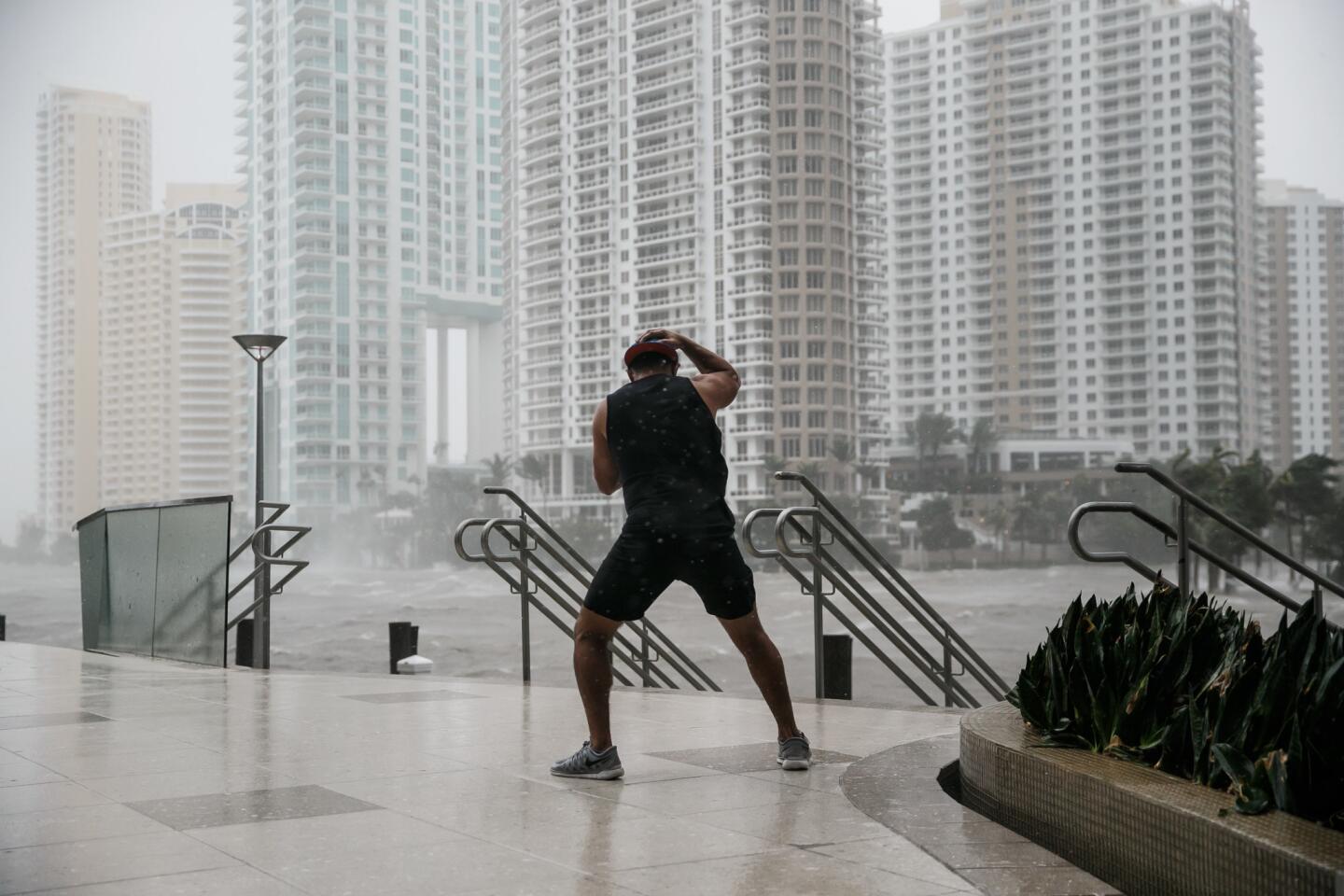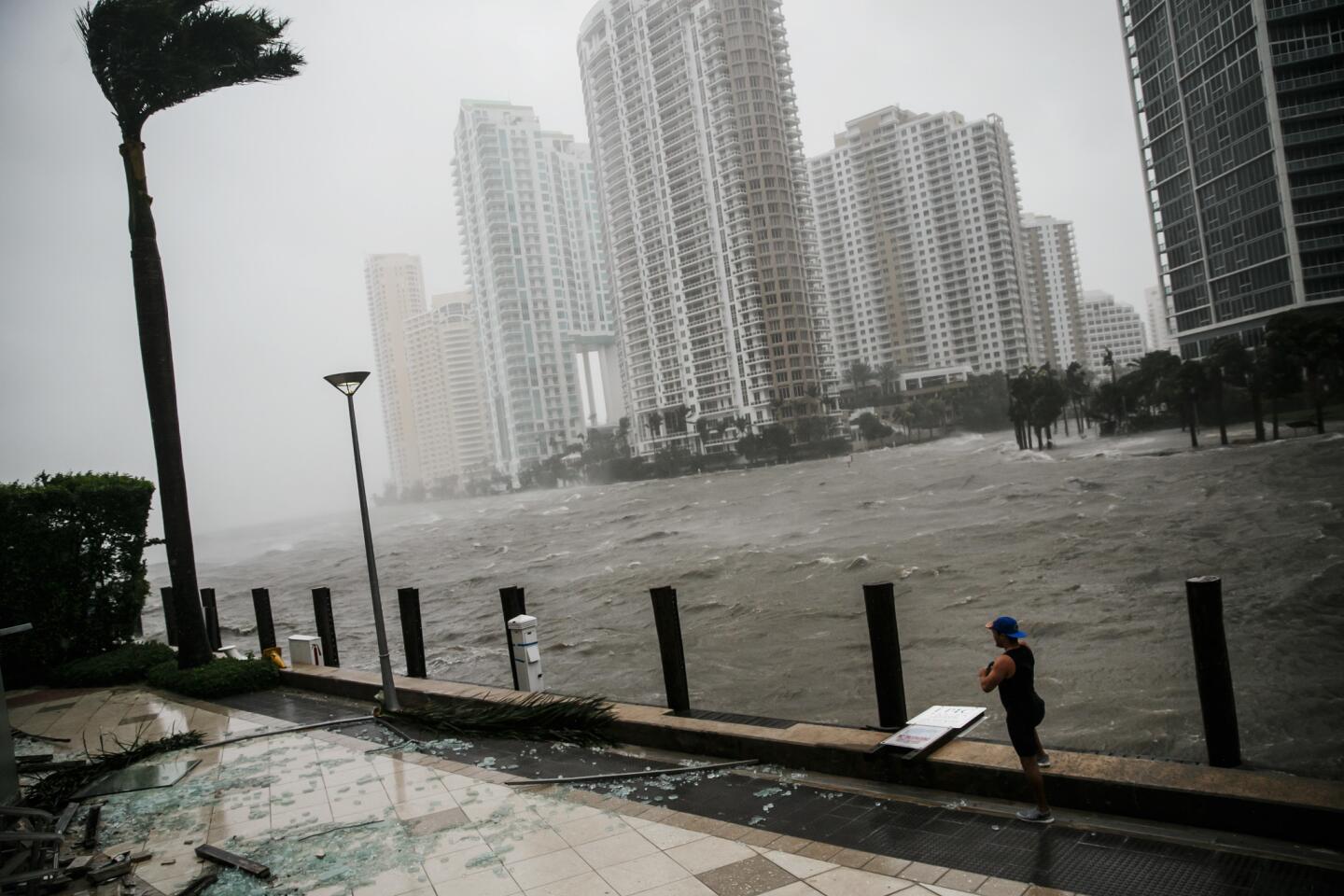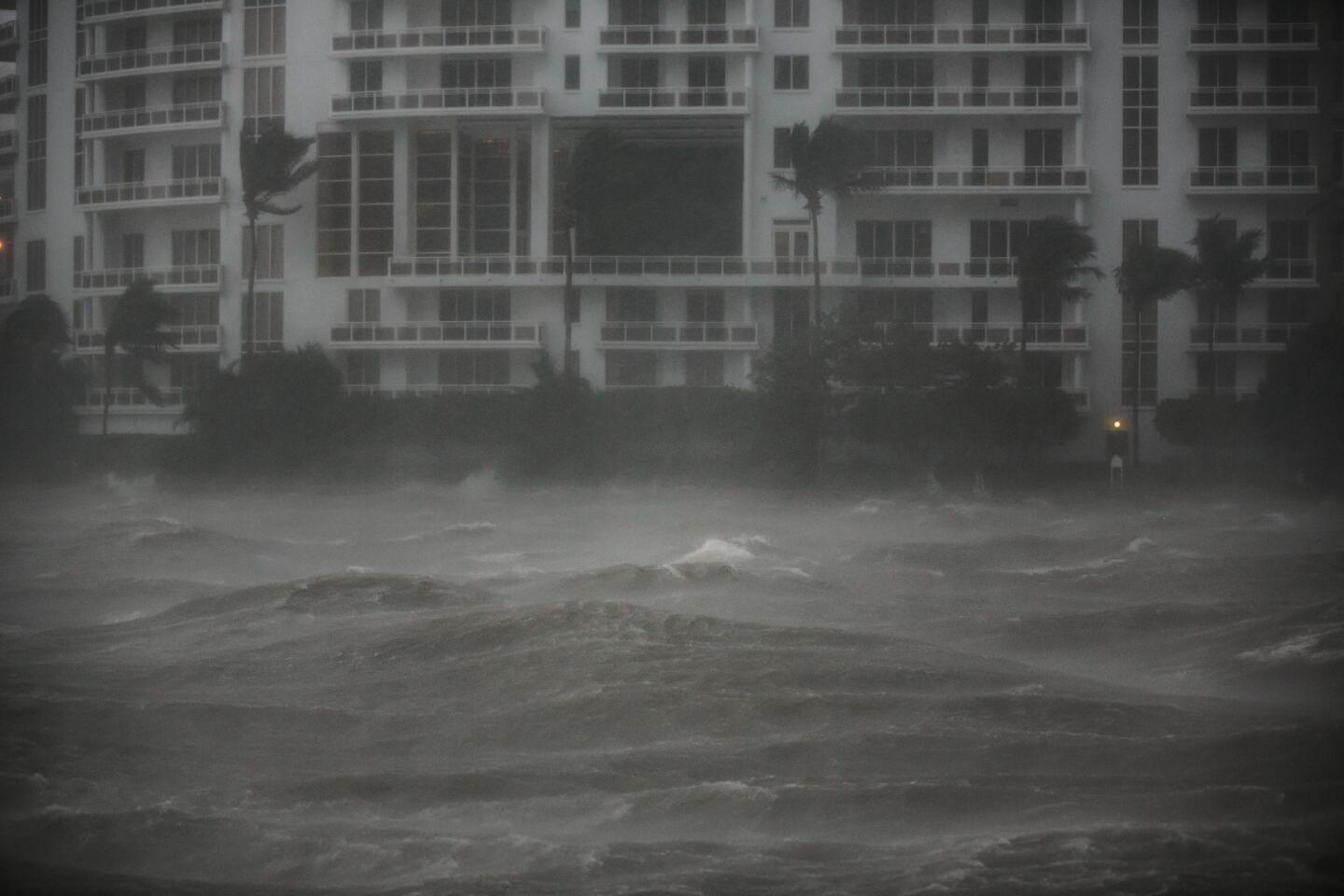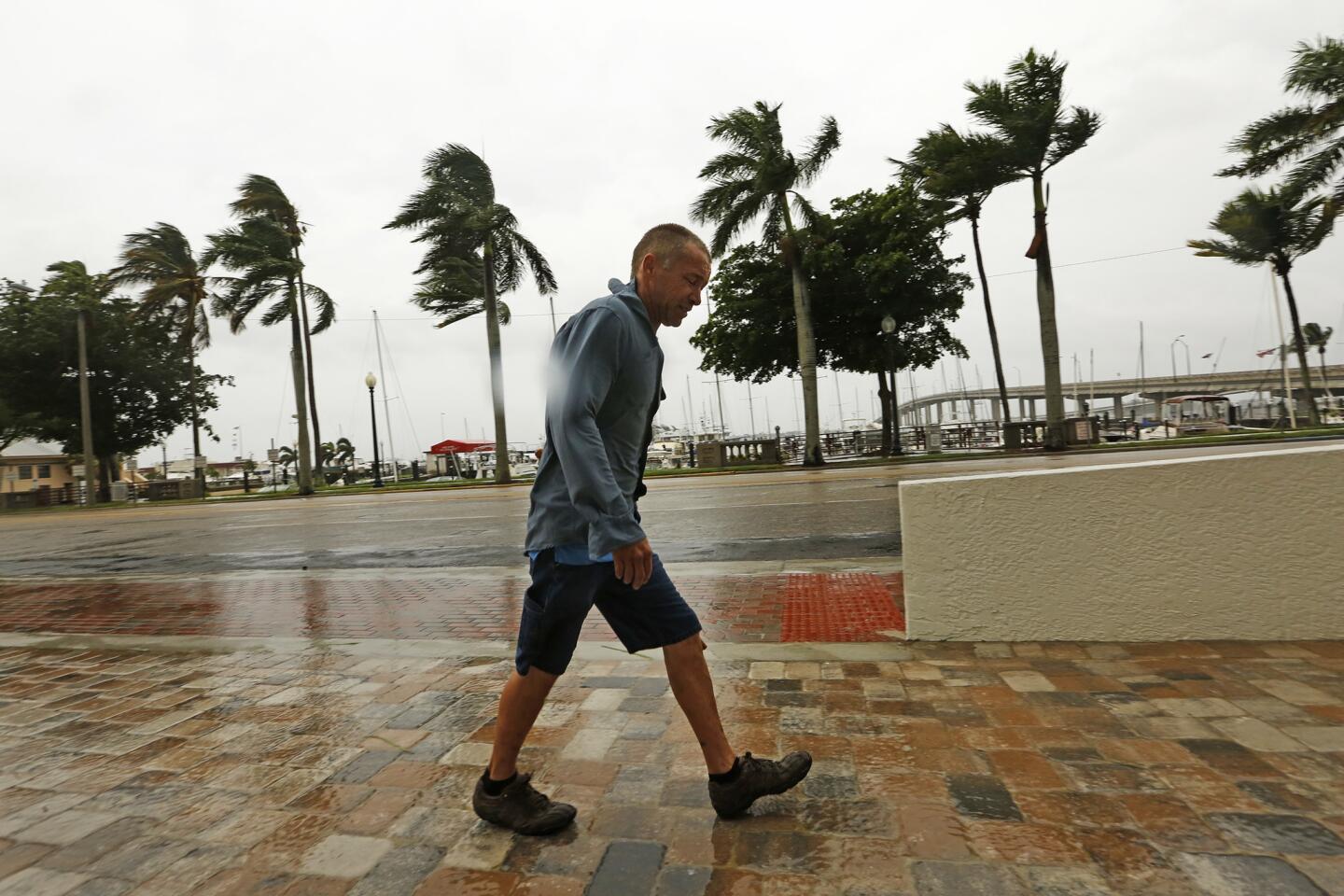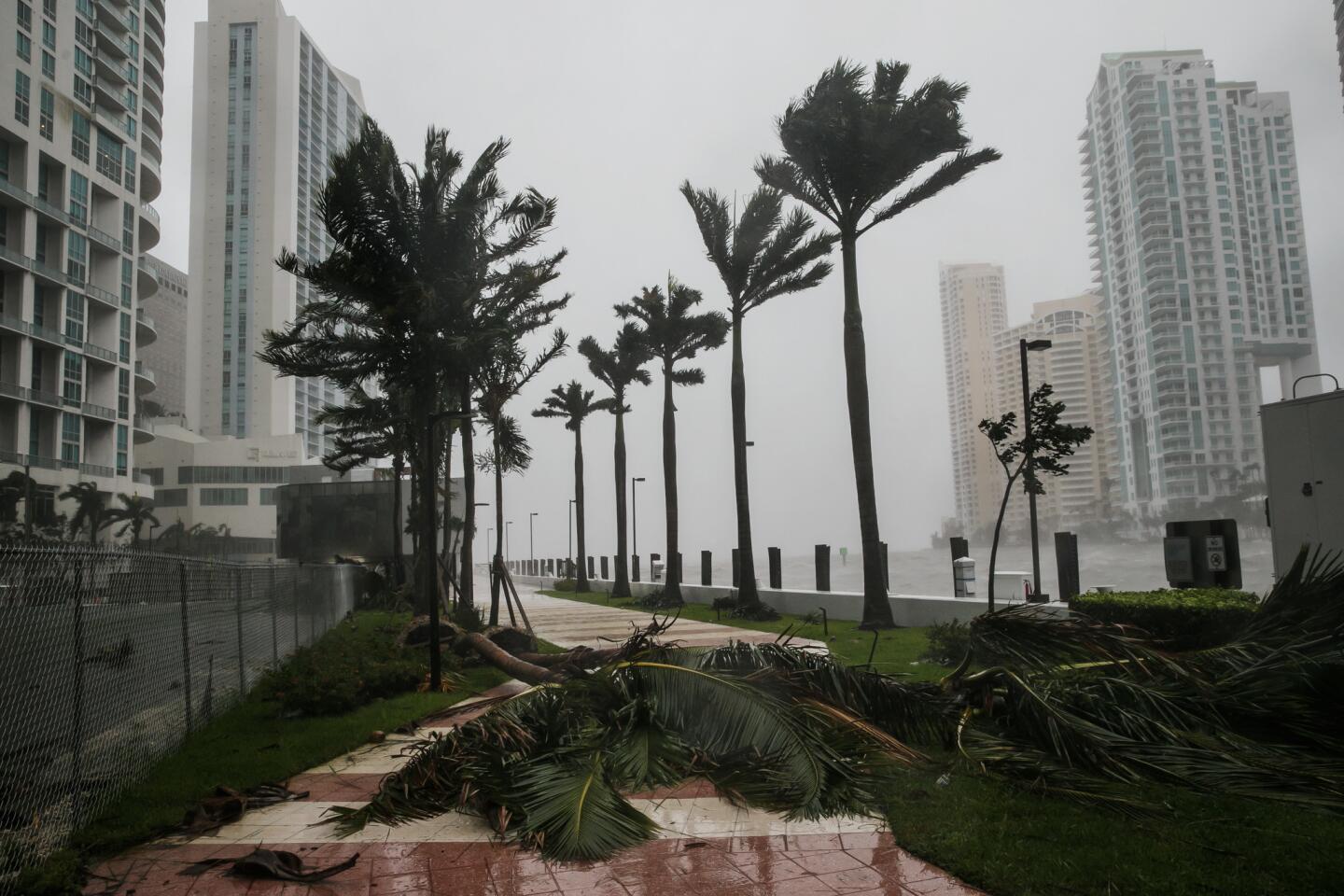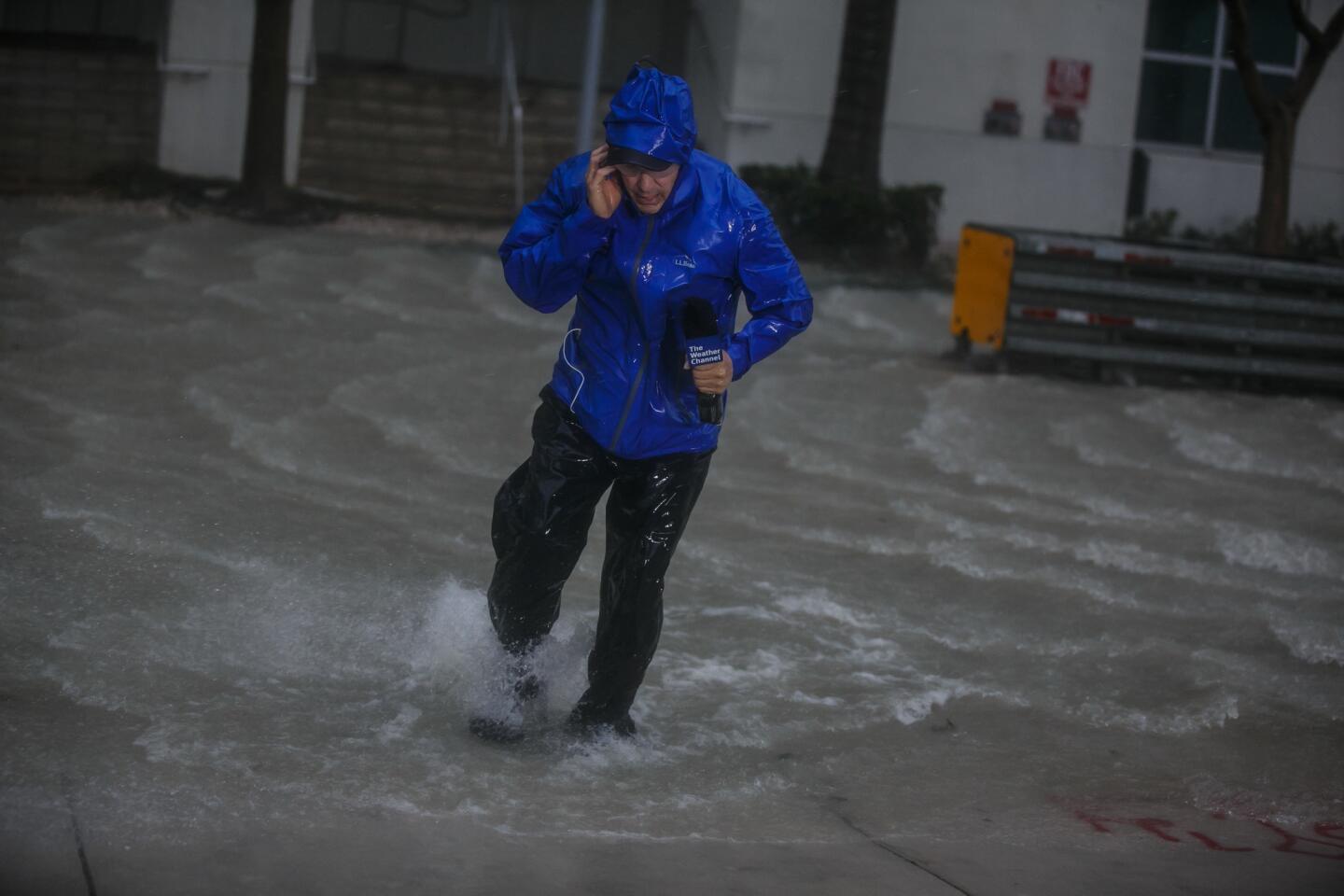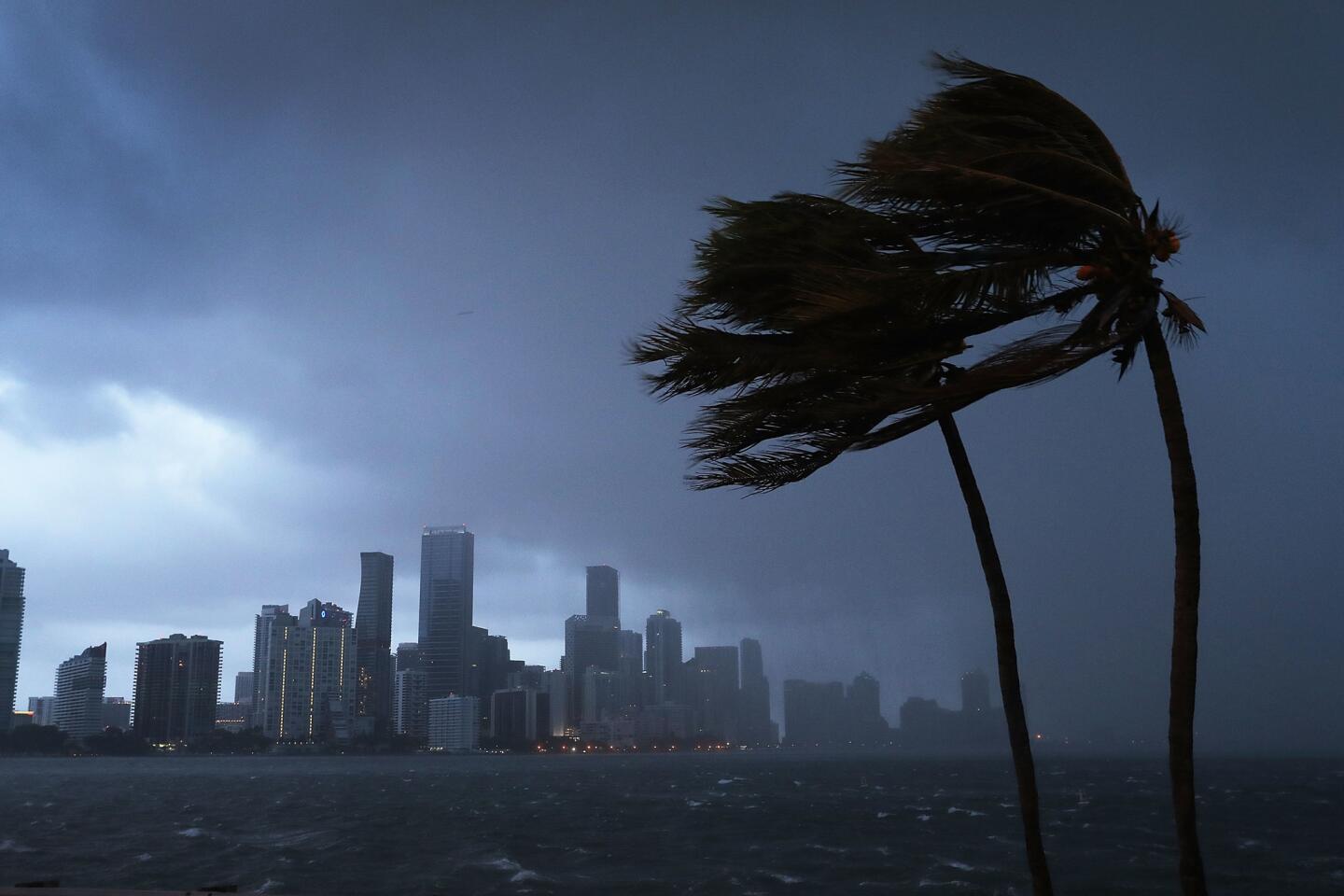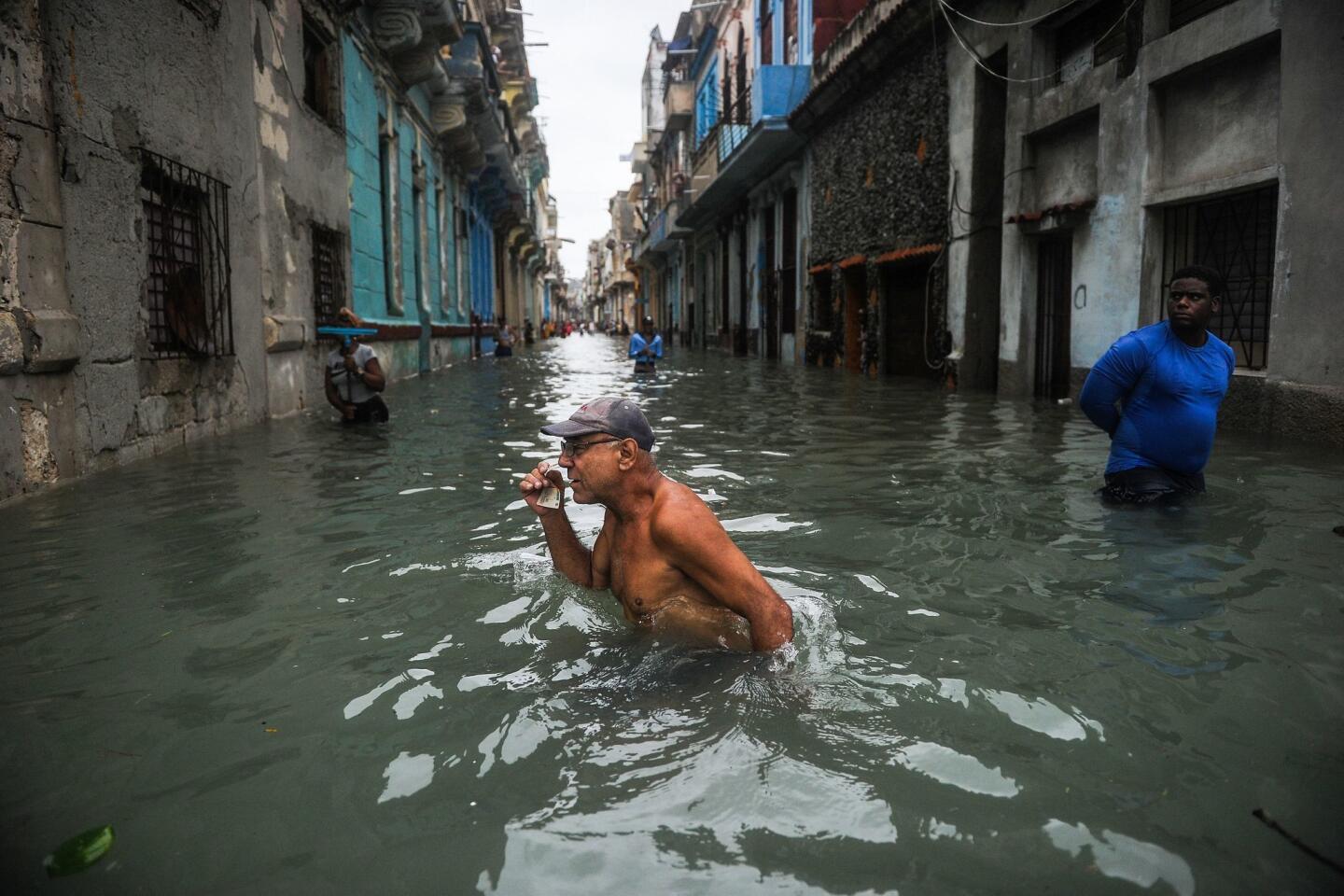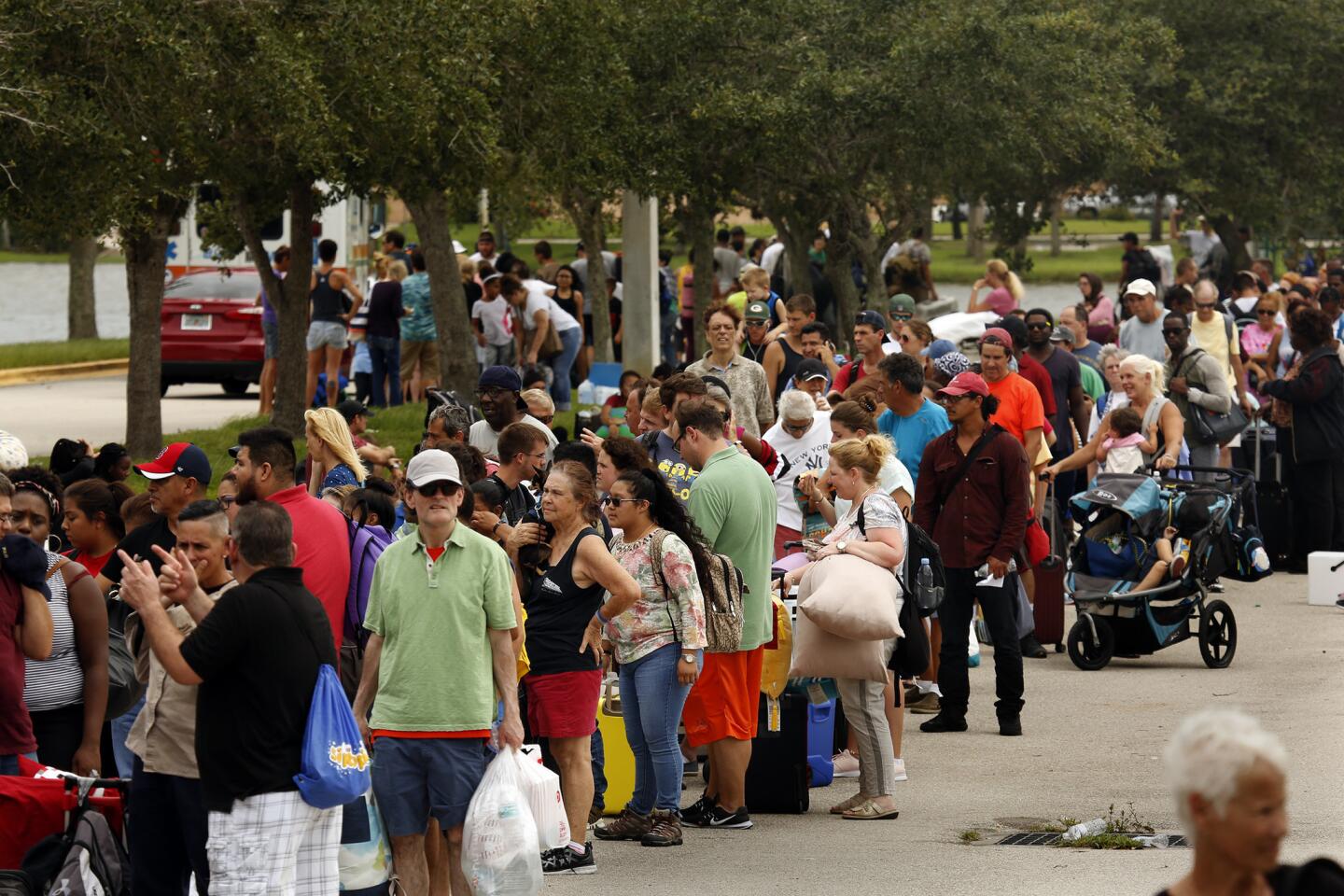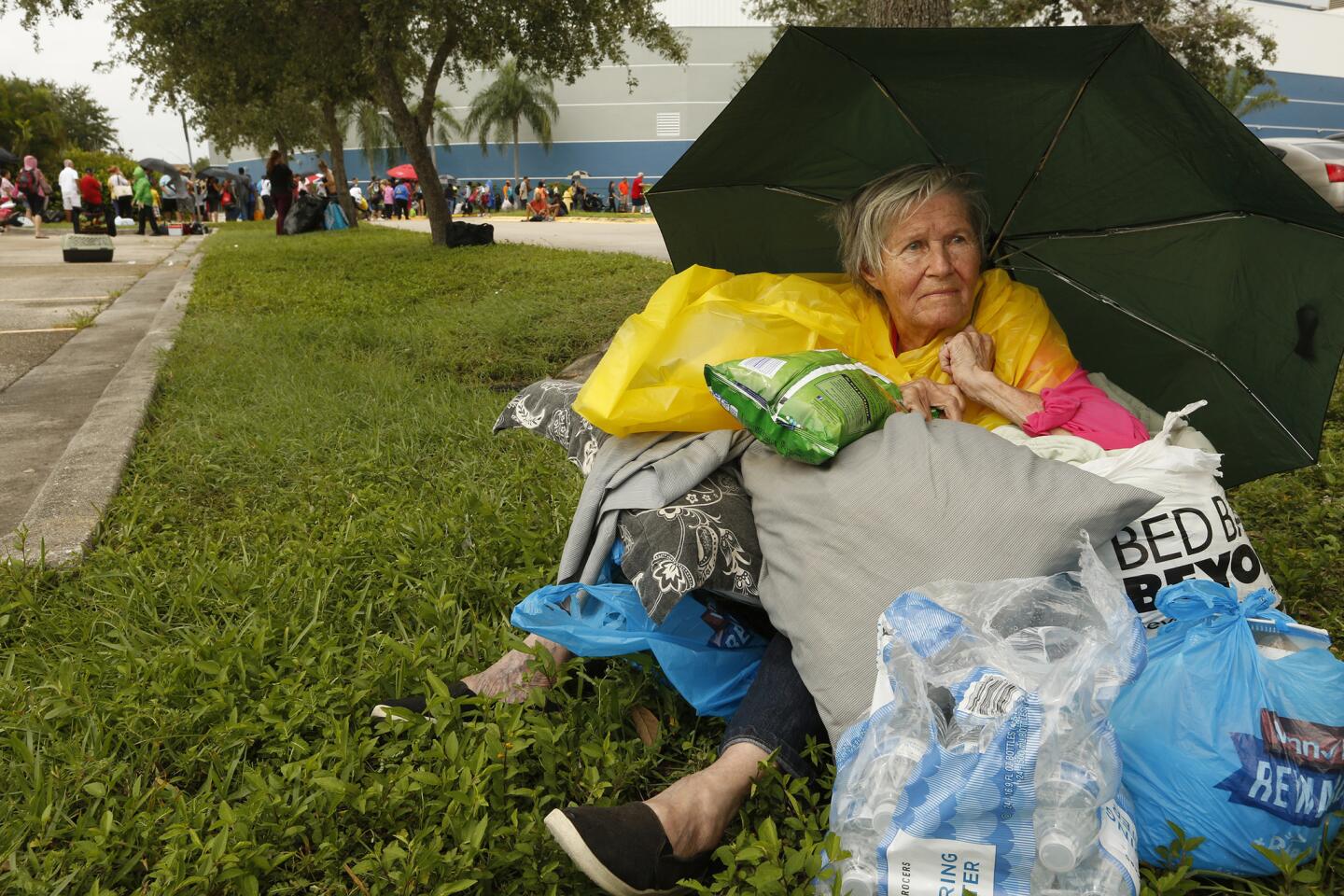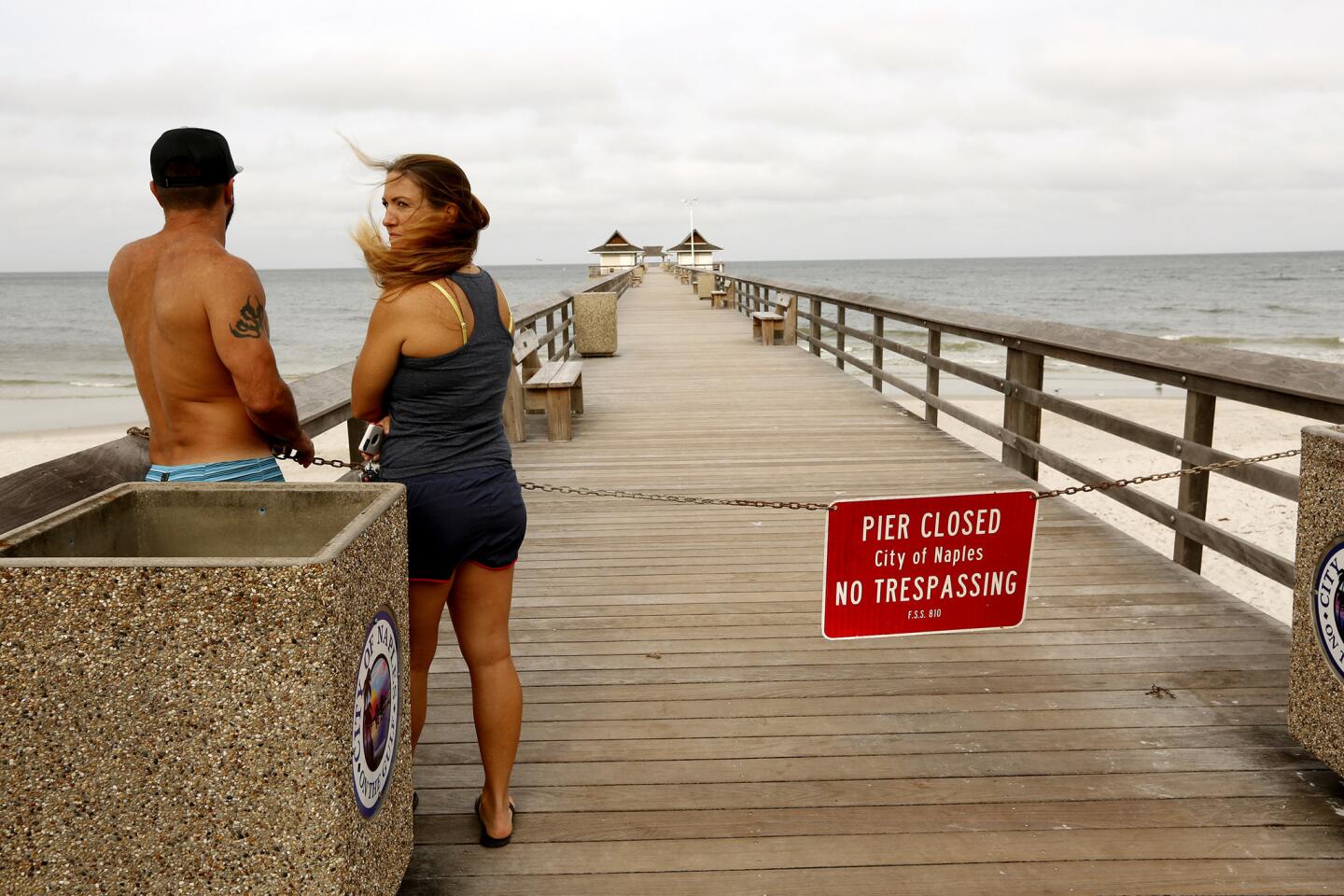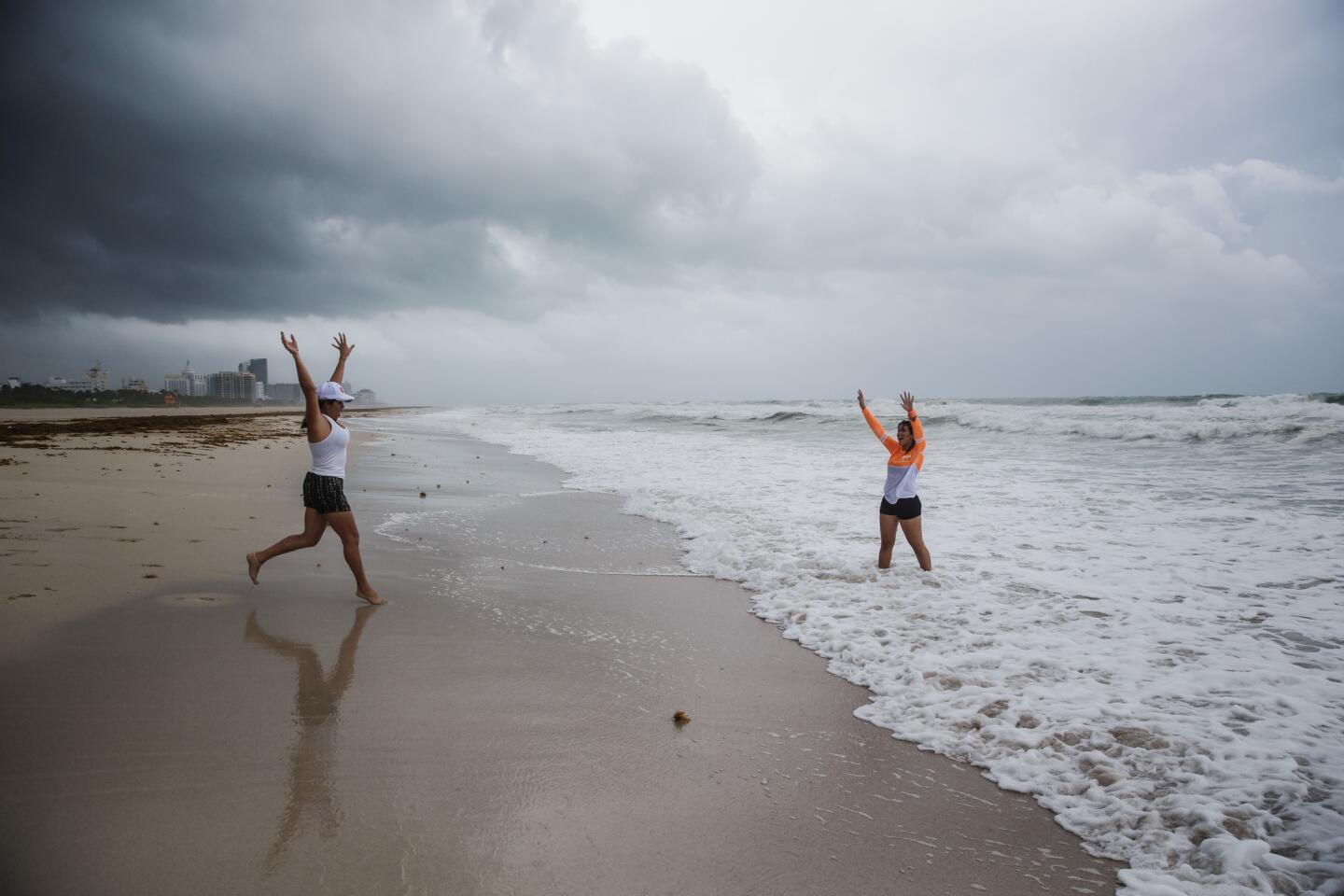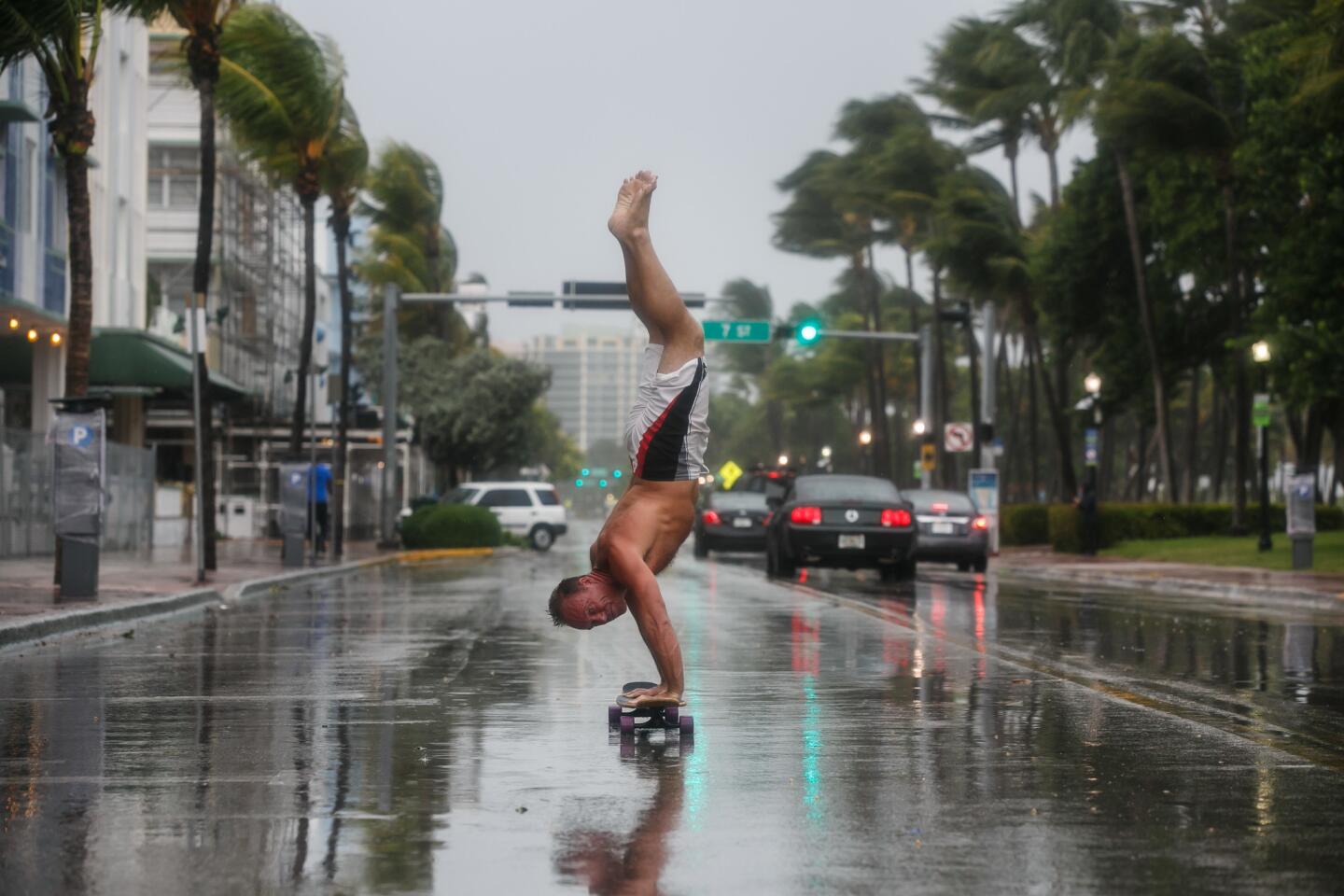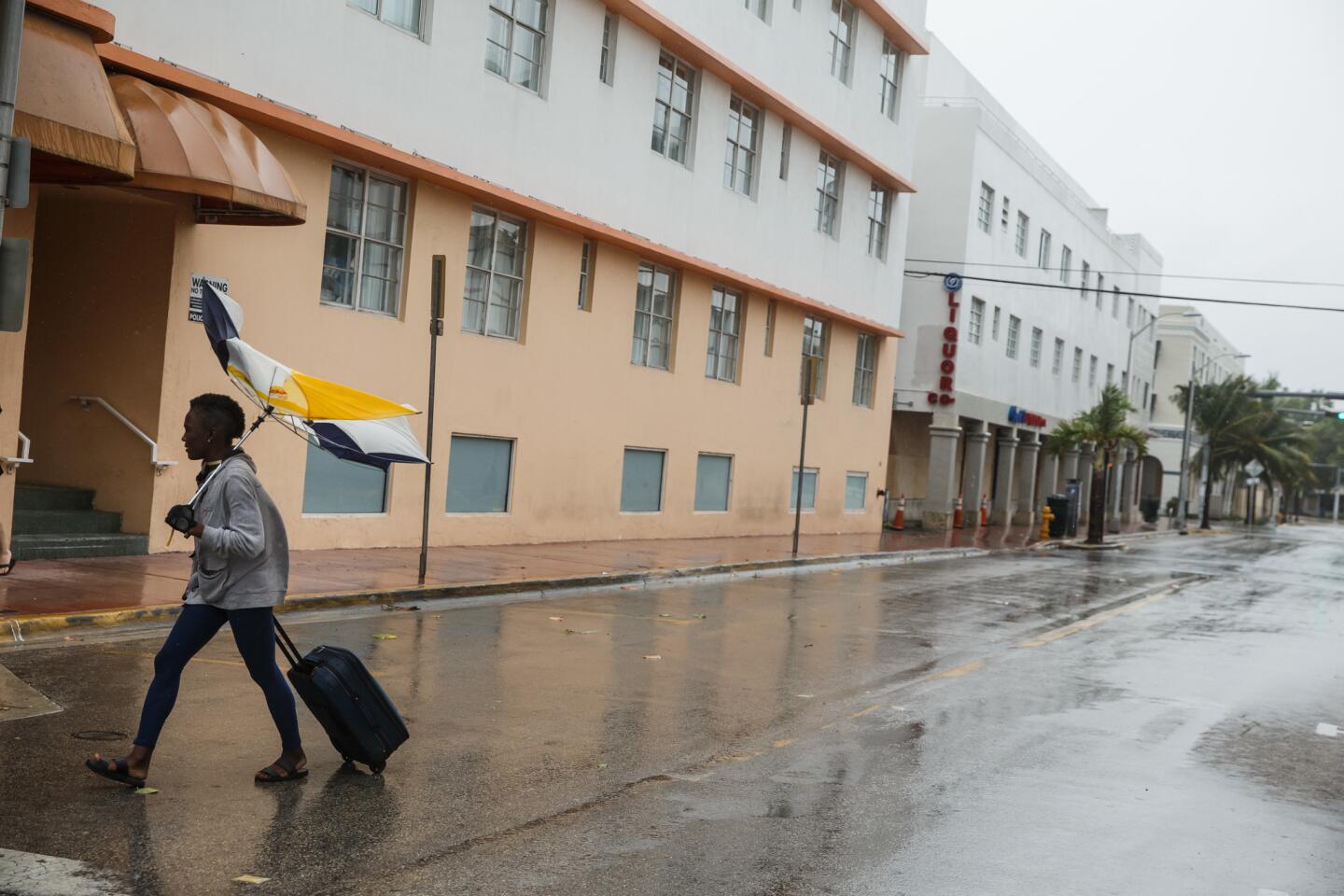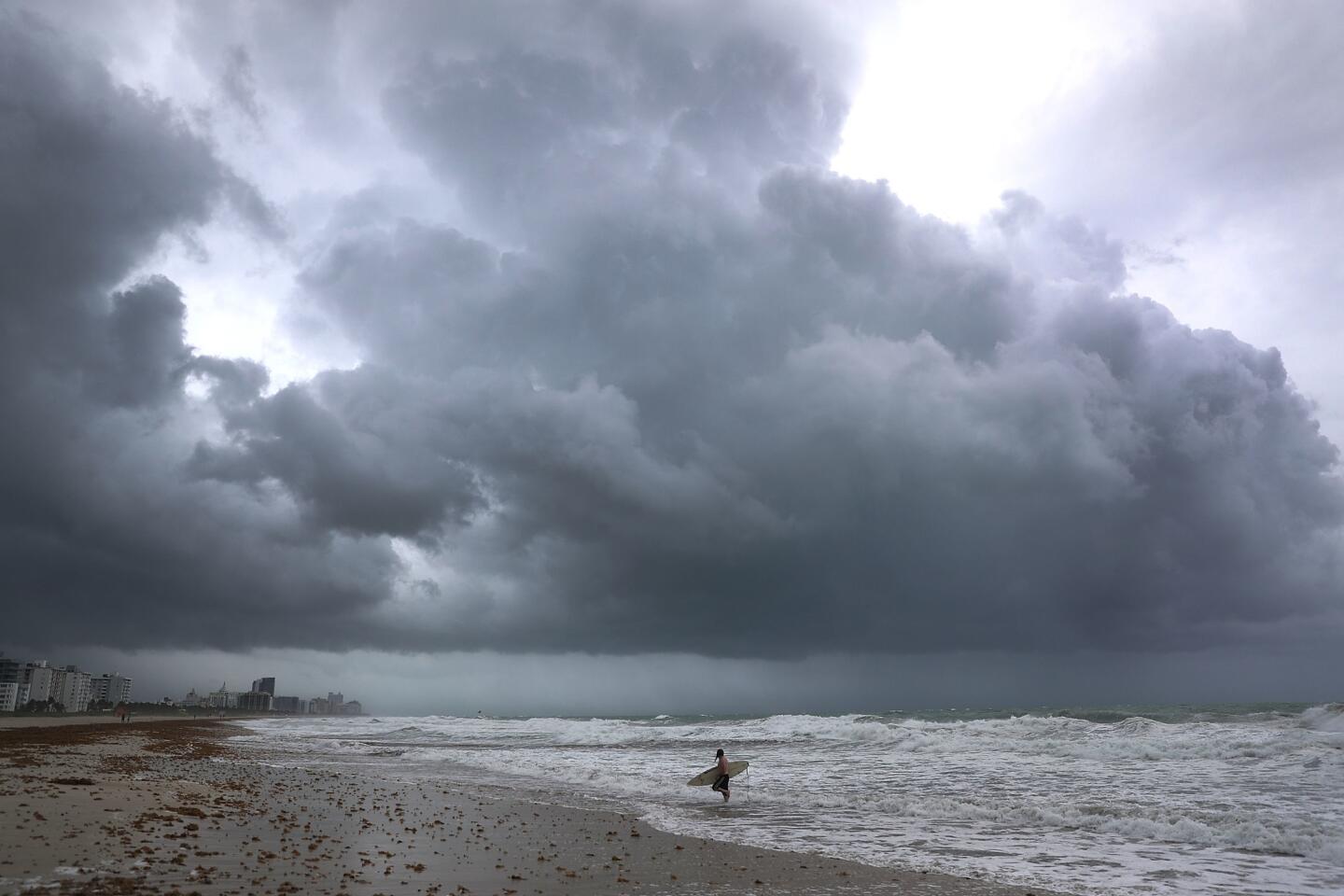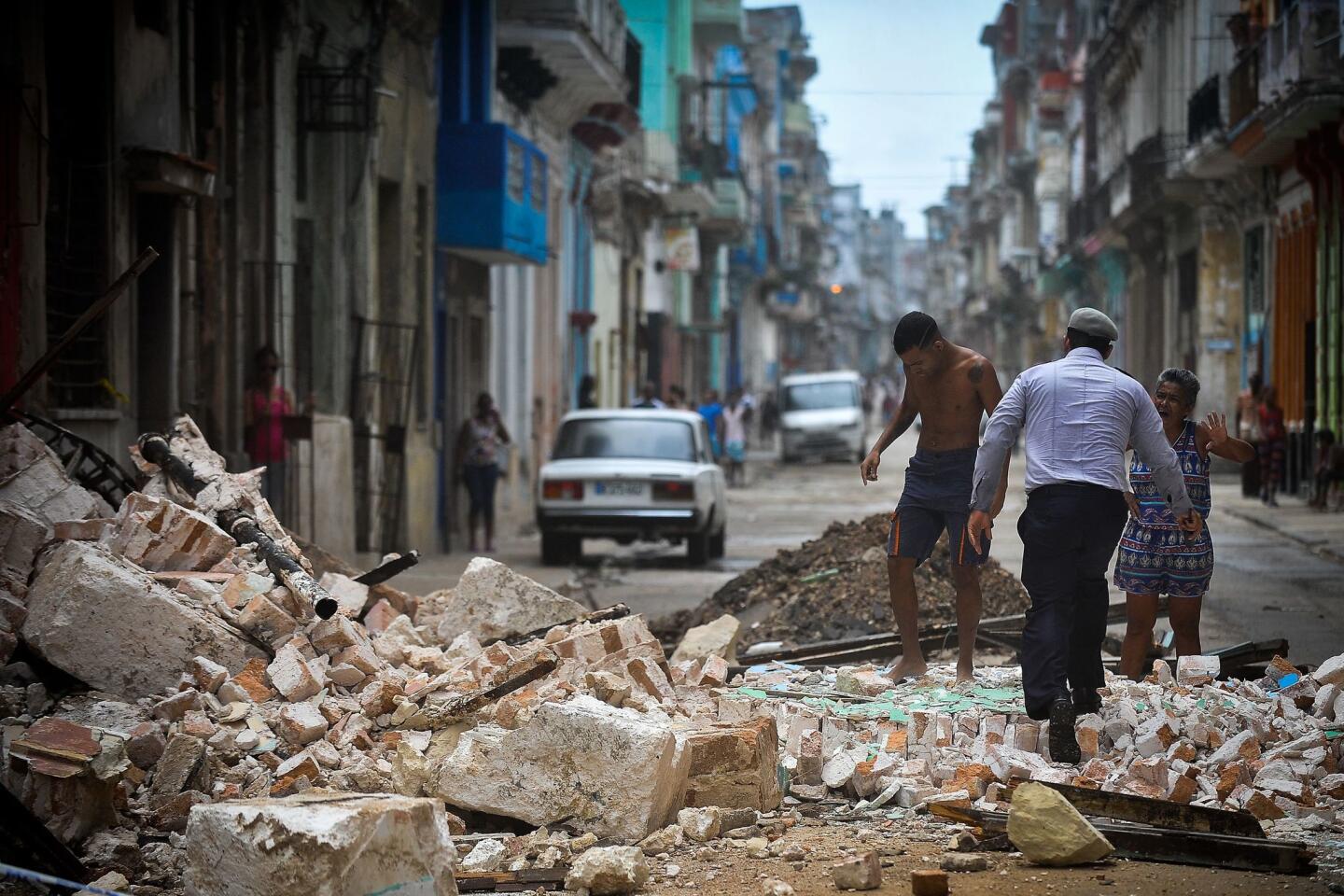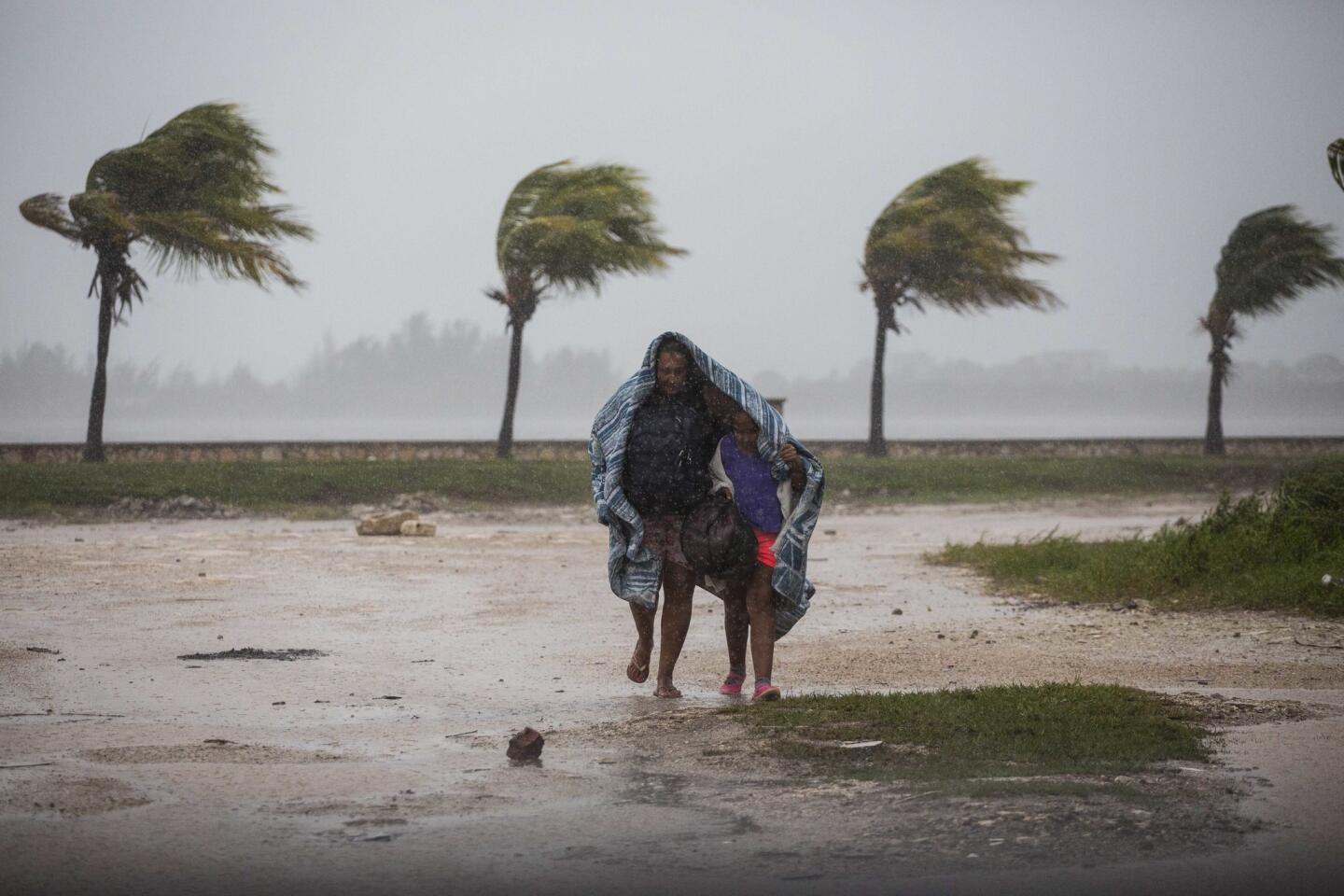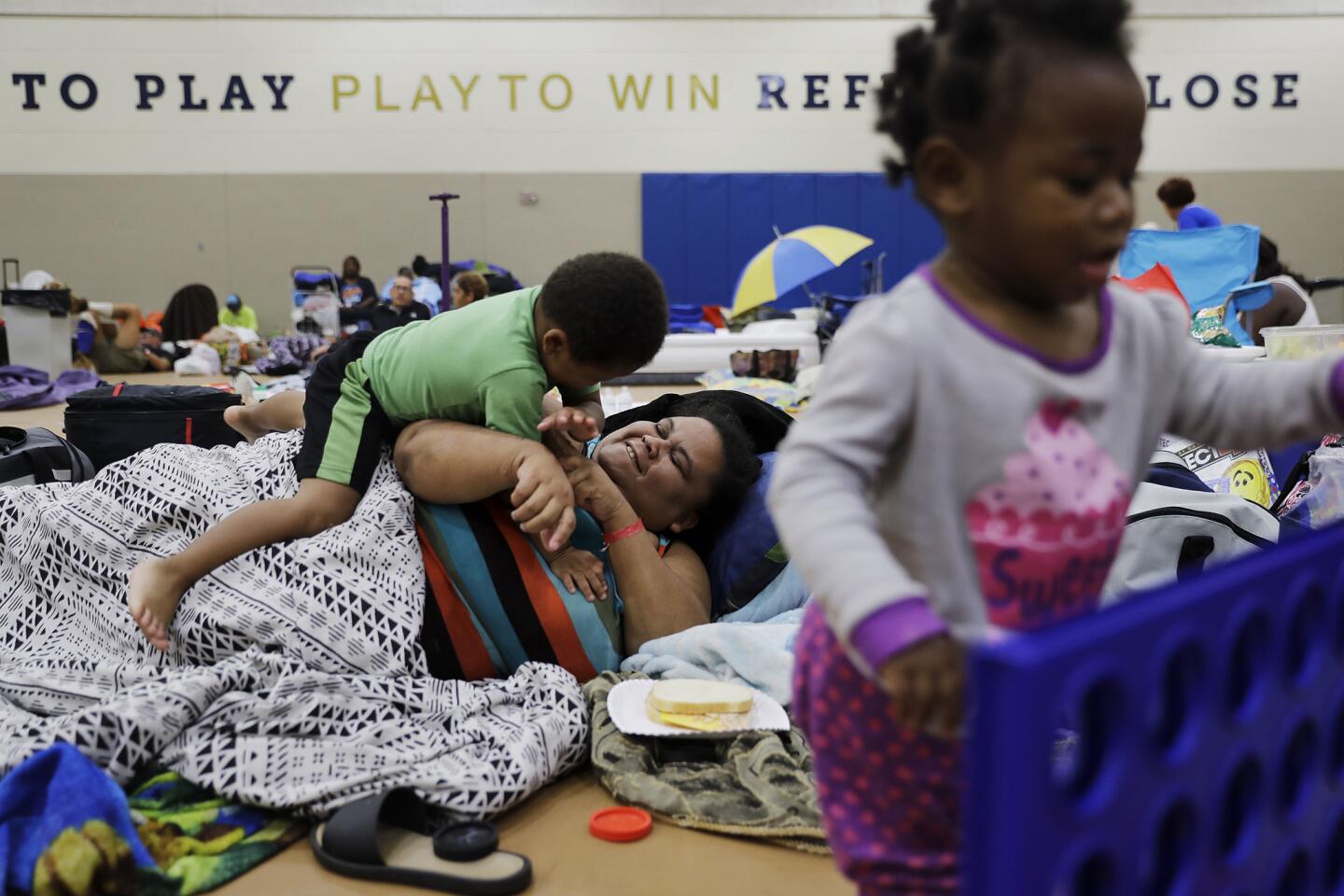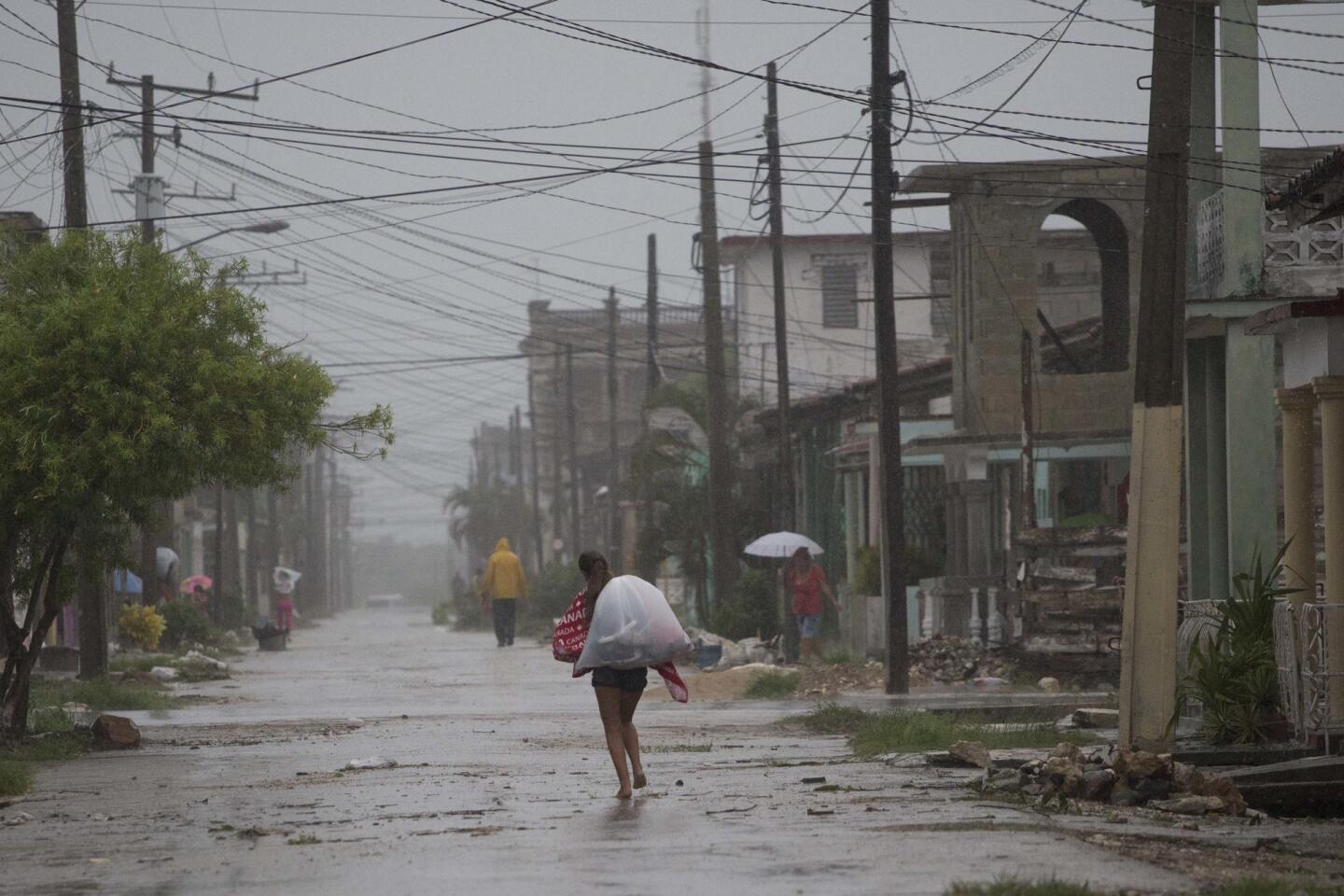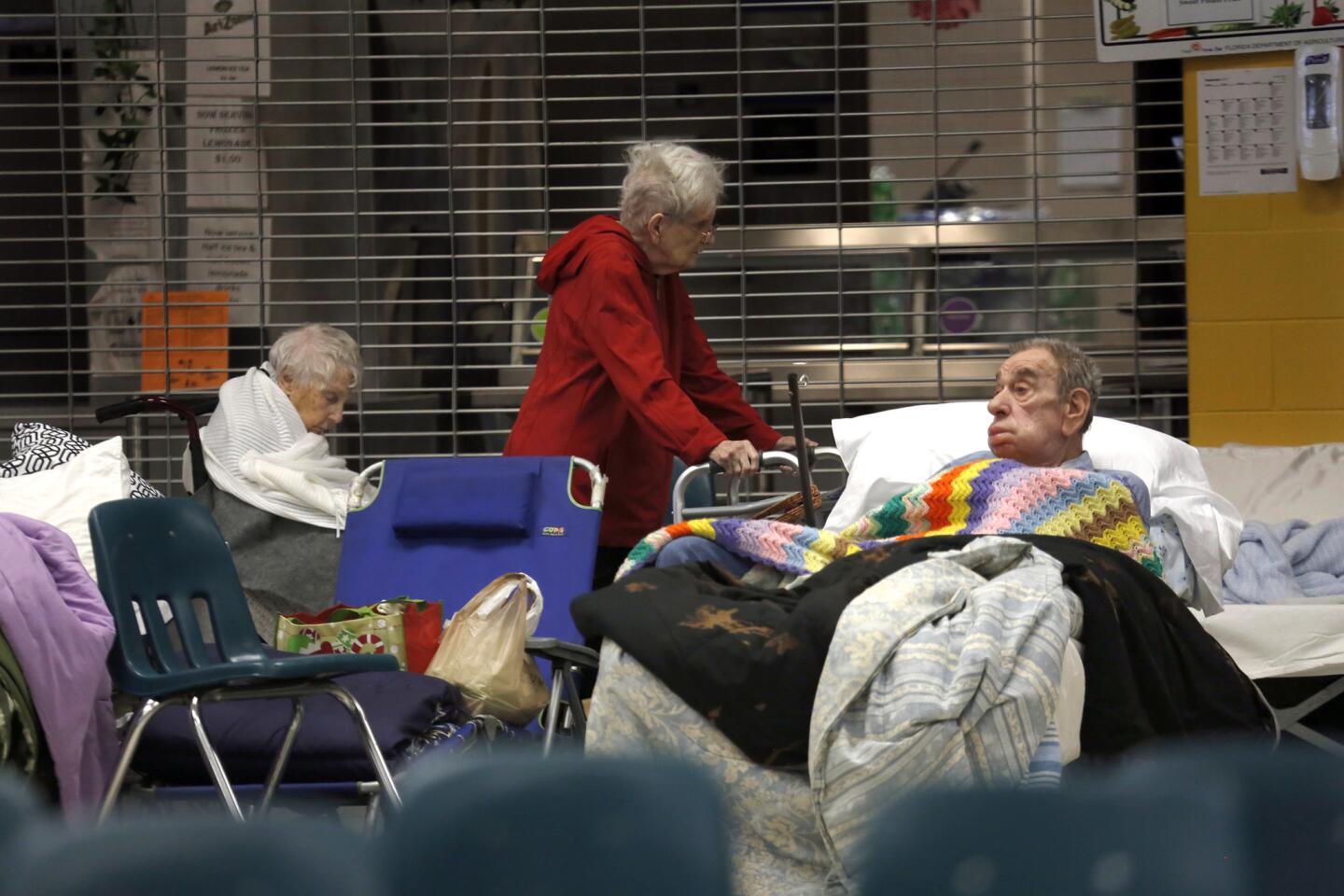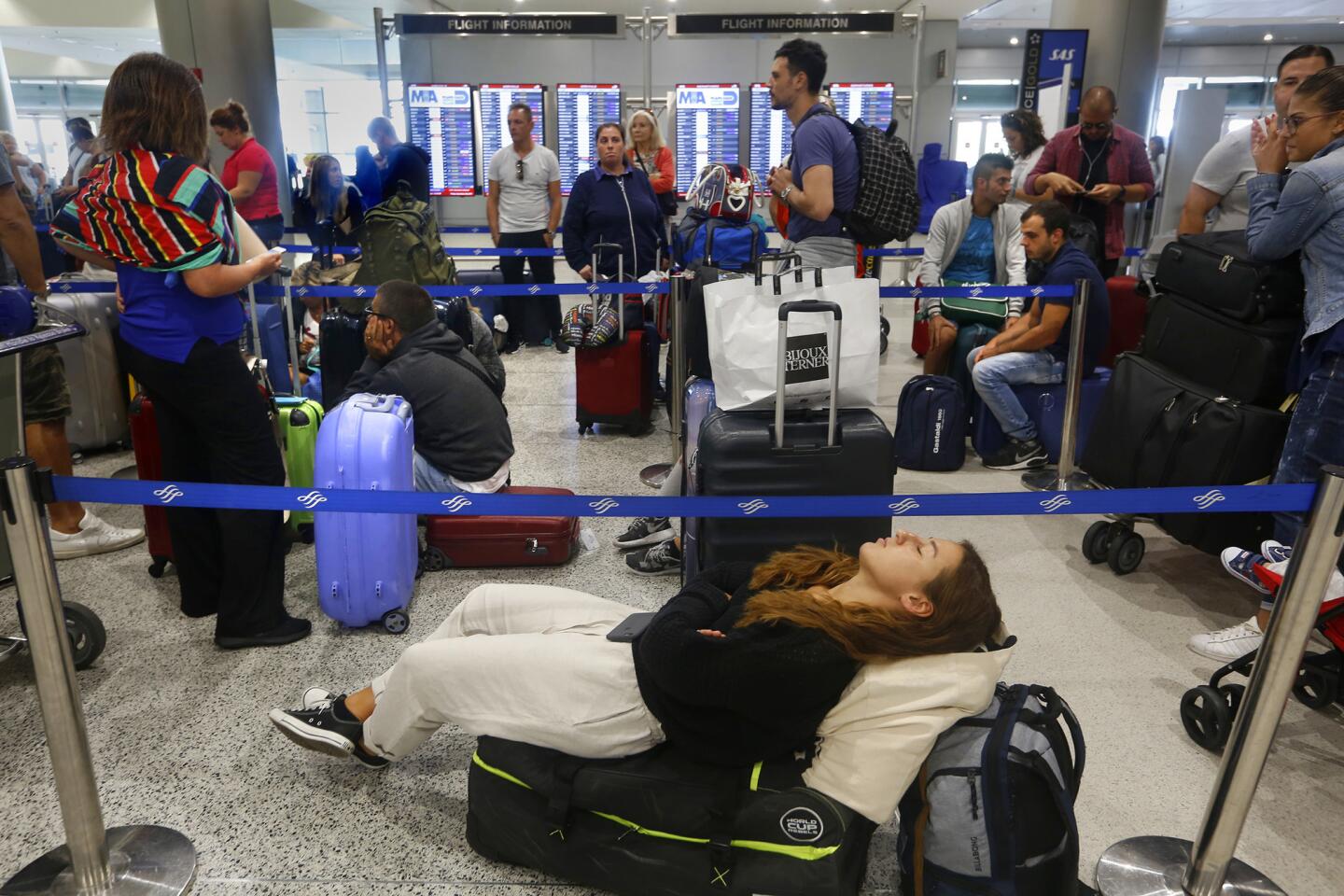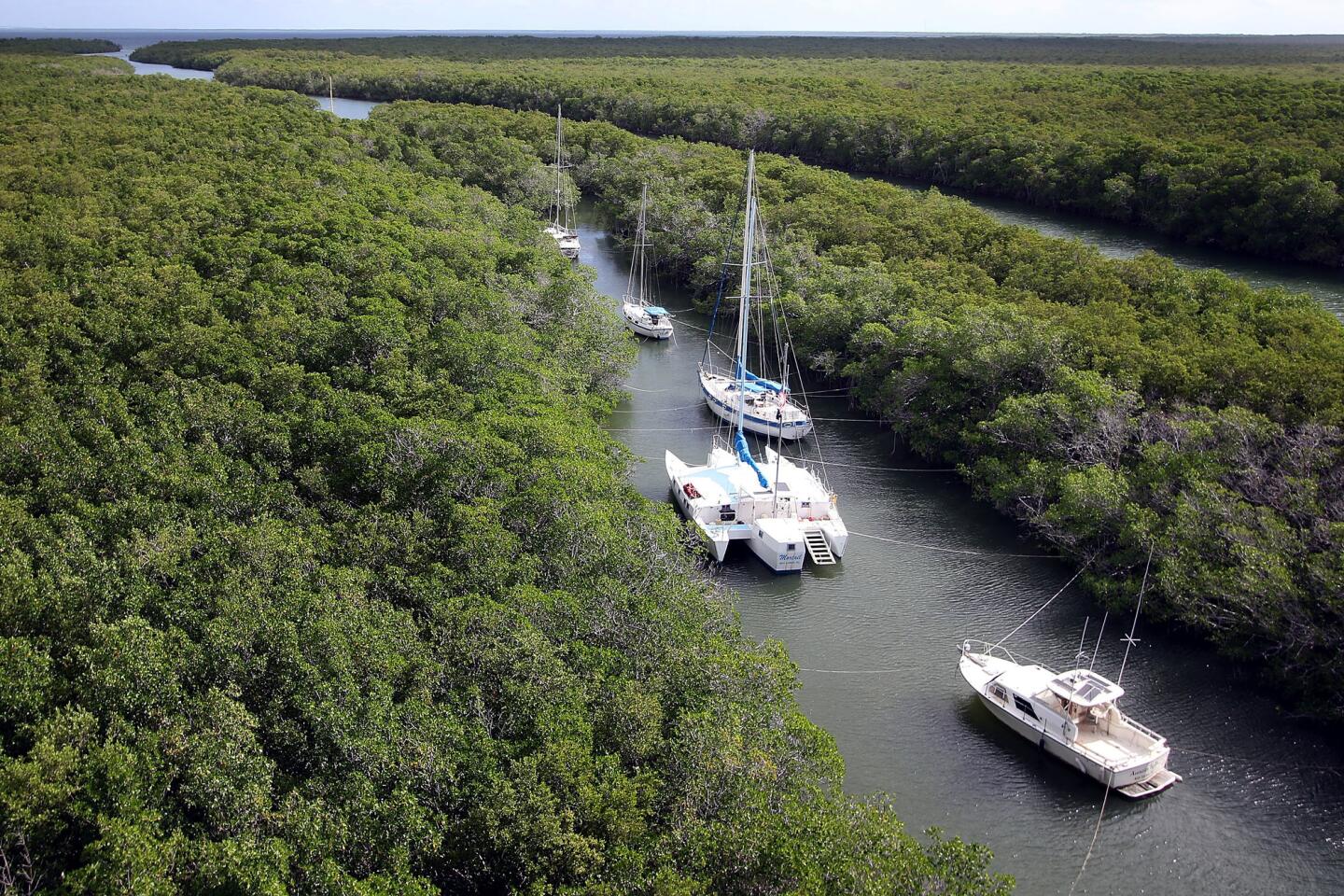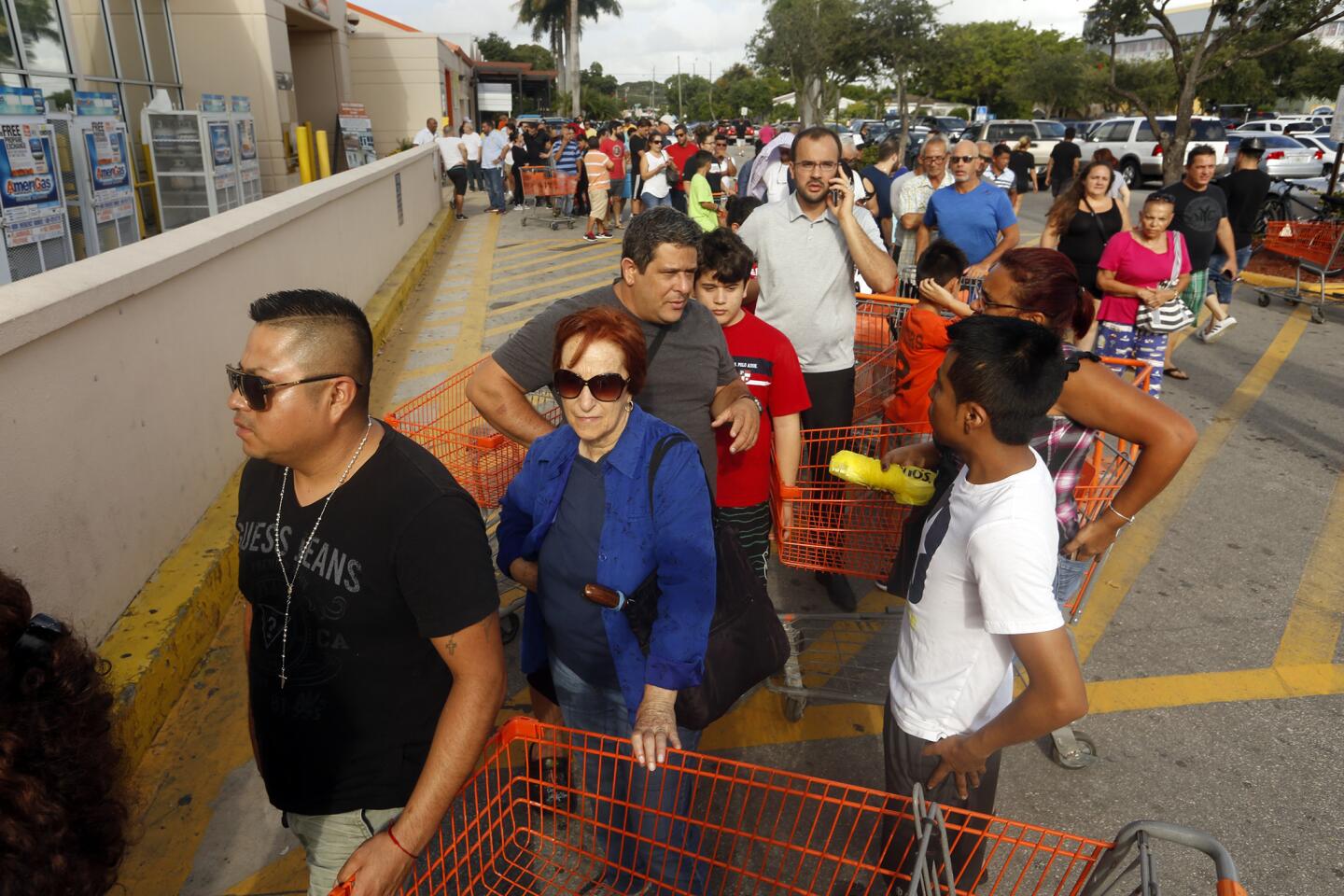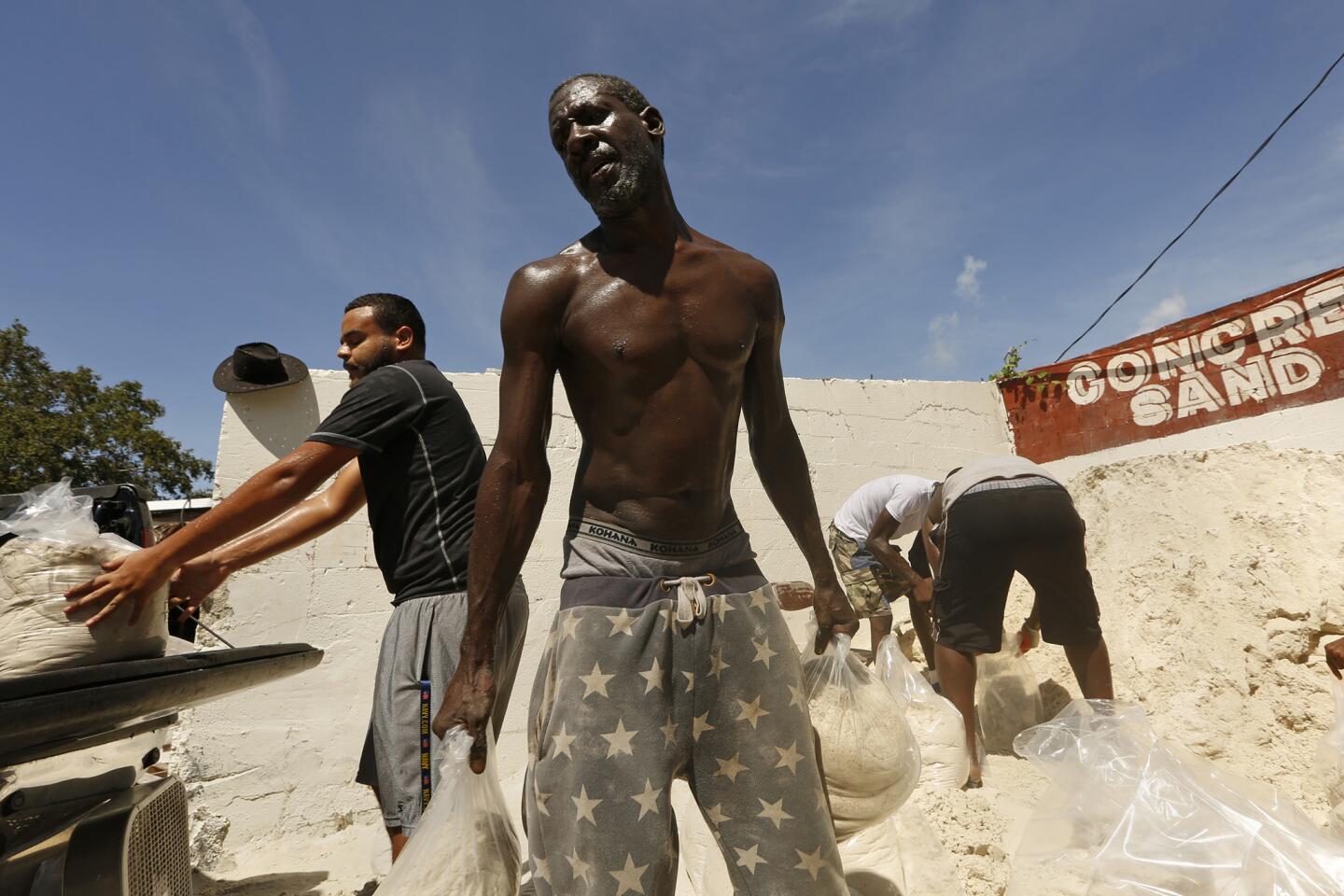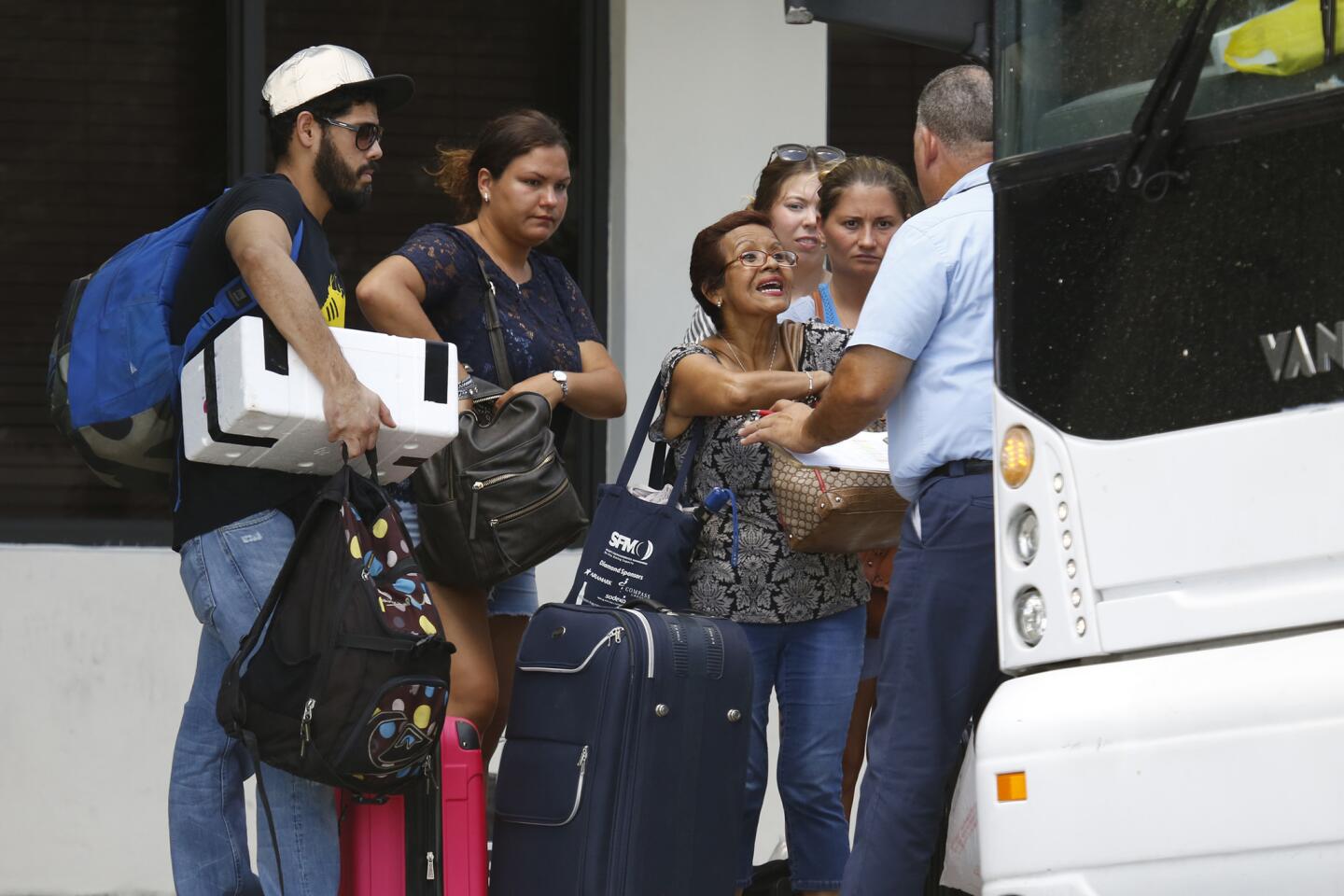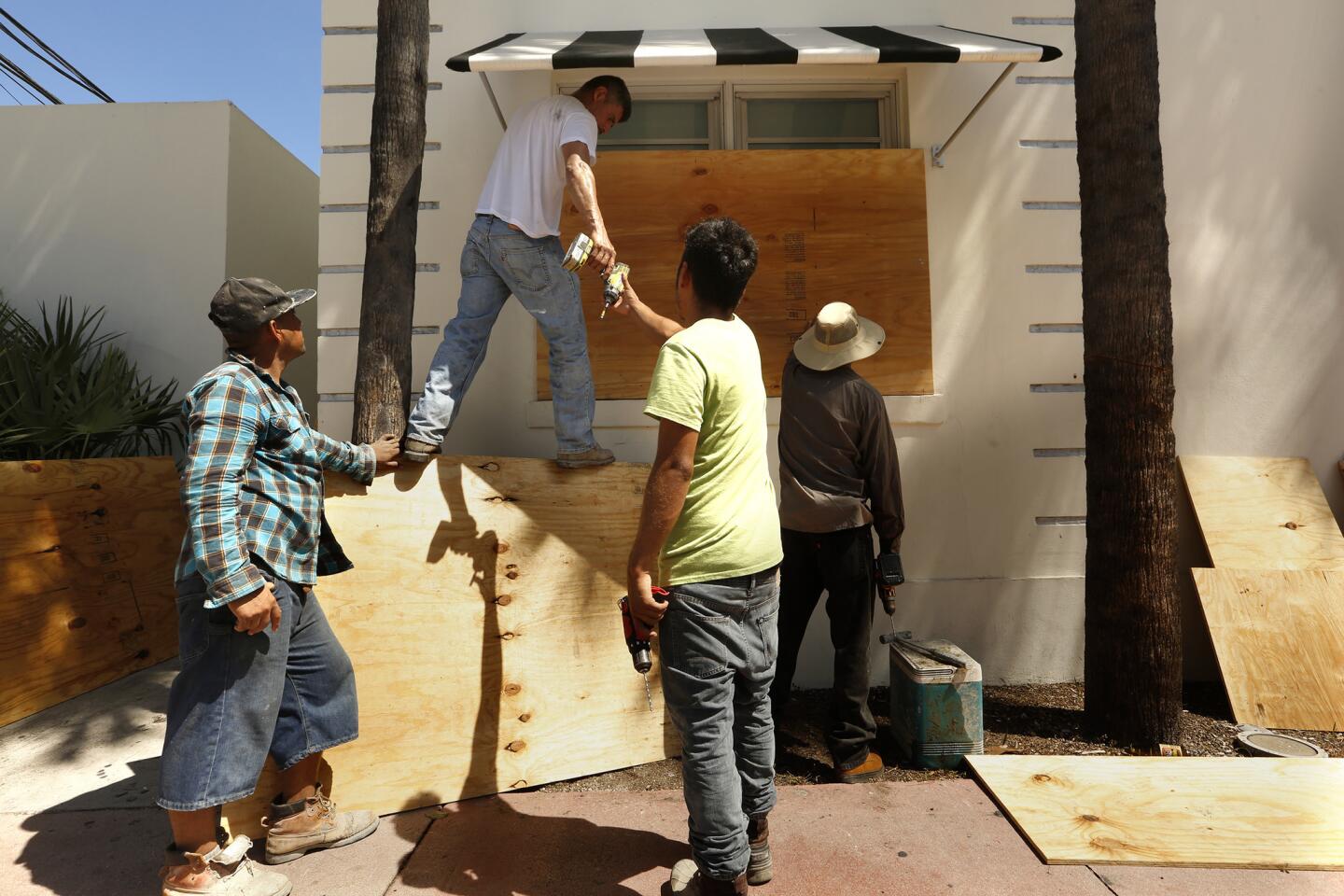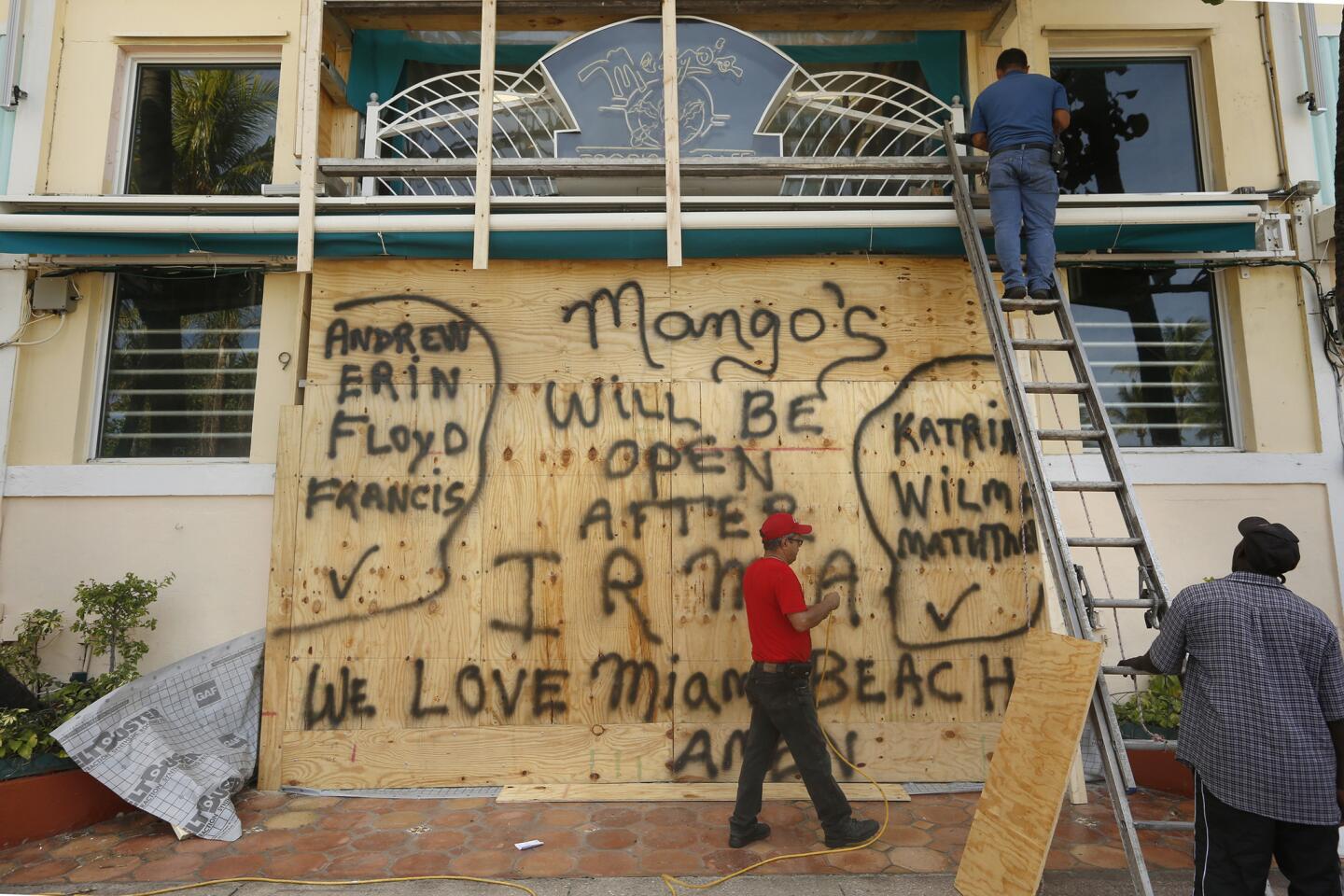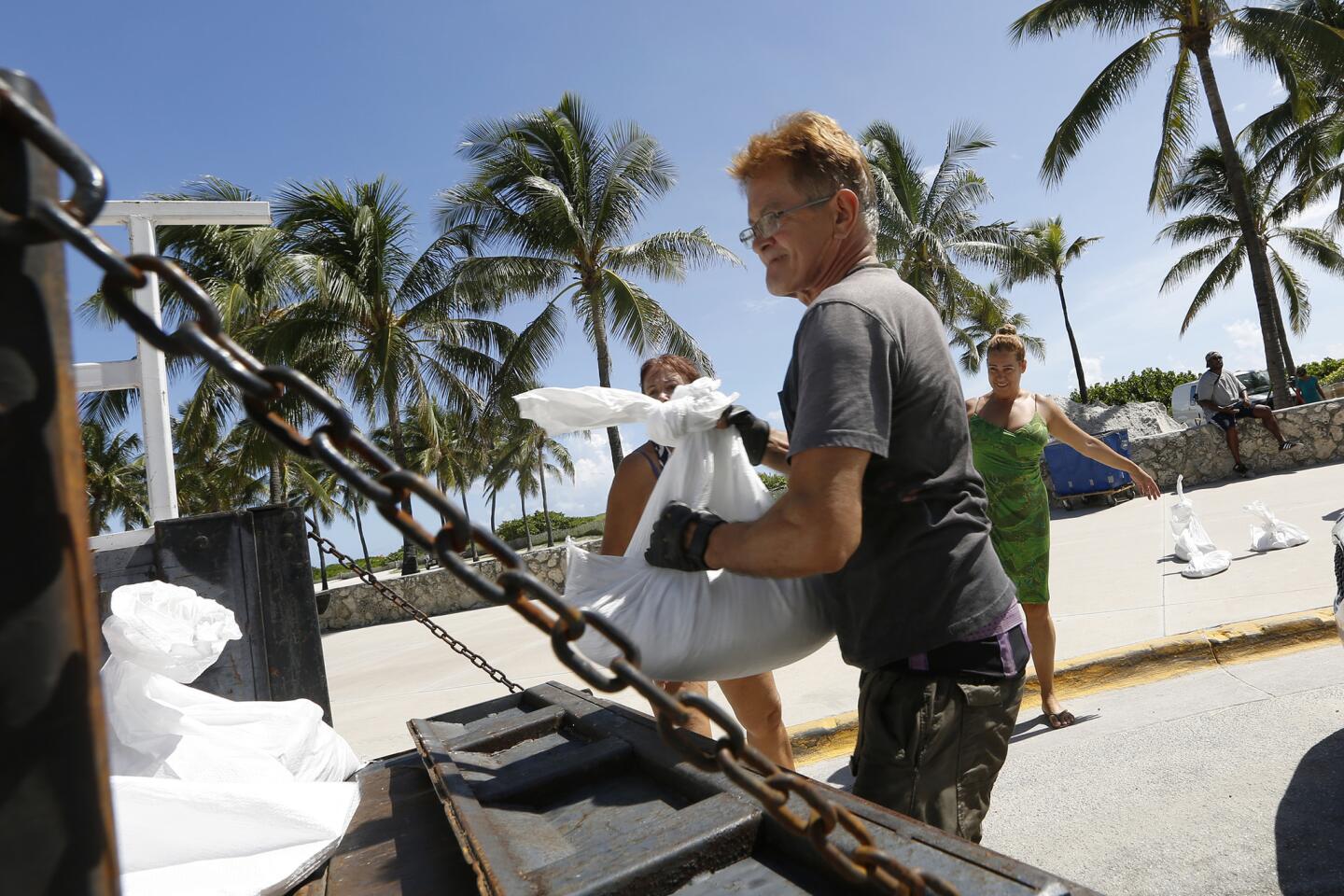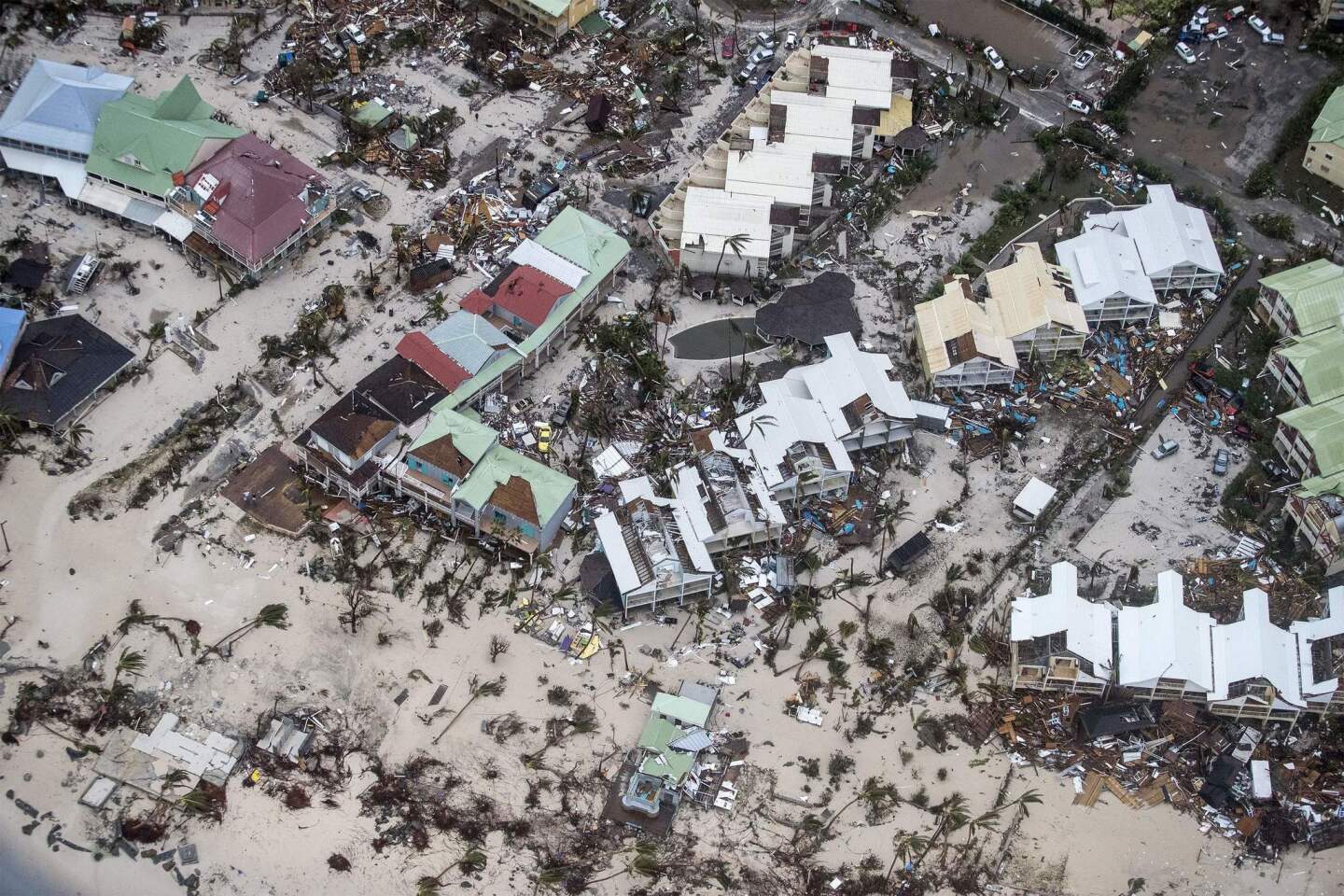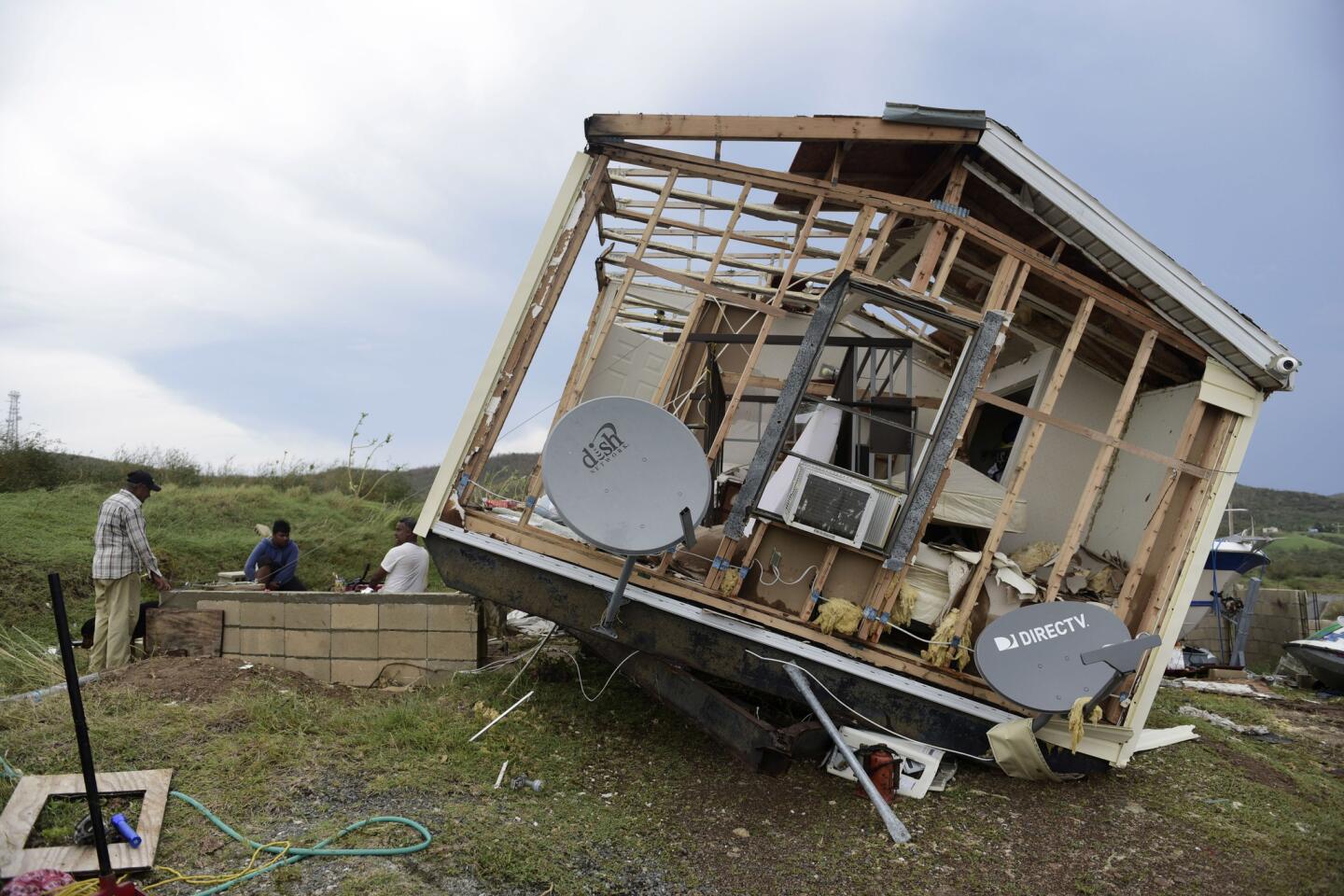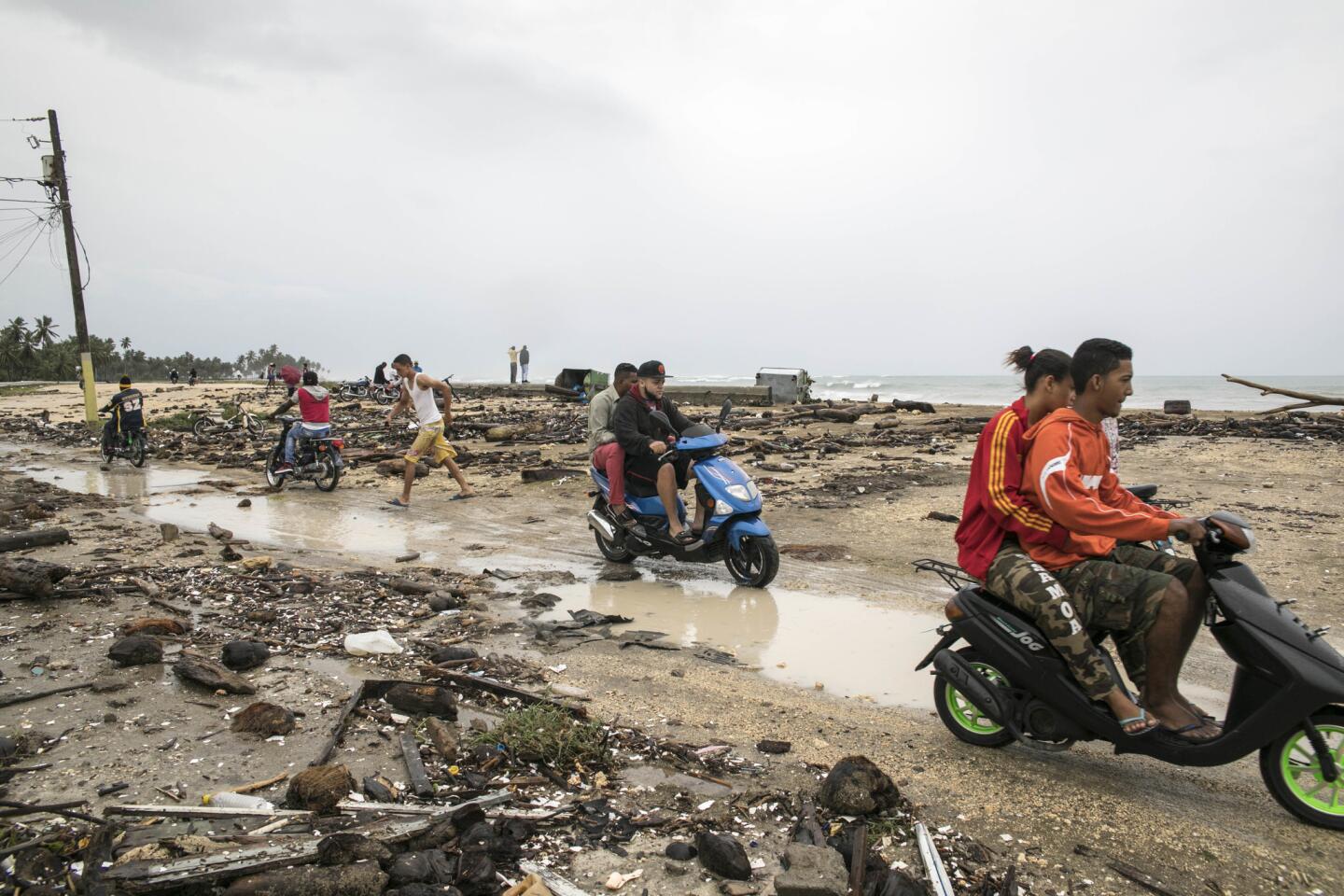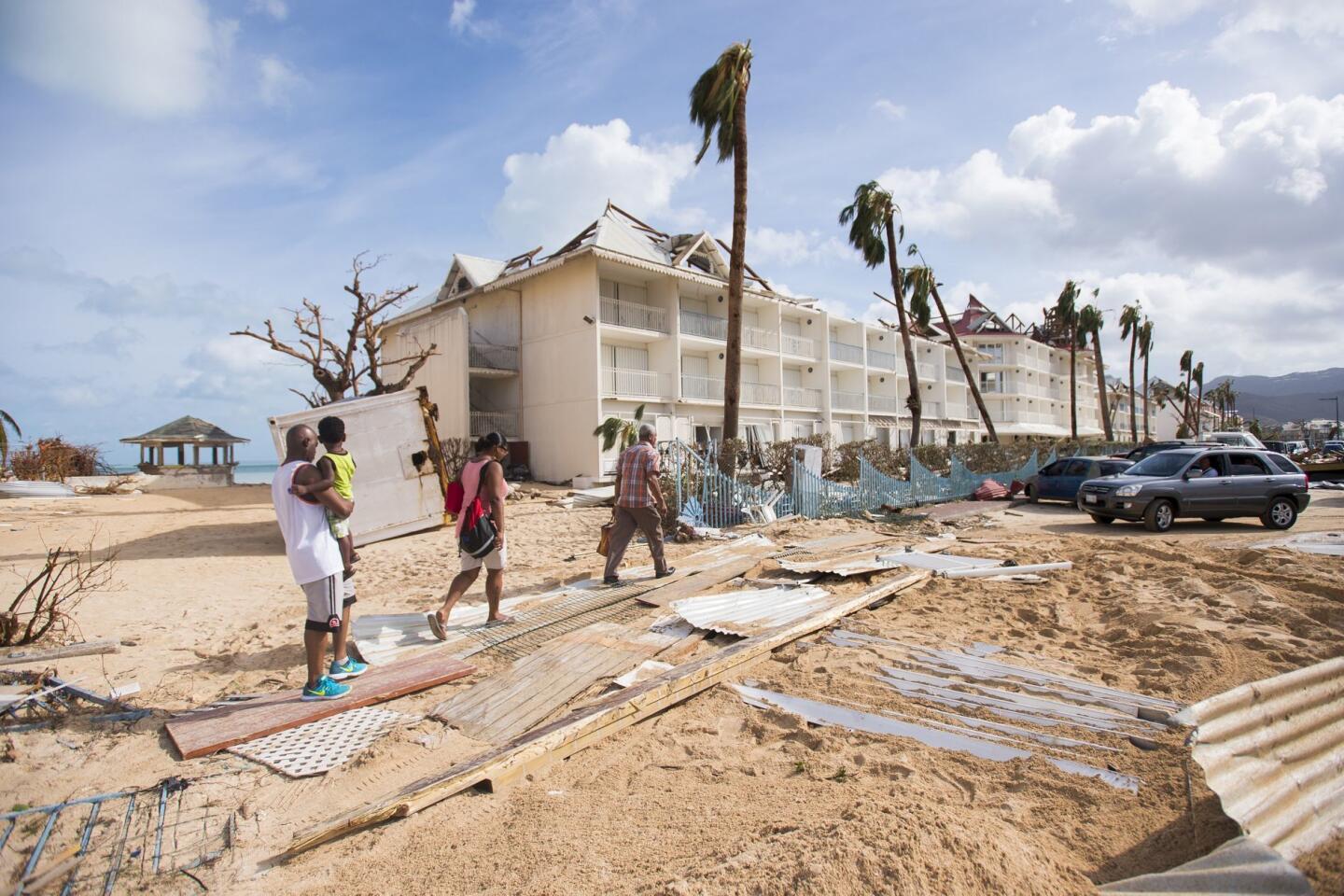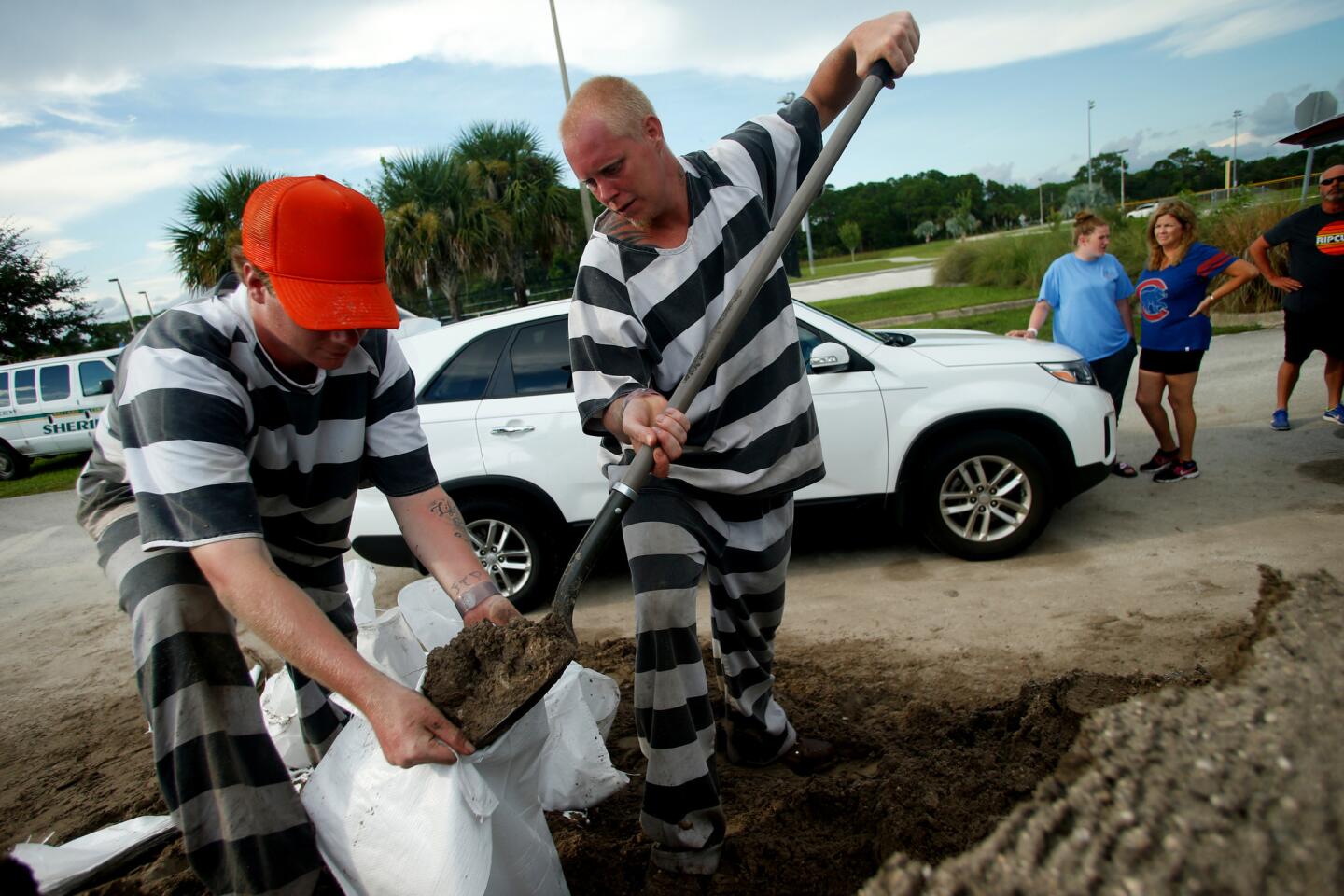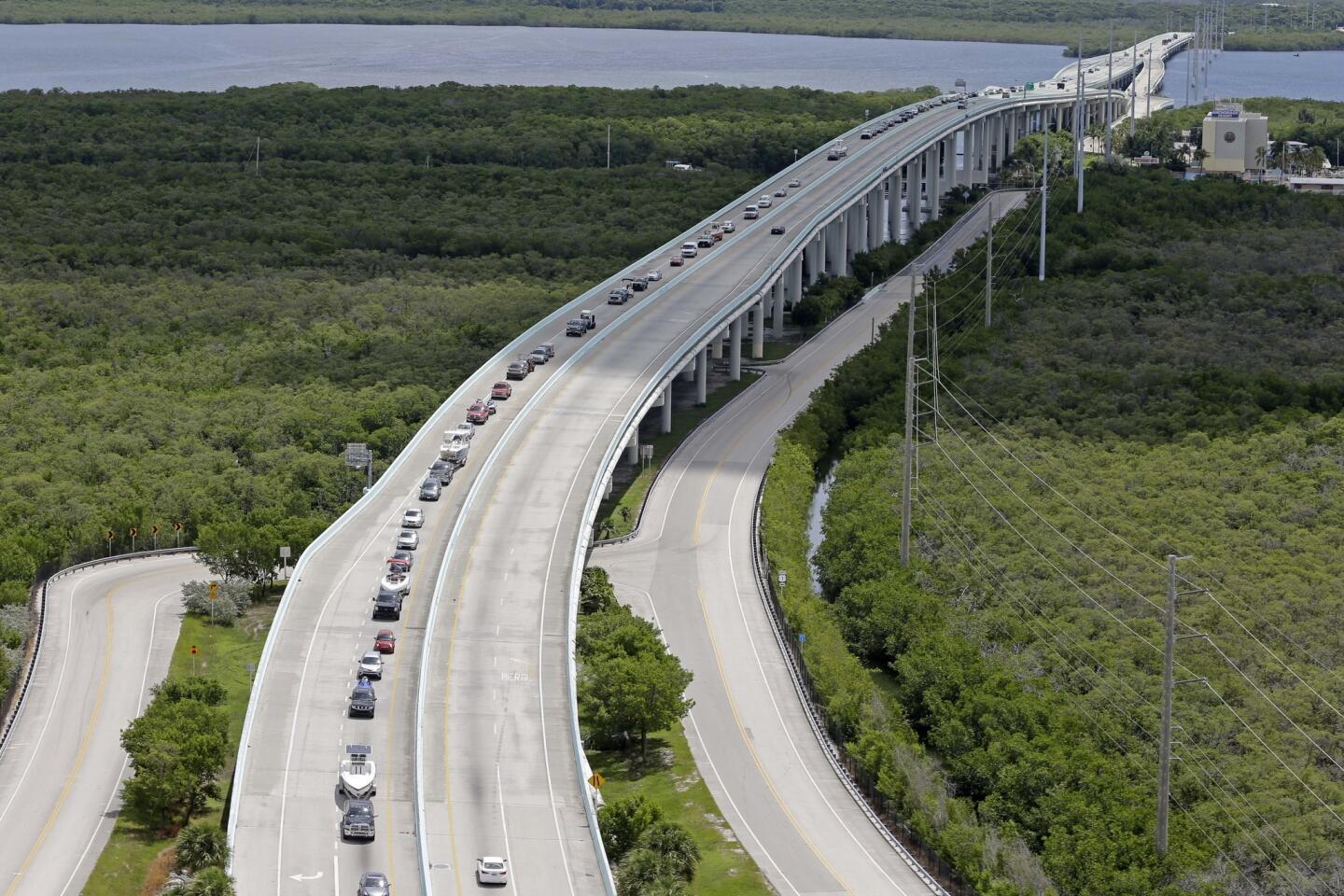Reporting from Miami — Hurricane Irma took aim at South Florida on Thursday, threatening millions with historic winds, huge storm surges and unrelenting rainfall as it left behind a trail of still-uncharted devastation in the Caribbean and a death toll that climbed to at least 13.
As the monster Category 5 storm tracked west-northwest with 175-mph winds, the caprices of wind and water saved impoverished Haiti and the Dominican Republic from a direct hit. But Irma bore down late Thursday on other Caribbean targets: the low-lying Turks and Caicos, and parts of the Bahamas.
Meanwhile, the peril to the U.S. mainland grew.
“It has become more likely that Irma will make landfall in southern Florida as a dangerous major hurricane, and bring life-threatening storm surge and wind impacts to much of the state,” the National Hurricane Center said.
With South Florida under a hurricane watch, Philip Levine, the mayor of vulnerable barrier-island Miami Beach, called Irma a “nuclear hurricane.” Irma’s leading edge was expected to reach Florida as soon as Saturday, and Gov. Rick Scott spoke of a “catastrophic storm that our state has never seen.”
The hurricane has left a string of small, devastated Caribbean islands counting their dead and struggling to restore links to the outside world. Chaotic conditions hampered efforts to compile a fatality toll, which officials said reached at least 13 and would probably grow.
Three people died in the U.S. Virgin Islands and three more in Puerto Rico, their respective governors said, and the Netherlands government confirmed a fatality in St. Maarten, the shattered Dutch side of the island it shares with St. Martin, a French territory. French officials, however, revised downward from eight to four the number of people confirmed dead on the French side.
As the storm passed Puerto Rico, it dealt the U.S. territory what was in meteorological terms a glancing blow, but one that landed like a stunning punch, exacerbated by already faltering infrastructure. The governor, Ricardo Rossello, reported that a million people were left without power, and the National Weather Service in San Juan warned of flash-flooding danger from swollen rivers.
Irma’s howling winds weakened slightly to 175 mph as the eye passed to the north of the Dominican Republic and Haiti. But even a sideswipe by such a intense storm carried devastating power. Hispaniola, the island the two countries share, was lashed by gales and torrential rains.
In the north of Haiti, where a hurricane last year killed some 900 people, many learned of government evacuation orders only from neighbors or relatives. Frightened people in the country’s north cut branches from trees to try to shore up roofs, said Mishelle Mitchell of the humanitarian group World Vision, who was in the capital, Port-au-Prince.
1/10
An aerial photo shows the damage of Hurricane Irma in Philipsburg, St. Maarten.
(Gerben Van Es / AFP/Getty Images) 2/10
People walk through damage in a sand-covered street of Marigot, near the Bay of Nettle, on the island of Saint-Martin after the passage of Hurricane Irma.
(Lionel Chamoiseau / AFP/Getty Images) 3/10
A man surveys the wreckage on his property after the passing of Hurricane Irma, in St. John’s, Antigua and Barbuda. Heavy rain and 185-mph winds lashed the Virgin Islands and Puerto Rico’s northeast coast.
(Johnny Jno-Baptiste / Associated Press) 4/10
People recover broken parts of the dock after the passing of Hurricane Irma, in St. John’s, Antigua and Barbuda.
(Johnny Jno-Baptiste / Associated Press) 5/10
Rescue staff from the Municipal Emergency Management Agency investigate an empty flooded car during the passage of Hurricane Irma through the northeastern part of Puerto Rico.
(Carlos Giusti / Associated Press) 6/10
Julio Feliciano, left, and Adrian Colon tour the streets of the Matelnillo community searching for citizens in distress during the passage of Hurricane Irma through the northeastern part of Puerto Rico.
(Carlos Giusti / Associated Press) 7/10
Sylvia Lamzo, 69, sits on a folding bed at an emergency center as Hurricane Irma approaches Puerto Rico.
(Ricardo Arduengo / AFP/Getty Images) 8/10
Photo of flooded streets on the Caribbean island of Saint-Martin.
(Rinsy Xieng / AFP/Getty Images) 9/10
Fishermen move a boat inland as Hurricane Irma approaches Haiti.
(Hector Retamal / AFP/Getty Images) 10/10
A boy puts chickens inside his house before the arrival of Hurricane Irma in Haiti.
(Hector Retamal / AFP/Getty Images) In South Florida, home to some 6 million people, flight from the mighty storm that was bearing down turned chaotic at times, with the state’s two main south-north arteries clogged with traffic and gasoline in short supply. Florida Highway Patrol troopers were trying to keep vehicles moving, towing disabled cars left by the roadside and escorting fuel trucks.
Florida lore is full of die-hards who ride out hurricanes, and defying a storm’s fury is romanticized in films like the 1948 noir classic “Key Largo.” But Scott, in a televised public briefing, pleaded with any holdouts in evacuation zones, especially in the Florida Keys, to obey orders to depart.
“Leave. Get out,” the governor said, addressing those who had been told to go. “We can’t save you once the storm starts.”
The Keys, where a mandatory evacuation order was in place, were emptying, with 31,000 people having departed as of Thursday morning, Scott said. An advisory evacuation was in place in Miami-Dade, the state’s most populous county, and the order was mandatory in low-lying areas.
The expanded evacuation zone, now encompassing about 700,000 people, covers downtown Miami and other parts of the city, plus southern parts of Miami-Dade County. It also included Homestead, Coral Gables, South Miami, Miami Shores and North Miami Beach, authorities said.
In Miami Beach, jogger Andrea Ratkovic, 51, was preparing to head home to Oklahoma after the storm scrapped a planned trip to Barbados. First, though, she took a break from her run to help a sandbag-filling crew.
She could sympathize with what Floridians faced, she said, after living through tornadoes back home with terrifyingly high winds.
“There is little you can do to prepare for those,” Ratkovic said. “You just have to run like a bug underground.”
While the storm’s track remained uncertain, a widening area braced for its effects. North Carolina Gov. Roy Cooper issued a statewide emergency declaration on Thursday, a day after South Carolina did so.
President Trump was briefed in the Oval Office about storm preparations and Irma’s projected path. Earlier, he tweeted a reminder to those in Irma’s path to “be careful, be safe,” as the storm approaches.
As Thursday dawned, daylight harshly illuminated the storm’s destructive rampage through the hardest-hit eastern Caribbean islands, many with colonial links to Western European countries.
Boats were tossed onto land. Electrical wires dangled. Streets had turned to rivers. Structures were splintered, with doors and shutters leaning at crazy angles.
“It’s an enormous disaster — 95% of the island is destroyed,” Daniel Gibbs, chairman of a local council on the French-Dutch island of St. Martin, told Radio Caribbean International.
France’s interior minister, Gerard Collomb, told French radio that more dead and injured were likely to be discovered as authorities “explore all the shores.”
A Dutch warship has arrived at St. Maarten, the Netherlands’ military said. The Dutch interior minister, Ronald Plasterk, who confirmed at least one death, said there could be more casualties.
Dutch Prime Minister Mark Rutte earlier said preliminary assessments had painted a bleak picture of the storm’s aftermath.
“There is no power, no gasoline, no running water,” Dutch media quoted him as saying. “Houses are underwater, cars are floating in the streets, and people are sitting in the dark, in ruined houses, cut off from the outside world.”
The independent island nation of Antigua and Barbuda reported overwhelming destruction on Barbuda, with 90% of buildings damaged or destroyed and one death reported. Prime Minister Gaston Browne, speaking to the BBC, called it “total carnage.”
Britain was dispatching two warships and hundreds of troops to aid people in its territories, including the British Virgin Islands and Turks and Caicos.
France’s president, Emmanuel Macron, who had predicted a “harsh” ultimate toll in his nation’s Caribbean territories, used the occasion to call attention to the dangers of global warming.
Macron, on an official trip to Greece, said he would visit the hurricane-ravaged French territories as soon as weather permitted.
Meanwhile, another Caribbean storm was lining up behind this one: Hurricane Jose, which has grown into a Category 2 storm. Those covered by a hurricane watch include some of the same islands battered by Irma.
1/79
Trailer homes at the Sea Breeze trailer park in the Florida Keys town of Islamorada were destroyed by Irma.
(Marcus Yam / Los Angeles Times) 2/79
Tom Ross inspects the damage to his three-story condominium building in Islamorada.
(Marcus Yam / Los Angeles Times) 3/79
The remains of a boat in Islamorada.
(Marcus Yam / Los Angeles Times) 4/79
Brooke Gilbert, 15, and her father, Mike Gilbert, look at the ruins of her grandparents’ condominium building in Islamorada.
(Marcus Yam / Los Angeles Times) 5/79
Laura Gilbert retrieves the mailbox from her father’s condominium in Islamorada after it was swept away during the storm.
(Marcus Yam / Los Angeles Times) 6/79
Sand and debris block access to trailer homes in Islamorada.
(Marcus Yam / Los Angeles Times) 7/79
Greg Garner embraces neighbor Linda Nettles in front of his longtime family home that lost part of its roof after Tropical Storm Irma hit Sullivan’s Island, S.C.
(Mic Smith / Associated Press) 8/79
Israel Alvarado, 25, tries to open a gate blocked by fallen tree branches to retrieve a generator in Bonita Springs.
(Carolyn Cole / Los Angeles Times) 9/79
Rescue workers help a couple evacuate their flooded home in Jacksonville.
(John Raoux / Associated Press) 10/79
Charlotte Glaze, left gives Donna Lamb a hug as she floats out some of her belongings in floodwaters in Jacksonville,.
(Dede Smith / Associated Press) 11/79
Ron Colby, 70, leaves his flooded Bonita Springs home after staying during Hurricane Irma. He said he was OK with the wind but that at 3:30 in the morning the water started to rise.
(Carolyn Cole / Los Angeles Times) 12/79
A dresser floats by Gilberto Diaz in his Bonita Springs neighborhood. Originally from Guatemala, Diaz has lived in Florida since 1994.
(Carolyn Cole / Los Angeles Times) 13/79
In Bonita Springs, floodwaters reached waist deep in some areas on Monday, flooding homes and cars.
(Carolyn Cole / Los Angeles Times) 14/79
A block from the ocean in Naples, the water was still a foot deep from storm surge. Homeowner Terry Clontz put up a “no wake” sign because people were driving by too fast, pushing water farther onto his property.
(Carolyn Cole / Los Angeles Times) 15/79
Floodwaters surround a marina in Key Largo on Monday following Hurricane Irma.
(Wilfredo Lee / Associated Press) 16/79
Mobile homes in Key Largo, Fla., lie in ruins on Monday after Hurricane Irma.
(Wilfredo Lee / Associated Press) 17/79
Floodwaters surround Gilbert’s Resort in Key Largo on Monday.
(Wilfredo Lee / Associated Press) 18/79
Kelly McClenthen returns to see the flood damage to her home with her boyfriend, Daniel Harrison, in the aftermath of Hurricane Irma in Bonita Springs, Fla.
(Gerald Herbert / Associated Press) 19/79
Terry Thompson is relieved. He rode out the storm in his home in Riverwood Estates in Naples. Although the Naples area of Florida was hit hard by Hurricane Irma, damage wasn’t nearly as bad as anticipated.
(Carolyn Cole / Los Angeles Times) 20/79
A woman leaves her flooded home the morning after Hurricane Irma swept through the area in Fort Myers, Florida.
(Spencer Platt / Getty Images) 21/79
People tend to a car that flipped over on Cape Coral Parkway during Hurricane Irma, in Cape Coral.
(Gerald Herbert / AP) 22/79
A man clears the drain next to his house in Estero, Fla., during the lull in winds as the eye of the hurricane passes over.
(Carolyn Cole / Los Angeles Times) 23/79
Evacuees use flashlights so others can maneuver around the stairway at Hampton Inn and Suites in Estero, Fla.
(Carolyn Cole / Los Angeles Times) 24/79
Guests gather in the lobby of Hampton Inn and Suites in Estero, Fla., to watch the hurricane gusts.
(Carolyn Cole / Los Angeles Times) 25/79
Darla Talia Ferro, 40, and her two parakeets ride out Hurricane Irma in the lobby of Hampton Inn and Suites in Estero, Fla.
(Carolyn Cole / Los Angeles Times) 26/79
John Krowzow, 74, wades in floodwater to check out his homes in Corkscrew Woodlands, a park with 640 senior mobile home units in Estero, Fla.
(Carolyn Cole / Los Angeles Times) 27/79
Peter Moodley wades through floodwater in downtown Miami.
(Marcus Yam / Los Angeles Times) 28/79
Two men walk through a downed tree as Hurricane Irma’s full force strikes Miami.
(Marcus Yam / Los Angeles Times) 29/79
A woman films the damage from a house whose roof was blown off near downtown Miami.
(Marcus Yam / Los Angeles Times) 30/79
A vehicle drives through debris caused by Hurricane Irma, in Miami.
(Marcus Yam / Los Angeles Times) 31/79
Weather reporters in downtown Miami jump and cling on to illustrate the force of the winds caused by Hurricane Irma.
(Marcus Yam / Los Angeles Times) 32/79
Weather reporters do a stand-up as the force of the winds caused by Hurricane Irma hit Miami.
(Marcus Yam / Los Angeles Times) 33/79
A cargo truck is tipped over by the wind caused by Hurricane Irma in Miami.
(Marcus Yam / Los Angeles Times) 34/79
Storm surge floods the Brickell neighborhood of Miami.
(Marcus Yam / Los Angeles Times) 35/79
Streets are empty in downtown Miami as the wind picks up speed during Hurricane Irma’s approach.
(Marcus Yam / Los Angeles Times) 36/79
Maria Koenig, 63, of Estero, Fla., and her dog, Baeley, sit by the window at their Estero hotel so Maria can keep an eye on the storm on Sunday.
(Carolyn Cole / Los Angeles Times) 37/79
Glen Sinatra, 69, from Naples, says he feels lucky to be at a hotel in Estero instead of a shelter. He’s nervous about the storm and says he’s trying not to worry his children about the conditions.
(Carolyn Cole / Los Angeles Times) 38/79
Jimmy Alfano, of Ft. Myers, holds onto Alec Hoskins who is autistic, while watching the storm gusts through the window of their Estero hotel with Frank Pairs.
(Carolyn Cole / Los Angeles Times) 39/79
A car sits abandoned in storm surge along North Fort Lauderdale Beach Boulevard as Hurricane Irma hits the southern part of the state.
(Chip Somodevilla / Getty Images) 40/79
The metal canopy at a gasoline station is overturned by high winds brought on by Hurricane Irma.
(Wilfredo Lee / Associated Press) 41/79
Youssef Ezzou, left, and Fadel Beznbachir roam outside to check out the conditions in Miami as Hurricane Irma nears the mainland.
(Marcus Yam / Los Angeles Times) 42/79
A construction crane whose arm broke off towers over a building as high wind blows through downtown Miami on Sunday.
(Marcus Yam / Los Angeles Times) 43/79
A man and woman run to safety in Miami as winds from Hurricane Irma bear down on Sunday.
(Marcus Yam / Los Angeles Times) 44/79
Storefronts in Miami are damaged as Hurricane Irma’s winds hit Miami.
(Marcus Yam / Los Angeles Times) 45/79
Dustin Terkoski, Palm Bay Police officer surveys the scene after a possible tornado touched down at Palm Pam Bay Estates.
(Red Huber / Orlando Sentinel) 46/79
A man braces against the wind by the Miami River on Sunday as water levels surge.
(Marcus Yam / Los Angeles Times) 47/79
A man stands by the Miami River as the water level surges on Sunday.
(Marcus Yam / Los Angeles Times) 48/79
The waves on the Miami River begin to surge Sunday as winds pick up speed upon Hurricane Irma’s approach.
(Marcus Yam / Los Angeles Times) 49/79
Brian Williams, of Maryland, fights the winds in downtown Fort Myers.
(Carolyn Cole / Los Angeles Times) 50/79
Trees fall as winds pick up speed early Sunday as Hurricane Irma approaches Miami.
(Marcus Yam / Los Angeles Times) 51/79
A TV reporter braces against the wind as Hurricane Irma approaches Miami.
(Marcus Yam / Los Angeles Times) 52/79
The outer bands of Hurricane Irma start to reach Florida on Saturday, with clouds over the Miami skyline.
(Joe Raedle / Getty Images ) 53/79
People wade through a flooded street in Havana after Hurricane Irma battered central Cuba.
(YAMIL LAGE / AFP/Getty Images) 54/79
Thousands wait Saturday to enter a storm shelter set up at Germain Arena in Estero, Fla., south of Fort Myers.
(Carolyn Cole / Los Angeles Times) 55/79
Jean Turner, 79, waits to get into a shelter with a few of her belongings as rain begins to fall Saturday in Estero, Fla.
(Carolyn Cole / Los Angeles Times) 56/79
Sherri Bourdo, 32, and Anthony Guidry, 40, look out over the water in Naples, Fla, in advance of the arrival of Hurricane Irma.
(Carolyn Cole / Los Angeles Times) 57/79
Lisette Toroella and Tatiana Morera play on the beach as storm clouds approach in Miami Beach.
(Marcus Yam / Los Angeles Times) 58/79
Adam Todd, does a handstand while skateboarding down a virtually empty Ocean Drive in Miami Beach.
(Marcus Yam / Los Angeles Times) 59/79
Abby Jenkins walks against the wind with her luggage and umbrella to get to safety, in Miami Beach.
(Marcus Yam / Los Angeles Times) 60/79
James Sampero surfs in the churning ocean as Hurricane Irma approaches.
(Joe Raedle / Getty Images) 61/79
Cubans wade through the rubble from a collapsed building in Havana on Saturday.
(Yamil Lage / AFP/Getty Images) 62/79
A woman and child use a blanket as protection from wind and rain as they walk in Caibarien, Cuba. Hurricane Irma battered Cuba on Saturday with deafening winds and unremitting rain, pushing seawater inland and flooding homes before turning toward Florida.
(Desmond Boylan / Associated Press) 63/79
Annette Davis plays with her son Darius, 3, while staying at a shelter in Miami on Saturday after evacuating from their home in Florida City ahead of Hurricane Irma.
(David Goldman / Associated Press) 64/79
Residents walk through rain brought on by Hurricane Irma in Caibarien, Cuba. The powerful storm battered Cuba on Saturday and continued its march toward Florida.
(Desmond Boylan / Associated Press) 65/79
Palmetto Ridge High School is a shelter for people with special needs near Naples, Fla. Many seniors plan to ride out the storm there.
(Carolyn Cole / Los Angeles Times) 66/79
Francesca DeLuca, age 20, will be waiting for 10 hours for her flight back to Milan, Italy. She had been visiting a friend in Miami by herself, but the area where she was staying is under mandatory evacuation. At Miami International Airport, the last flights will be this afternoon with the airport closing tonight at 6pm. Most travelers are taking flights to anywhere they can find.
(Carolyn Cole / Los Angeles Times) 67/79
Boats that can’t be evacuated are tied off in canals to protect them from Hurricane Irma on in Key Largo, Florida. The entire Florida Keys are under a mandatory evacuation notice as Hurricane Irma approaches the low-lying chain of islands south of Miami.
(Marc Serota / Getty Images) 68/79
Hundreds wait in line on Friday at Home Depot in Miami to get supplies line sheets of plywood, and anything else they can find, to board up their homes. Police were on the scene to keep things orderly.
(Carolyn Cole / Los Angeles Times) 69/79
In the Little Haiti neighborhood of Miami, Fritz Drinks, whose family is from Haiti, helps load sandbags at Little Haiti Hardware and Lumber. Many people in the area are refusing to evacuate in advance of Hurricane Irma.
(Carolyn Cole / Los Angeles Times) 70/79
In downtowm Miaimi, people wait to get on a bus headed to Orlando under a mandatory evacution plan. Preparations are underway for Hurricane Irma as the storm makes its way toward Florida.
(Carolyn Cole / Los Angeles Times) 71/79
Stores are boarded up in Miami Beach in advance of Hurricane Irma.
(Carolyn Cole / Los Angeles Times) 72/79
Preparations for Hurricane Irma are underway in Miami Beach as the storm makes its way toward Florida.
(Carolyn Cole / Los Angeles Times) 73/79
Genaro Dacosta, 65, of Miami Beach loads sandbags in advance of Hurricane Irma. He says he can’t evacuate the area because he has a monkey.
(Carolyn Cole / Los Angeles Times) 74/79
An aerial photograph taken and released by the Dutch Department of Defense on Wednesday shows damage from Hurricane Irma in Philipsburg, St. Maarten.
(Gerben van Es / AFP/Getty Images) 75/79
Juan Negron, third from left, prepares to start up a power generator in front of what’s left of his damaged property in Culebra, Puerto Rico, after the passage of Hurricane Irma.
(Carlos Giusti / Associated Press) 76/79
Residents come out to survey the damage caused by Hurricane Irma in Nagua, Dominican Republic.
(Tatiana Fernandez / Associated Press) 77/79
People on Thursday look over damage from Hurricane Irma on a sand-covered street of Marigot, near the Bay of Nettle, on the island of St. Maarten.
(Lionel Chamoiseau / AFP/Getty Images) 78/79
Inmate trustees from the Brevard County Jail fill sandbags for Meritt Island, Fla., residents in advance of Hurricane Irma.
(Brian Blanco / Getty Images) 79/79
Motorists leave Key Largo, Fla., ahead of Hurricane Irma.
(Alan Diaz / Associated Press) Staff writer Halper reported from Miami and staff writer King from Washington. Special correspondent Les Neuhaus contributed from Homestead, Fla.
ALSO
Airlines begin canceling flights in Hurricane Irma’s path
Deaths reported as Hurricane Irma rakes Caribbean, with Florida likely in crosshairs
A Houston woman camped out in a tent on her front lawn during Harvey to save her flooded home
UPDATES:
4:35 p.m.: This article was updated with additional comments and details as the hurricane heads for Florida.
2:04 p.m.: This article was updated with additional deaths in Puerto Rico and Saint Maarten, expanded evacuation orders in Miami, hurricane passing north of Haiti and Dominican Republica.
10:25 a.m.: This article was updated with additional details of damage in the Caribbean and about preparations in Florida.
9:43: This article was updated with fresh comment from Gov. Scott, urging people to obey evacuation orders, and storm preparations in Haiti.
8:40 a.m.: This article was updated with additional details, including the storm’s effects on Puerto Rico.
7:15 a.m.: This article was updated throughout with Times staff reporting.
3 a.m.: This article was updated with two additional deaths reported in the Caribbean.
This article was originally published at 1:55 a.m.
